The main goal of this risk assessment
VerifiedAdded on 2022/08/22
|43
|8757
|16
AI Summary
2000 report on risk assessment of a business, format for assignment in "NotesForFormat" , appendix must include the RA Form for the 6 risks, Example how to use in "RAFormSample".
Contribute Materials
Your contribution can guide someone’s learning journey. Share your
documents today.
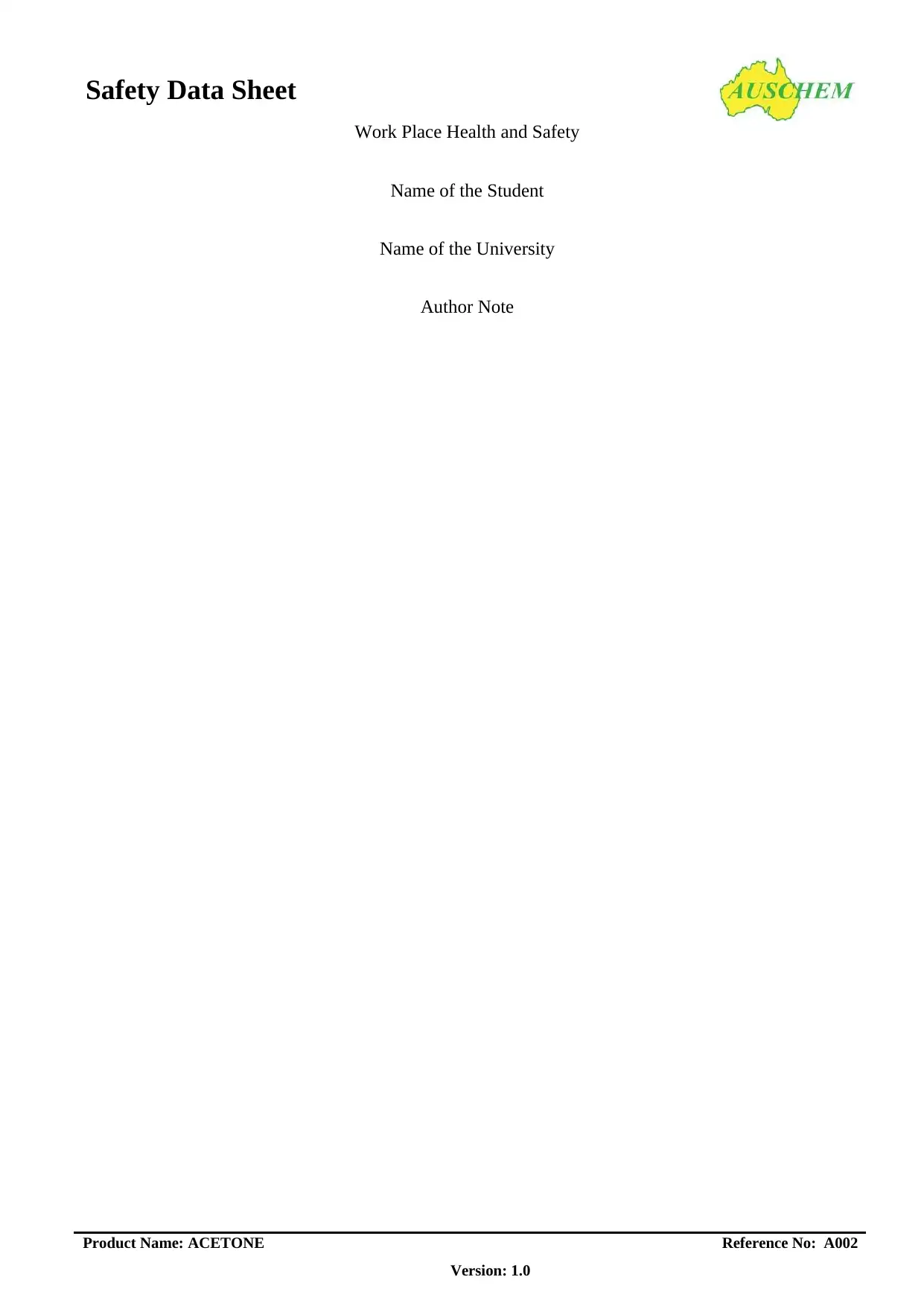
Safety Data Sheet
Product Name: ACETONE Reference No: A002
Version: 1.0
Work Place Health and Safety
Name of the Student
Name of the University
Author Note
Product Name: ACETONE Reference No: A002
Version: 1.0
Work Place Health and Safety
Name of the Student
Name of the University
Author Note
Secure Best Marks with AI Grader
Need help grading? Try our AI Grader for instant feedback on your assignments.
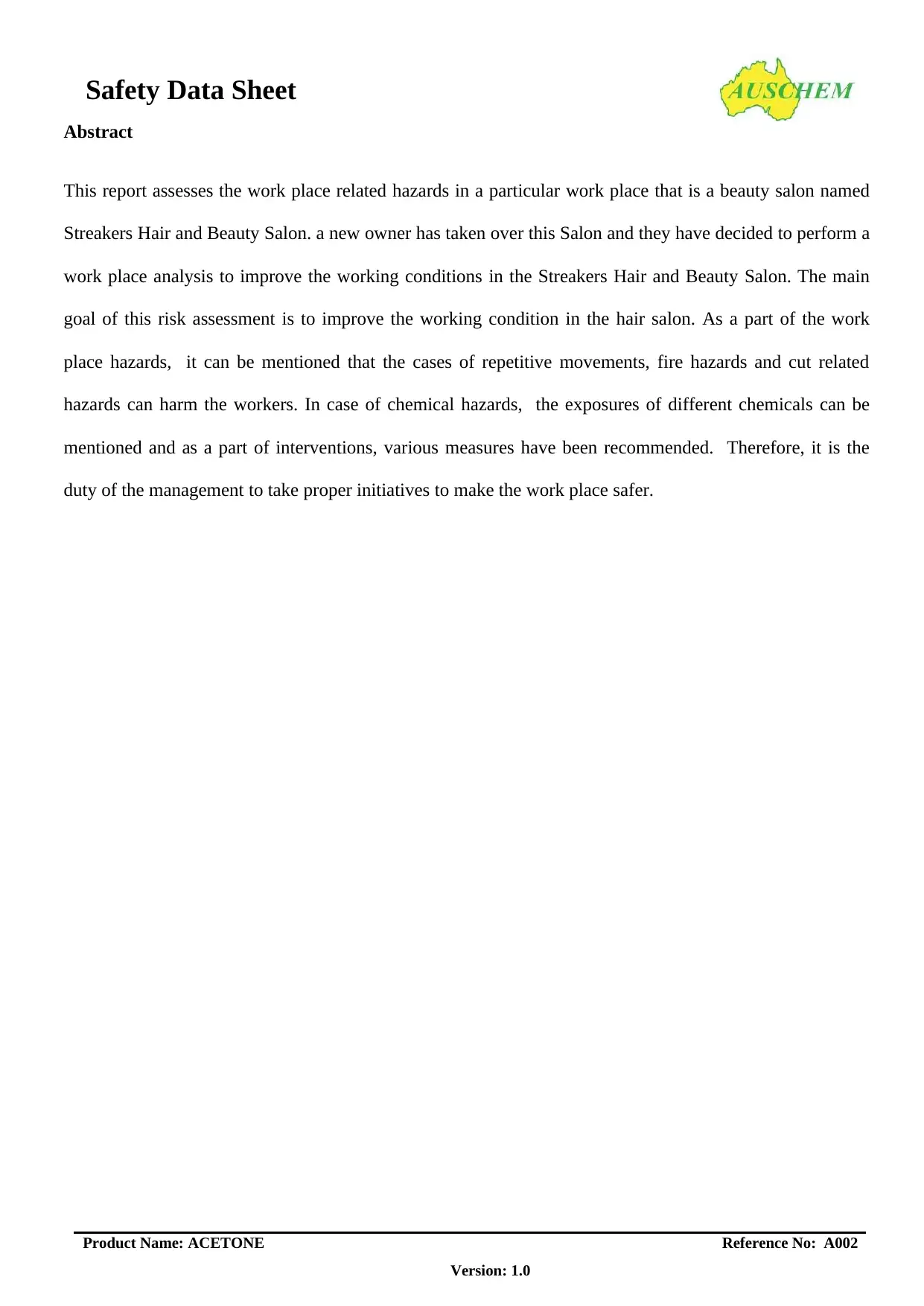
Safety Data Sheet
Product Name: ACETONE Reference No: A002
Version: 1.0
Abstract
This report assesses the work place related hazards in a particular work place that is a beauty salon named
Streakers Hair and Beauty Salon. a new owner has taken over this Salon and they have decided to perform a
work place analysis to improve the working conditions in the Streakers Hair and Beauty Salon. The main
goal of this risk assessment is to improve the working condition in the hair salon. As a part of the work
place hazards, it can be mentioned that the cases of repetitive movements, fire hazards and cut related
hazards can harm the workers. In case of chemical hazards, the exposures of different chemicals can be
mentioned and as a part of interventions, various measures have been recommended. Therefore, it is the
duty of the management to take proper initiatives to make the work place safer.
Product Name: ACETONE Reference No: A002
Version: 1.0
Abstract
This report assesses the work place related hazards in a particular work place that is a beauty salon named
Streakers Hair and Beauty Salon. a new owner has taken over this Salon and they have decided to perform a
work place analysis to improve the working conditions in the Streakers Hair and Beauty Salon. The main
goal of this risk assessment is to improve the working condition in the hair salon. As a part of the work
place hazards, it can be mentioned that the cases of repetitive movements, fire hazards and cut related
hazards can harm the workers. In case of chemical hazards, the exposures of different chemicals can be
mentioned and as a part of interventions, various measures have been recommended. Therefore, it is the
duty of the management to take proper initiatives to make the work place safer.
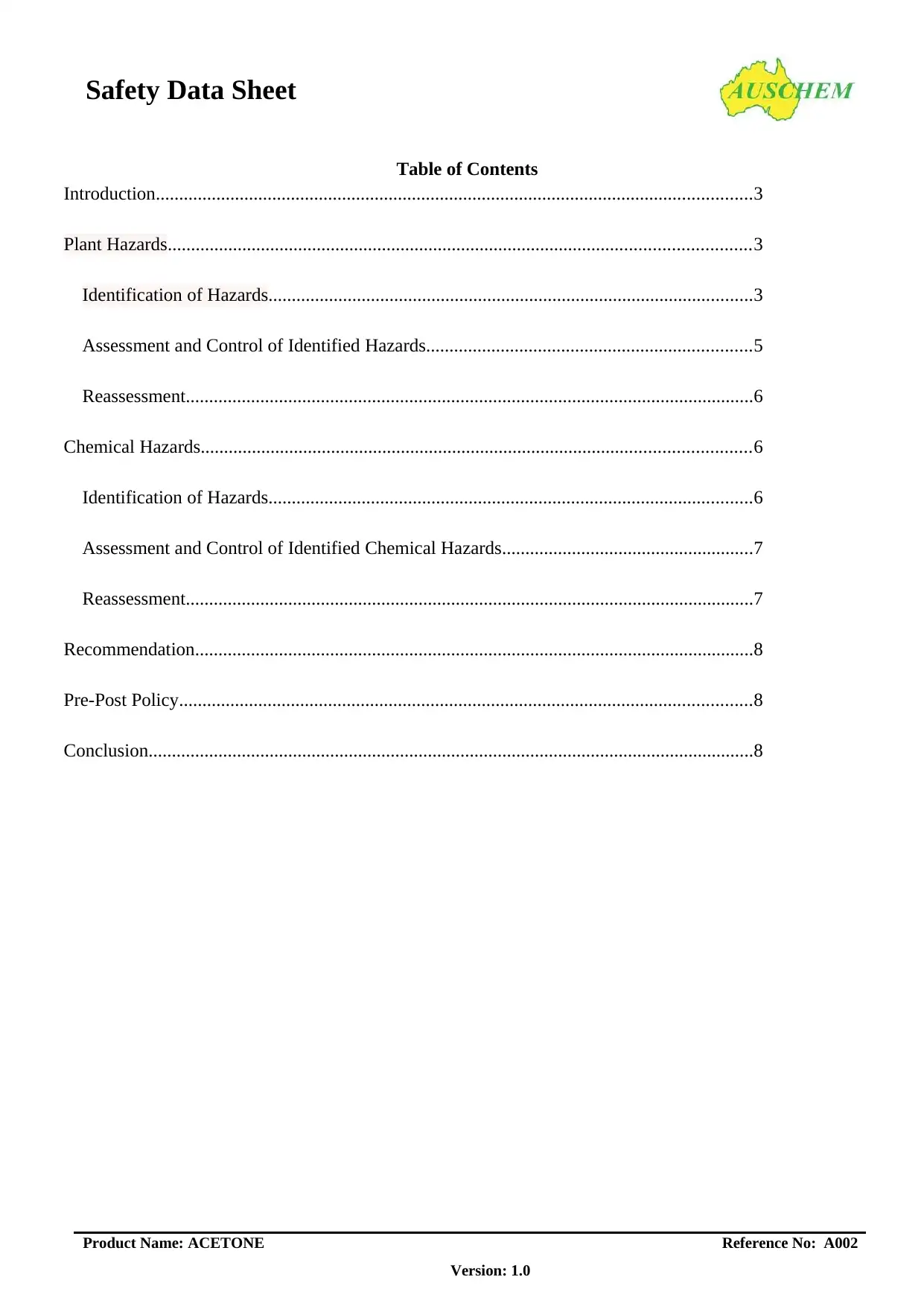
Safety Data Sheet
Product Name: ACETONE Reference No: A002
Version: 1.0
Table of Contents
Introduction................................................................................................................................3
Plant Hazards.............................................................................................................................3
Identification of Hazards........................................................................................................3
Assessment and Control of Identified Hazards......................................................................5
Reassessment..........................................................................................................................6
Chemical Hazards......................................................................................................................6
Identification of Hazards........................................................................................................6
Assessment and Control of Identified Chemical Hazards......................................................7
Reassessment..........................................................................................................................7
Recommendation........................................................................................................................8
Pre-Post Policy...........................................................................................................................8
Conclusion..................................................................................................................................8
Product Name: ACETONE Reference No: A002
Version: 1.0
Table of Contents
Introduction................................................................................................................................3
Plant Hazards.............................................................................................................................3
Identification of Hazards........................................................................................................3
Assessment and Control of Identified Hazards......................................................................5
Reassessment..........................................................................................................................6
Chemical Hazards......................................................................................................................6
Identification of Hazards........................................................................................................6
Assessment and Control of Identified Chemical Hazards......................................................7
Reassessment..........................................................................................................................7
Recommendation........................................................................................................................8
Pre-Post Policy...........................................................................................................................8
Conclusion..................................................................................................................................8
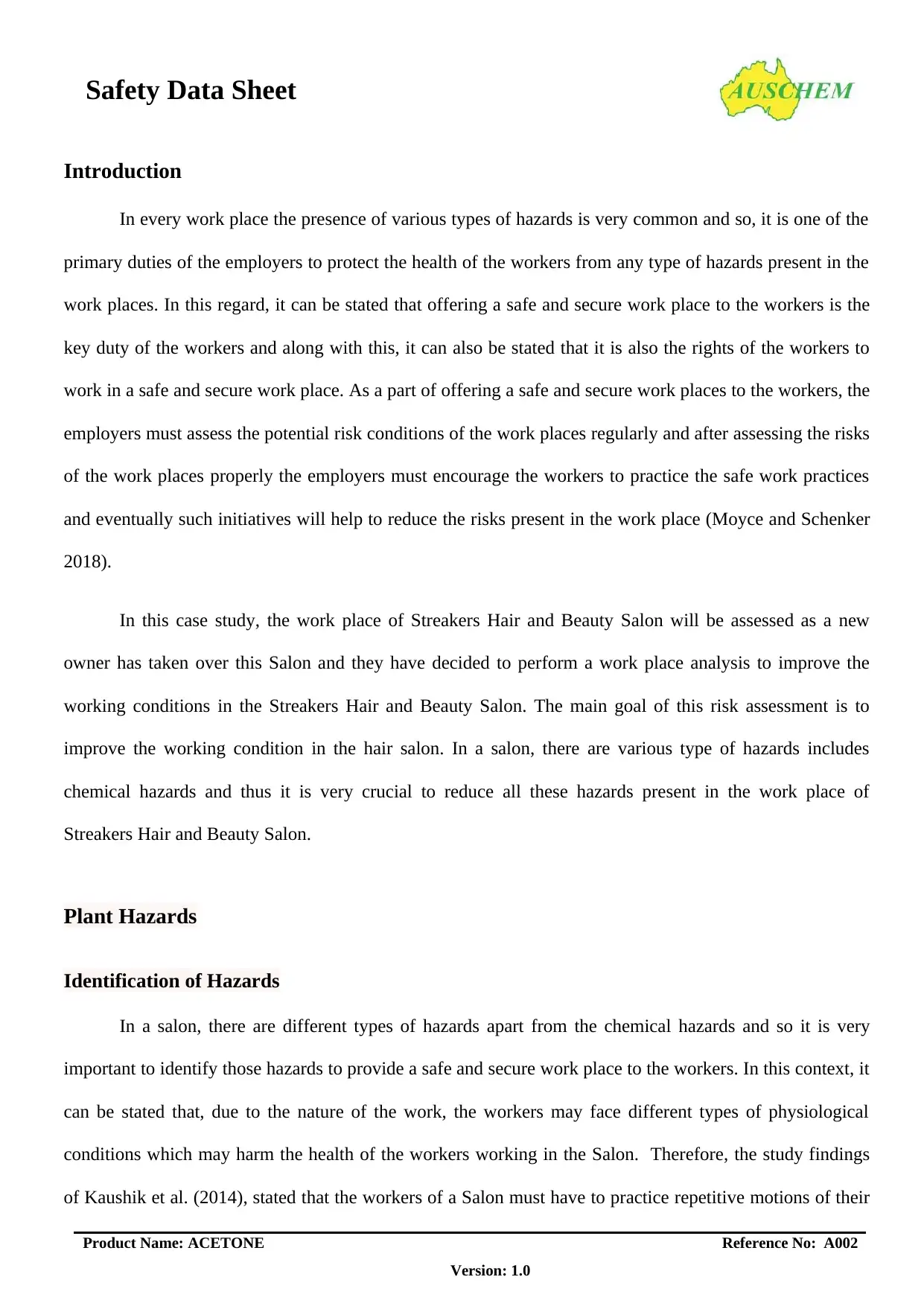
Safety Data Sheet
Product Name: ACETONE Reference No: A002
Version: 1.0
Introduction
In every work place the presence of various types of hazards is very common and so, it is one of the
primary duties of the employers to protect the health of the workers from any type of hazards present in the
work places. In this regard, it can be stated that offering a safe and secure work place to the workers is the
key duty of the workers and along with this, it can also be stated that it is also the rights of the workers to
work in a safe and secure work place. As a part of offering a safe and secure work places to the workers, the
employers must assess the potential risk conditions of the work places regularly and after assessing the risks
of the work places properly the employers must encourage the workers to practice the safe work practices
and eventually such initiatives will help to reduce the risks present in the work place (Moyce and Schenker
2018).
In this case study, the work place of Streakers Hair and Beauty Salon will be assessed as a new
owner has taken over this Salon and they have decided to perform a work place analysis to improve the
working conditions in the Streakers Hair and Beauty Salon. The main goal of this risk assessment is to
improve the working condition in the hair salon. In a salon, there are various type of hazards includes
chemical hazards and thus it is very crucial to reduce all these hazards present in the work place of
Streakers Hair and Beauty Salon.
Plant Hazards
Identification of Hazards
In a salon, there are different types of hazards apart from the chemical hazards and so it is very
important to identify those hazards to provide a safe and secure work place to the workers. In this context, it
can be stated that, due to the nature of the work, the workers may face different types of physiological
conditions which may harm the health of the workers working in the Salon. Therefore, the study findings
of Kaushik et al. (2014), stated that the workers of a Salon must have to practice repetitive motions of their
Product Name: ACETONE Reference No: A002
Version: 1.0
Introduction
In every work place the presence of various types of hazards is very common and so, it is one of the
primary duties of the employers to protect the health of the workers from any type of hazards present in the
work places. In this regard, it can be stated that offering a safe and secure work place to the workers is the
key duty of the workers and along with this, it can also be stated that it is also the rights of the workers to
work in a safe and secure work place. As a part of offering a safe and secure work places to the workers, the
employers must assess the potential risk conditions of the work places regularly and after assessing the risks
of the work places properly the employers must encourage the workers to practice the safe work practices
and eventually such initiatives will help to reduce the risks present in the work place (Moyce and Schenker
2018).
In this case study, the work place of Streakers Hair and Beauty Salon will be assessed as a new
owner has taken over this Salon and they have decided to perform a work place analysis to improve the
working conditions in the Streakers Hair and Beauty Salon. The main goal of this risk assessment is to
improve the working condition in the hair salon. In a salon, there are various type of hazards includes
chemical hazards and thus it is very crucial to reduce all these hazards present in the work place of
Streakers Hair and Beauty Salon.
Plant Hazards
Identification of Hazards
In a salon, there are different types of hazards apart from the chemical hazards and so it is very
important to identify those hazards to provide a safe and secure work place to the workers. In this context, it
can be stated that, due to the nature of the work, the workers may face different types of physiological
conditions which may harm the health of the workers working in the Salon. Therefore, the study findings
of Kaushik et al. (2014), stated that the workers of a Salon must have to practice repetitive motions of their
Secure Best Marks with AI Grader
Need help grading? Try our AI Grader for instant feedback on your assignments.
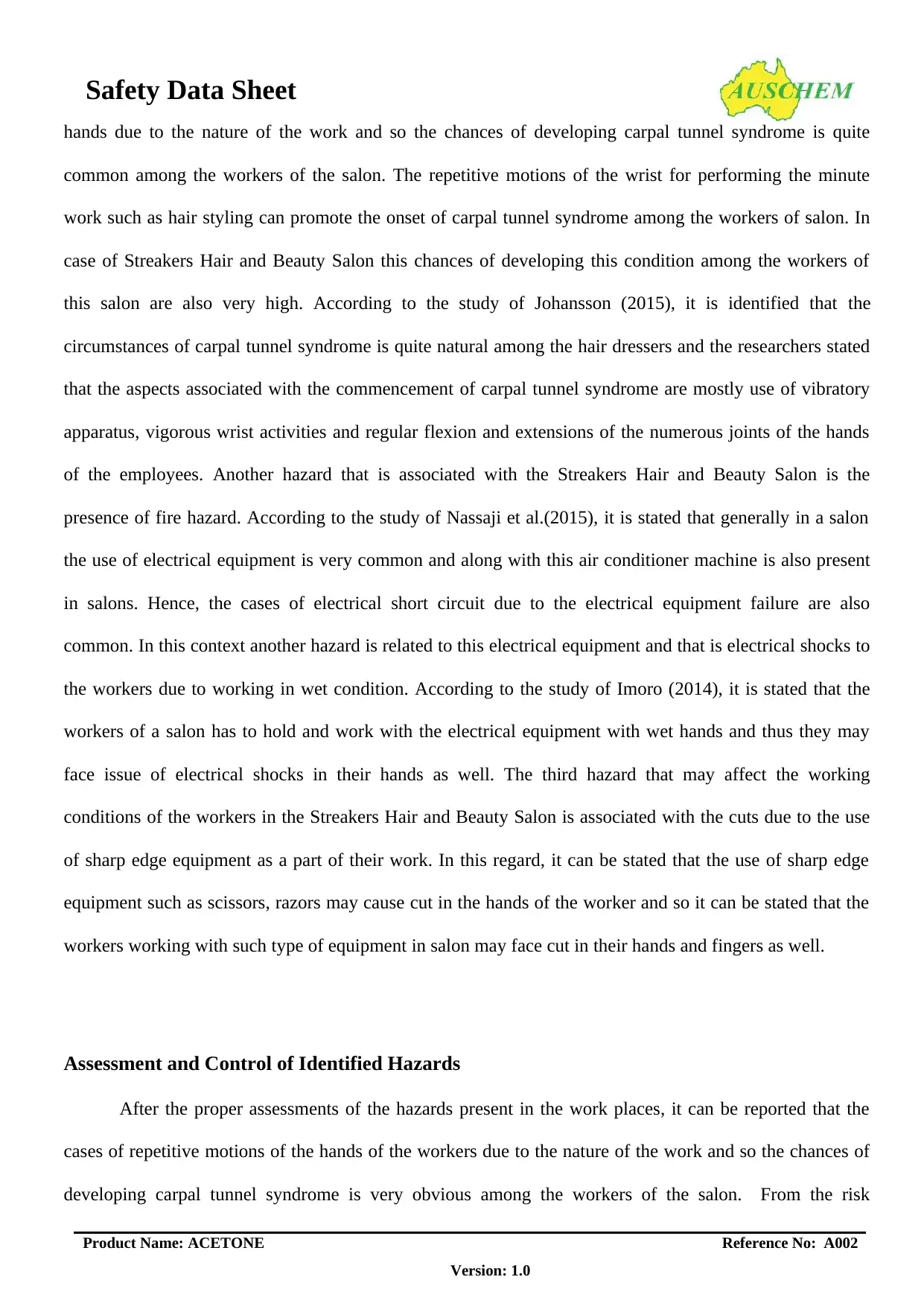
Safety Data Sheet
Product Name: ACETONE Reference No: A002
Version: 1.0
hands due to the nature of the work and so the chances of developing carpal tunnel syndrome is quite
common among the workers of the salon. The repetitive motions of the wrist for performing the minute
work such as hair styling can promote the onset of carpal tunnel syndrome among the workers of salon. In
case of Streakers Hair and Beauty Salon this chances of developing this condition among the workers of
this salon are also very high. According to the study of Johansson (2015), it is identified that the
circumstances of carpal tunnel syndrome is quite natural among the hair dressers and the researchers stated
that the aspects associated with the commencement of carpal tunnel syndrome are mostly use of vibratory
apparatus, vigorous wrist activities and regular flexion and extensions of the numerous joints of the hands
of the employees. Another hazard that is associated with the Streakers Hair and Beauty Salon is the
presence of fire hazard. According to the study of Nassaji et al.(2015), it is stated that generally in a salon
the use of electrical equipment is very common and along with this air conditioner machine is also present
in salons. Hence, the cases of electrical short circuit due to the electrical equipment failure are also
common. In this context another hazard is related to this electrical equipment and that is electrical shocks to
the workers due to working in wet condition. According to the study of Imoro (2014), it is stated that the
workers of a salon has to hold and work with the electrical equipment with wet hands and thus they may
face issue of electrical shocks in their hands as well. The third hazard that may affect the working
conditions of the workers in the Streakers Hair and Beauty Salon is associated with the cuts due to the use
of sharp edge equipment as a part of their work. In this regard, it can be stated that the use of sharp edge
equipment such as scissors, razors may cause cut in the hands of the worker and so it can be stated that the
workers working with such type of equipment in salon may face cut in their hands and fingers as well.
Assessment and Control of Identified Hazards
After the proper assessments of the hazards present in the work places, it can be reported that the
cases of repetitive motions of the hands of the workers due to the nature of the work and so the chances of
developing carpal tunnel syndrome is very obvious among the workers of the salon. From the risk
Product Name: ACETONE Reference No: A002
Version: 1.0
hands due to the nature of the work and so the chances of developing carpal tunnel syndrome is quite
common among the workers of the salon. The repetitive motions of the wrist for performing the minute
work such as hair styling can promote the onset of carpal tunnel syndrome among the workers of salon. In
case of Streakers Hair and Beauty Salon this chances of developing this condition among the workers of
this salon are also very high. According to the study of Johansson (2015), it is identified that the
circumstances of carpal tunnel syndrome is quite natural among the hair dressers and the researchers stated
that the aspects associated with the commencement of carpal tunnel syndrome are mostly use of vibratory
apparatus, vigorous wrist activities and regular flexion and extensions of the numerous joints of the hands
of the employees. Another hazard that is associated with the Streakers Hair and Beauty Salon is the
presence of fire hazard. According to the study of Nassaji et al.(2015), it is stated that generally in a salon
the use of electrical equipment is very common and along with this air conditioner machine is also present
in salons. Hence, the cases of electrical short circuit due to the electrical equipment failure are also
common. In this context another hazard is related to this electrical equipment and that is electrical shocks to
the workers due to working in wet condition. According to the study of Imoro (2014), it is stated that the
workers of a salon has to hold and work with the electrical equipment with wet hands and thus they may
face issue of electrical shocks in their hands as well. The third hazard that may affect the working
conditions of the workers in the Streakers Hair and Beauty Salon is associated with the cuts due to the use
of sharp edge equipment as a part of their work. In this regard, it can be stated that the use of sharp edge
equipment such as scissors, razors may cause cut in the hands of the worker and so it can be stated that the
workers working with such type of equipment in salon may face cut in their hands and fingers as well.
Assessment and Control of Identified Hazards
After the proper assessments of the hazards present in the work places, it can be reported that the
cases of repetitive motions of the hands of the workers due to the nature of the work and so the chances of
developing carpal tunnel syndrome is very obvious among the workers of the salon. From the risk
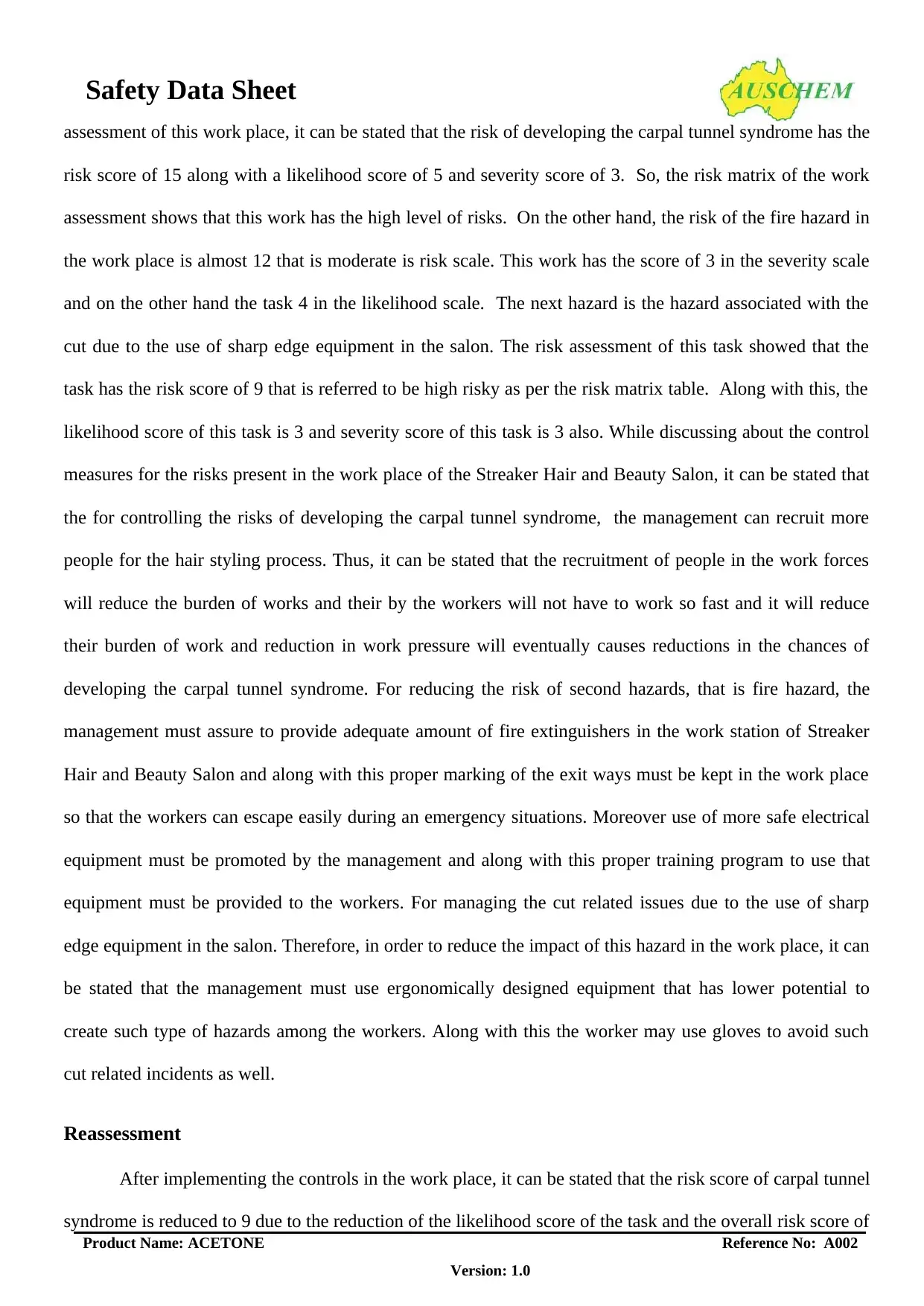
Safety Data Sheet
Product Name: ACETONE Reference No: A002
Version: 1.0
assessment of this work place, it can be stated that the risk of developing the carpal tunnel syndrome has the
risk score of 15 along with a likelihood score of 5 and severity score of 3. So, the risk matrix of the work
assessment shows that this work has the high level of risks. On the other hand, the risk of the fire hazard in
the work place is almost 12 that is moderate is risk scale. This work has the score of 3 in the severity scale
and on the other hand the task 4 in the likelihood scale. The next hazard is the hazard associated with the
cut due to the use of sharp edge equipment in the salon. The risk assessment of this task showed that the
task has the risk score of 9 that is referred to be high risky as per the risk matrix table. Along with this, the
likelihood score of this task is 3 and severity score of this task is 3 also. While discussing about the control
measures for the risks present in the work place of the Streaker Hair and Beauty Salon, it can be stated that
the for controlling the risks of developing the carpal tunnel syndrome, the management can recruit more
people for the hair styling process. Thus, it can be stated that the recruitment of people in the work forces
will reduce the burden of works and their by the workers will not have to work so fast and it will reduce
their burden of work and reduction in work pressure will eventually causes reductions in the chances of
developing the carpal tunnel syndrome. For reducing the risk of second hazards, that is fire hazard, the
management must assure to provide adequate amount of fire extinguishers in the work station of Streaker
Hair and Beauty Salon and along with this proper marking of the exit ways must be kept in the work place
so that the workers can escape easily during an emergency situations. Moreover use of more safe electrical
equipment must be promoted by the management and along with this proper training program to use that
equipment must be provided to the workers. For managing the cut related issues due to the use of sharp
edge equipment in the salon. Therefore, in order to reduce the impact of this hazard in the work place, it can
be stated that the management must use ergonomically designed equipment that has lower potential to
create such type of hazards among the workers. Along with this the worker may use gloves to avoid such
cut related incidents as well.
Reassessment
After implementing the controls in the work place, it can be stated that the risk score of carpal tunnel
syndrome is reduced to 9 due to the reduction of the likelihood score of the task and the overall risk score of
Product Name: ACETONE Reference No: A002
Version: 1.0
assessment of this work place, it can be stated that the risk of developing the carpal tunnel syndrome has the
risk score of 15 along with a likelihood score of 5 and severity score of 3. So, the risk matrix of the work
assessment shows that this work has the high level of risks. On the other hand, the risk of the fire hazard in
the work place is almost 12 that is moderate is risk scale. This work has the score of 3 in the severity scale
and on the other hand the task 4 in the likelihood scale. The next hazard is the hazard associated with the
cut due to the use of sharp edge equipment in the salon. The risk assessment of this task showed that the
task has the risk score of 9 that is referred to be high risky as per the risk matrix table. Along with this, the
likelihood score of this task is 3 and severity score of this task is 3 also. While discussing about the control
measures for the risks present in the work place of the Streaker Hair and Beauty Salon, it can be stated that
the for controlling the risks of developing the carpal tunnel syndrome, the management can recruit more
people for the hair styling process. Thus, it can be stated that the recruitment of people in the work forces
will reduce the burden of works and their by the workers will not have to work so fast and it will reduce
their burden of work and reduction in work pressure will eventually causes reductions in the chances of
developing the carpal tunnel syndrome. For reducing the risk of second hazards, that is fire hazard, the
management must assure to provide adequate amount of fire extinguishers in the work station of Streaker
Hair and Beauty Salon and along with this proper marking of the exit ways must be kept in the work place
so that the workers can escape easily during an emergency situations. Moreover use of more safe electrical
equipment must be promoted by the management and along with this proper training program to use that
equipment must be provided to the workers. For managing the cut related issues due to the use of sharp
edge equipment in the salon. Therefore, in order to reduce the impact of this hazard in the work place, it can
be stated that the management must use ergonomically designed equipment that has lower potential to
create such type of hazards among the workers. Along with this the worker may use gloves to avoid such
cut related incidents as well.
Reassessment
After implementing the controls in the work place, it can be stated that the risk score of carpal tunnel
syndrome is reduced to 9 due to the reduction of the likelihood score of the task and the overall risk score of
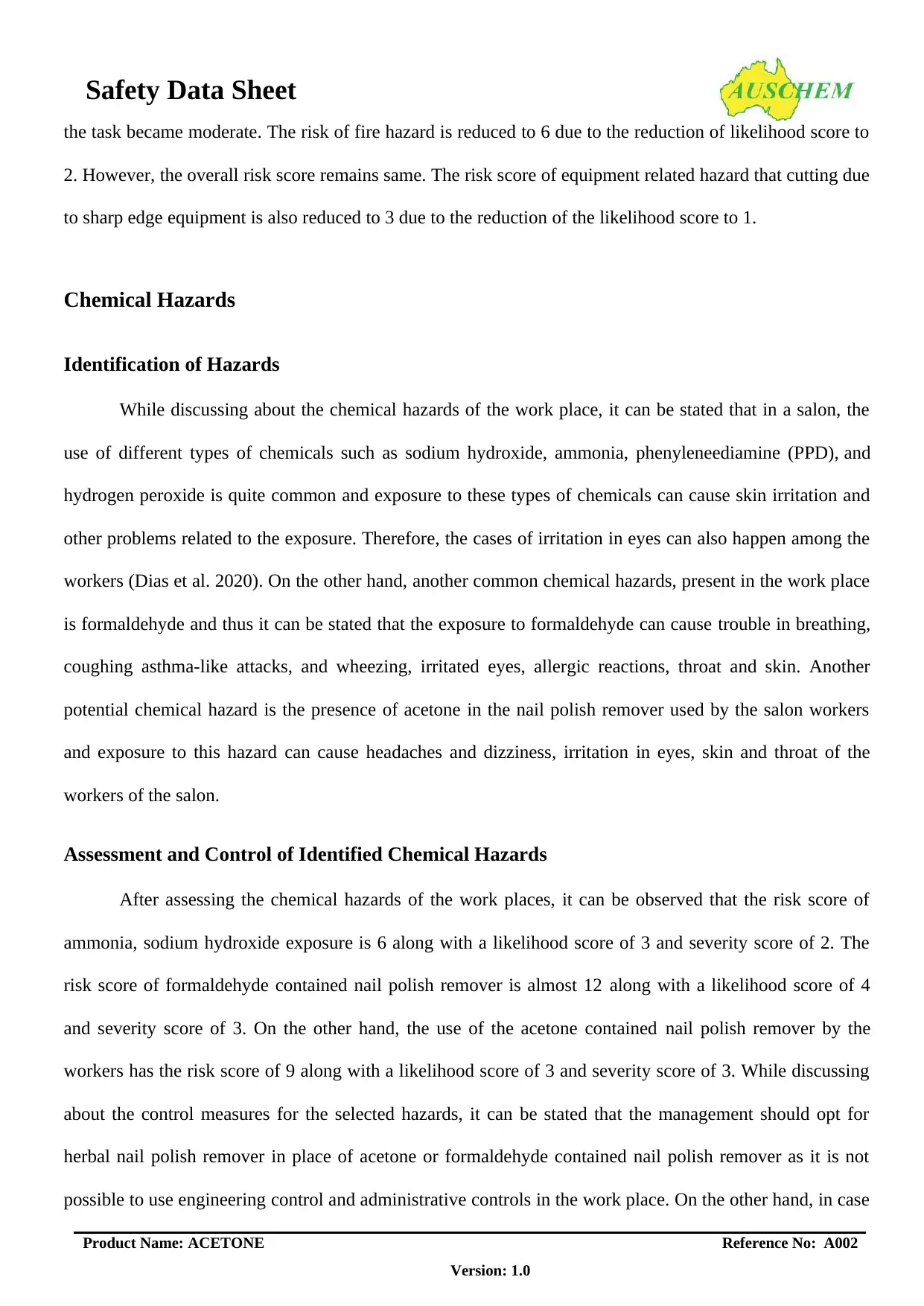
Safety Data Sheet
Product Name: ACETONE Reference No: A002
Version: 1.0
the task became moderate. The risk of fire hazard is reduced to 6 due to the reduction of likelihood score to
2. However, the overall risk score remains same. The risk score of equipment related hazard that cutting due
to sharp edge equipment is also reduced to 3 due to the reduction of the likelihood score to 1.
Chemical Hazards
Identification of Hazards
While discussing about the chemical hazards of the work place, it can be stated that in a salon, the
use of different types of chemicals such as sodium hydroxide, ammonia, phenyleneediamine (PPD), and
hydrogen peroxide is quite common and exposure to these types of chemicals can cause skin irritation and
other problems related to the exposure. Therefore, the cases of irritation in eyes can also happen among the
workers (Dias et al. 2020). On the other hand, another common chemical hazards, present in the work place
is formaldehyde and thus it can be stated that the exposure to formaldehyde can cause trouble in breathing,
coughing asthma-like attacks, and wheezing, irritated eyes, allergic reactions, throat and skin. Another
potential chemical hazard is the presence of acetone in the nail polish remover used by the salon workers
and exposure to this hazard can cause headaches and dizziness, irritation in eyes, skin and throat of the
workers of the salon.
Assessment and Control of Identified Chemical Hazards
After assessing the chemical hazards of the work places, it can be observed that the risk score of
ammonia, sodium hydroxide exposure is 6 along with a likelihood score of 3 and severity score of 2. The
risk score of formaldehyde contained nail polish remover is almost 12 along with a likelihood score of 4
and severity score of 3. On the other hand, the use of the acetone contained nail polish remover by the
workers has the risk score of 9 along with a likelihood score of 3 and severity score of 3. While discussing
about the control measures for the selected hazards, it can be stated that the management should opt for
herbal nail polish remover in place of acetone or formaldehyde contained nail polish remover as it is not
possible to use engineering control and administrative controls in the work place. On the other hand, in case
Product Name: ACETONE Reference No: A002
Version: 1.0
the task became moderate. The risk of fire hazard is reduced to 6 due to the reduction of likelihood score to
2. However, the overall risk score remains same. The risk score of equipment related hazard that cutting due
to sharp edge equipment is also reduced to 3 due to the reduction of the likelihood score to 1.
Chemical Hazards
Identification of Hazards
While discussing about the chemical hazards of the work place, it can be stated that in a salon, the
use of different types of chemicals such as sodium hydroxide, ammonia, phenyleneediamine (PPD), and
hydrogen peroxide is quite common and exposure to these types of chemicals can cause skin irritation and
other problems related to the exposure. Therefore, the cases of irritation in eyes can also happen among the
workers (Dias et al. 2020). On the other hand, another common chemical hazards, present in the work place
is formaldehyde and thus it can be stated that the exposure to formaldehyde can cause trouble in breathing,
coughing asthma-like attacks, and wheezing, irritated eyes, allergic reactions, throat and skin. Another
potential chemical hazard is the presence of acetone in the nail polish remover used by the salon workers
and exposure to this hazard can cause headaches and dizziness, irritation in eyes, skin and throat of the
workers of the salon.
Assessment and Control of Identified Chemical Hazards
After assessing the chemical hazards of the work places, it can be observed that the risk score of
ammonia, sodium hydroxide exposure is 6 along with a likelihood score of 3 and severity score of 2. The
risk score of formaldehyde contained nail polish remover is almost 12 along with a likelihood score of 4
and severity score of 3. On the other hand, the use of the acetone contained nail polish remover by the
workers has the risk score of 9 along with a likelihood score of 3 and severity score of 3. While discussing
about the control measures for the selected hazards, it can be stated that the management should opt for
herbal nail polish remover in place of acetone or formaldehyde contained nail polish remover as it is not
possible to use engineering control and administrative controls in the work place. On the other hand, in case
Paraphrase This Document
Need a fresh take? Get an instant paraphrase of this document with our AI Paraphraser
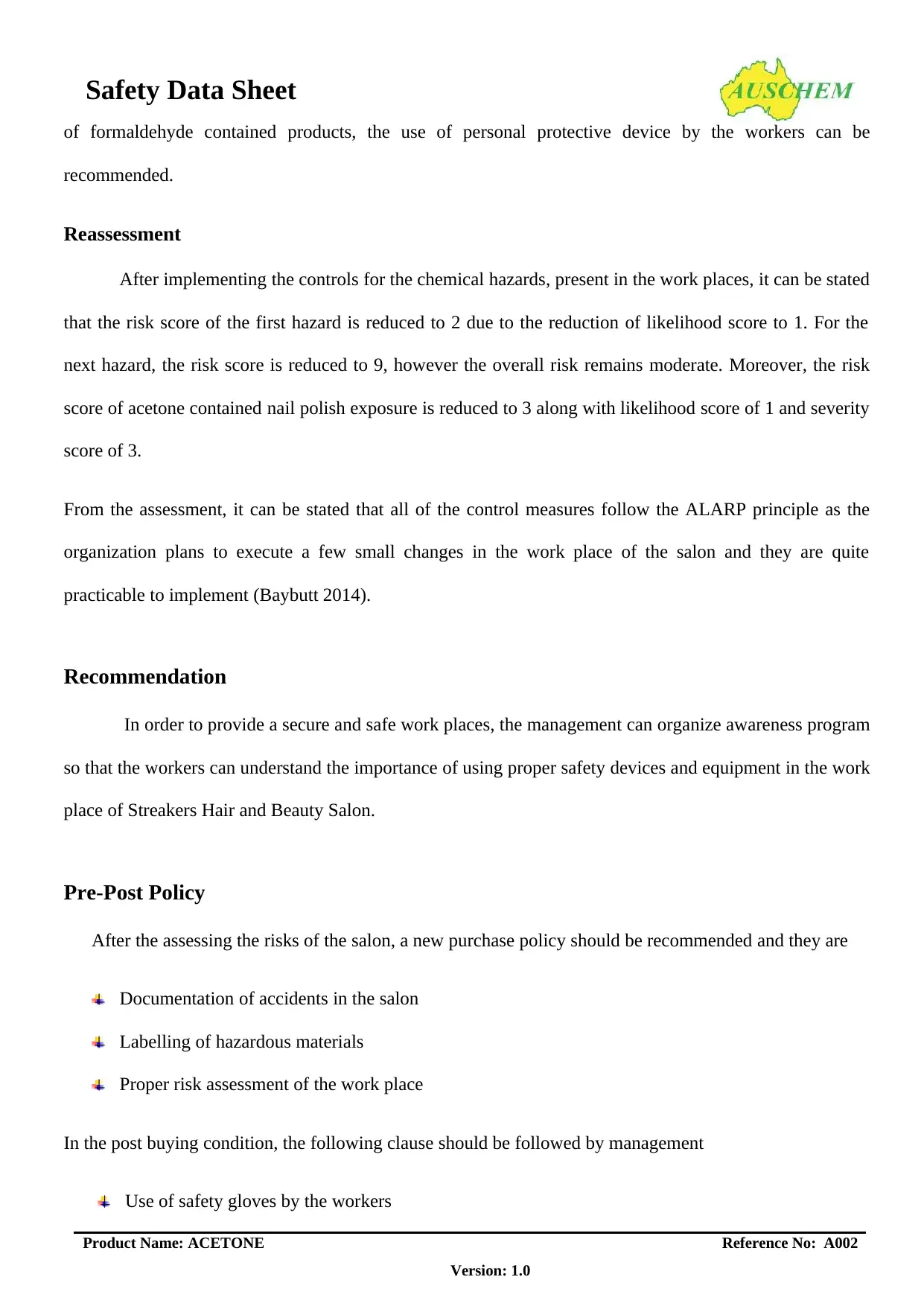
Safety Data Sheet
Product Name: ACETONE Reference No: A002
Version: 1.0
of formaldehyde contained products, the use of personal protective device by the workers can be
recommended.
Reassessment
After implementing the controls for the chemical hazards, present in the work places, it can be stated
that the risk score of the first hazard is reduced to 2 due to the reduction of likelihood score to 1. For the
next hazard, the risk score is reduced to 9, however the overall risk remains moderate. Moreover, the risk
score of acetone contained nail polish exposure is reduced to 3 along with likelihood score of 1 and severity
score of 3.
From the assessment, it can be stated that all of the control measures follow the ALARP principle as the
organization plans to execute a few small changes in the work place of the salon and they are quite
practicable to implement (Baybutt 2014).
Recommendation
In order to provide a secure and safe work places, the management can organize awareness program
so that the workers can understand the importance of using proper safety devices and equipment in the work
place of Streakers Hair and Beauty Salon.
Pre-Post Policy
After the assessing the risks of the salon, a new purchase policy should be recommended and they are
Documentation of accidents in the salon
Labelling of hazardous materials
Proper risk assessment of the work place
In the post buying condition, the following clause should be followed by management
Use of safety gloves by the workers
Product Name: ACETONE Reference No: A002
Version: 1.0
of formaldehyde contained products, the use of personal protective device by the workers can be
recommended.
Reassessment
After implementing the controls for the chemical hazards, present in the work places, it can be stated
that the risk score of the first hazard is reduced to 2 due to the reduction of likelihood score to 1. For the
next hazard, the risk score is reduced to 9, however the overall risk remains moderate. Moreover, the risk
score of acetone contained nail polish exposure is reduced to 3 along with likelihood score of 1 and severity
score of 3.
From the assessment, it can be stated that all of the control measures follow the ALARP principle as the
organization plans to execute a few small changes in the work place of the salon and they are quite
practicable to implement (Baybutt 2014).
Recommendation
In order to provide a secure and safe work places, the management can organize awareness program
so that the workers can understand the importance of using proper safety devices and equipment in the work
place of Streakers Hair and Beauty Salon.
Pre-Post Policy
After the assessing the risks of the salon, a new purchase policy should be recommended and they are
Documentation of accidents in the salon
Labelling of hazardous materials
Proper risk assessment of the work place
In the post buying condition, the following clause should be followed by management
Use of safety gloves by the workers
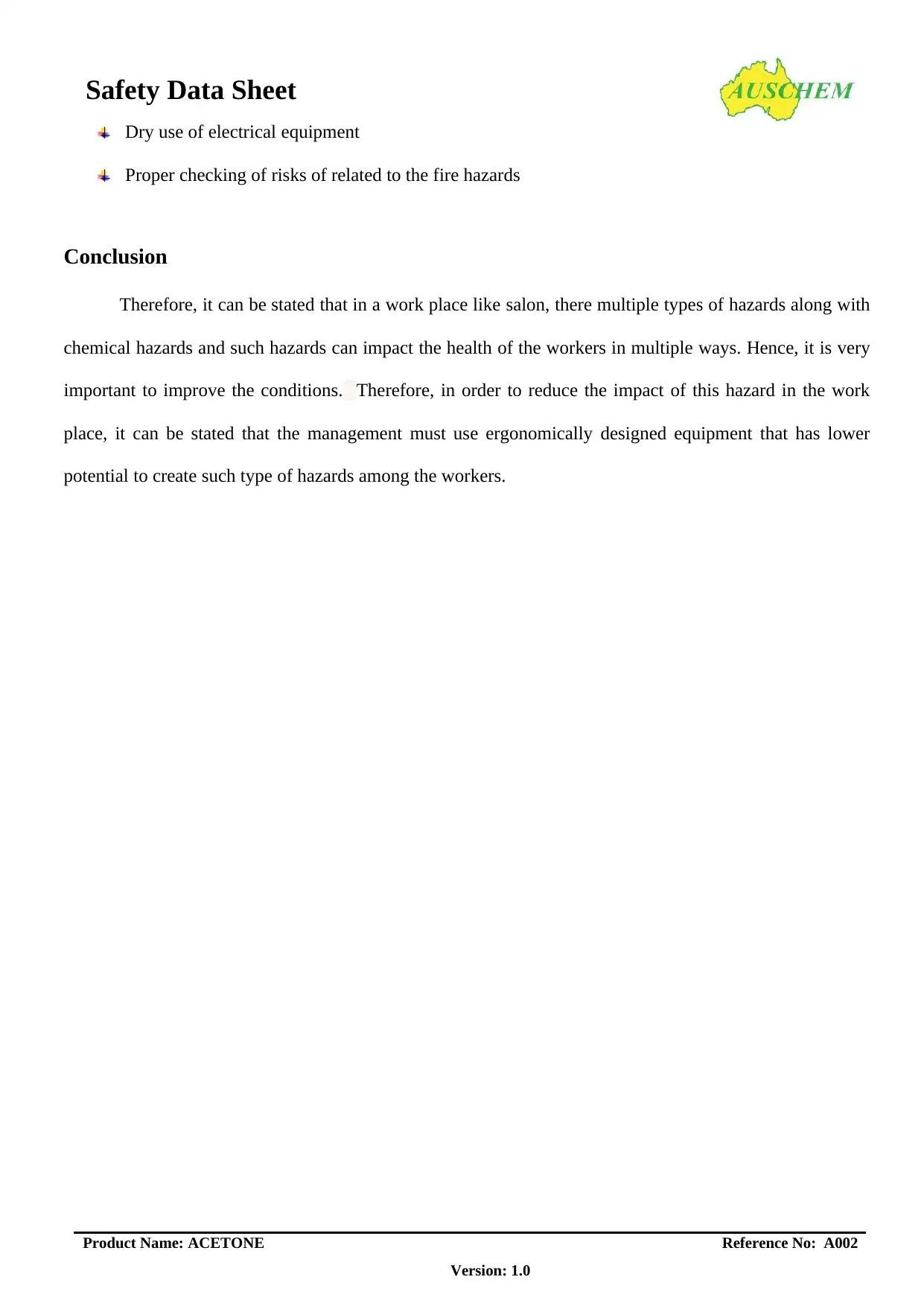
Safety Data Sheet
Product Name: ACETONE Reference No: A002
Version: 1.0
Dry use of electrical equipment
Proper checking of risks of related to the fire hazards
Conclusion
Therefore, it can be stated that in a work place like salon, there multiple types of hazards along with
chemical hazards and such hazards can impact the health of the workers in multiple ways. Hence, it is very
important to improve the conditions. Therefore, in order to reduce the impact of this hazard in the work
place, it can be stated that the management must use ergonomically designed equipment that has lower
potential to create such type of hazards among the workers.
Product Name: ACETONE Reference No: A002
Version: 1.0
Dry use of electrical equipment
Proper checking of risks of related to the fire hazards
Conclusion
Therefore, it can be stated that in a work place like salon, there multiple types of hazards along with
chemical hazards and such hazards can impact the health of the workers in multiple ways. Hence, it is very
important to improve the conditions. Therefore, in order to reduce the impact of this hazard in the work
place, it can be stated that the management must use ergonomically designed equipment that has lower
potential to create such type of hazards among the workers.
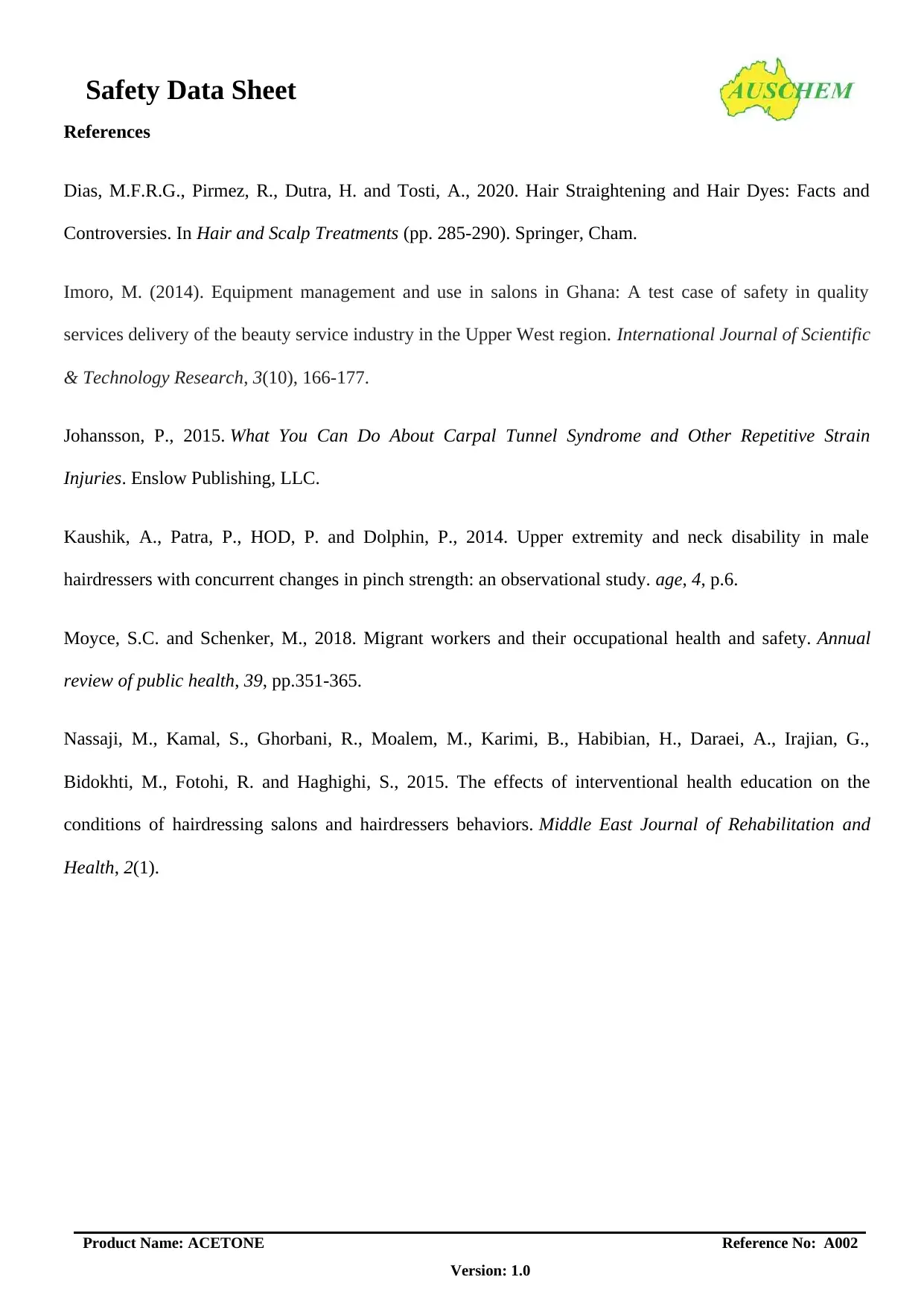
Safety Data Sheet
Product Name: ACETONE Reference No: A002
Version: 1.0
References
Dias, M.F.R.G., Pirmez, R., Dutra, H. and Tosti, A., 2020. Hair Straightening and Hair Dyes: Facts and
Controversies. In Hair and Scalp Treatments (pp. 285-290). Springer, Cham.
Imoro, M. (2014). Equipment management and use in salons in Ghana: A test case of safety in quality
services delivery of the beauty service industry in the Upper West region. International Journal of Scientific
& Technology Research, 3(10), 166-177.
Johansson, P., 2015. What You Can Do About Carpal Tunnel Syndrome and Other Repetitive Strain
Injuries. Enslow Publishing, LLC.
Kaushik, A., Patra, P., HOD, P. and Dolphin, P., 2014. Upper extremity and neck disability in male
hairdressers with concurrent changes in pinch strength: an observational study. age, 4, p.6.
Moyce, S.C. and Schenker, M., 2018. Migrant workers and their occupational health and safety. Annual
review of public health, 39, pp.351-365.
Nassaji, M., Kamal, S., Ghorbani, R., Moalem, M., Karimi, B., Habibian, H., Daraei, A., Irajian, G.,
Bidokhti, M., Fotohi, R. and Haghighi, S., 2015. The effects of interventional health education on the
conditions of hairdressing salons and hairdressers behaviors. Middle East Journal of Rehabilitation and
Health, 2(1).
Product Name: ACETONE Reference No: A002
Version: 1.0
References
Dias, M.F.R.G., Pirmez, R., Dutra, H. and Tosti, A., 2020. Hair Straightening and Hair Dyes: Facts and
Controversies. In Hair and Scalp Treatments (pp. 285-290). Springer, Cham.
Imoro, M. (2014). Equipment management and use in salons in Ghana: A test case of safety in quality
services delivery of the beauty service industry in the Upper West region. International Journal of Scientific
& Technology Research, 3(10), 166-177.
Johansson, P., 2015. What You Can Do About Carpal Tunnel Syndrome and Other Repetitive Strain
Injuries. Enslow Publishing, LLC.
Kaushik, A., Patra, P., HOD, P. and Dolphin, P., 2014. Upper extremity and neck disability in male
hairdressers with concurrent changes in pinch strength: an observational study. age, 4, p.6.
Moyce, S.C. and Schenker, M., 2018. Migrant workers and their occupational health and safety. Annual
review of public health, 39, pp.351-365.
Nassaji, M., Kamal, S., Ghorbani, R., Moalem, M., Karimi, B., Habibian, H., Daraei, A., Irajian, G.,
Bidokhti, M., Fotohi, R. and Haghighi, S., 2015. The effects of interventional health education on the
conditions of hairdressing salons and hairdressers behaviors. Middle East Journal of Rehabilitation and
Health, 2(1).
Secure Best Marks with AI Grader
Need help grading? Try our AI Grader for instant feedback on your assignments.
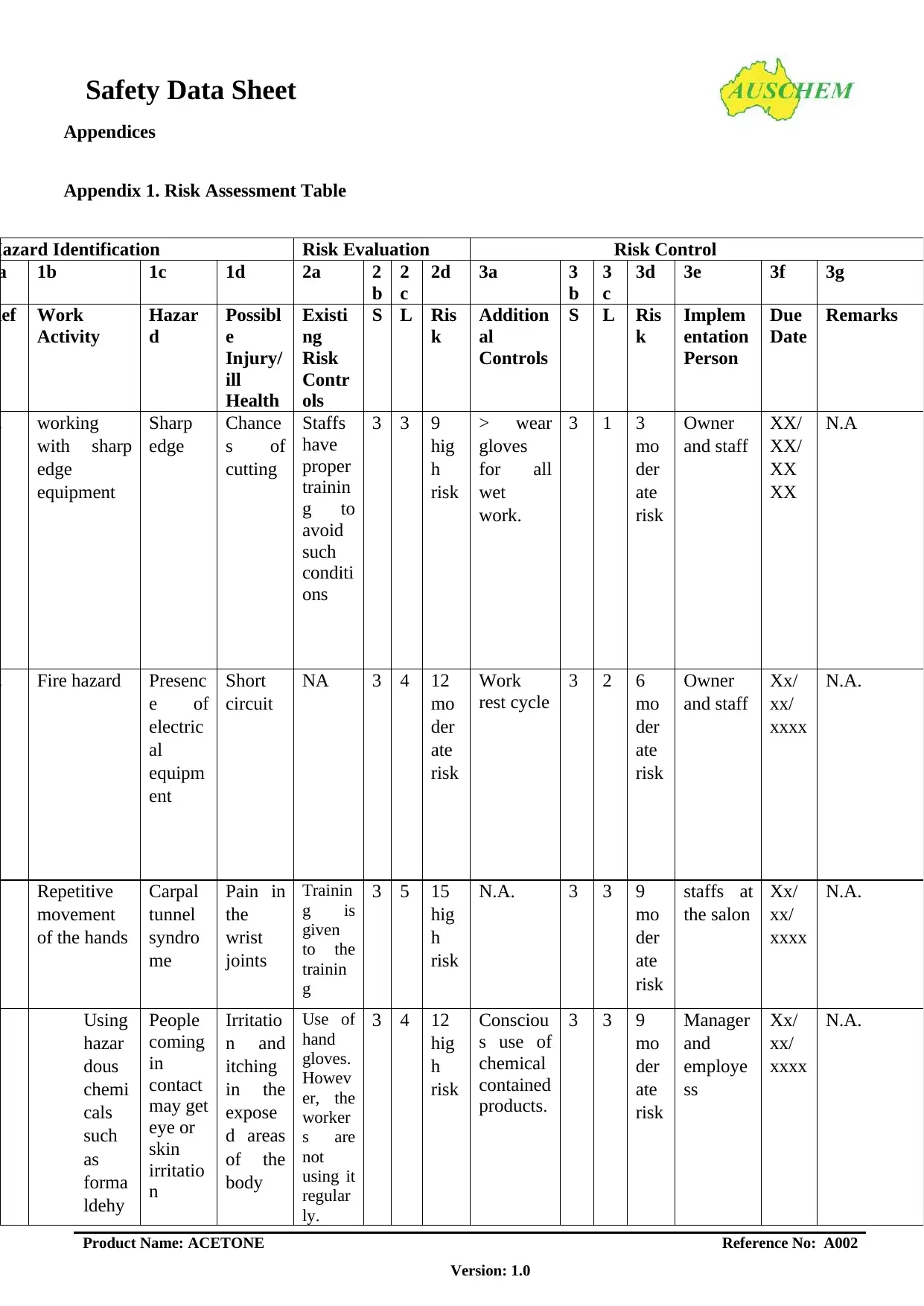
Safety Data Sheet
Product Name: ACETONE Reference No: A002
Version: 1.0
Appendices
Appendix 1. Risk Assessment Table
Hazard Identification Risk Evaluation Risk Control
a 1b 1c 1d 2a 2
b
2
c
2d 3a 3
b
3
c
3d 3e 3f 3g
Ref Work
Activity
Hazar
d
Possibl
e
Injury/
ill
Health
Existi
ng
Risk
Contr
ols
S L Ris
k
Addition
al
Controls
S L Ris
k
Implem
entation
Person
Due
Date
Remarks
. working
with sharp
edge
equipment
Sharp
edge
Chance
s of
cutting
Staffs
have
proper
trainin
g to
avoid
such
conditi
ons
3 3 9
hig
h
risk
> wear
gloves
for all
wet
work.
3 1 3
mo
der
ate
risk
Owner
and staff
XX/
XX/
XX
XX
N.A
. Fire hazard Presenc
e of
electric
al
equipm
ent
Short
circuit
NA 3 4 12
mo
der
ate
risk
Work
rest cycle
3 2 6
mo
der
ate
risk
Owner
and staff
Xx/
xx/
xxxx
N.A.
. Repetitive
movement
of the hands
Carpal
tunnel
syndro
me
Pain in
the
wrist
joints
Trainin
g is
given
to the
trainin
g
3 5 15
hig
h
risk
N.A. 3 3 9
mo
der
ate
risk
staffs at
the salon
Xx/
xx/
xxxx
N.A.
. Using
hazar
dous
chemi
cals
such
as
forma
ldehy
People
coming
in
contact
may get
eye or
skin
irritatio
n
Irritatio
n and
itching
in the
expose
d areas
of the
body
Use of
hand
gloves.
Howev
er, the
worker
s are
not
using it
regular
ly.
3 4 12
hig
h
risk
Consciou
s use of
chemical
contained
products.
3 3 9
mo
der
ate
risk
Manager
and
employe
ss
Xx/
xx/
xxxx
N.A.
Product Name: ACETONE Reference No: A002
Version: 1.0
Appendices
Appendix 1. Risk Assessment Table
Hazard Identification Risk Evaluation Risk Control
a 1b 1c 1d 2a 2
b
2
c
2d 3a 3
b
3
c
3d 3e 3f 3g
Ref Work
Activity
Hazar
d
Possibl
e
Injury/
ill
Health
Existi
ng
Risk
Contr
ols
S L Ris
k
Addition
al
Controls
S L Ris
k
Implem
entation
Person
Due
Date
Remarks
. working
with sharp
edge
equipment
Sharp
edge
Chance
s of
cutting
Staffs
have
proper
trainin
g to
avoid
such
conditi
ons
3 3 9
hig
h
risk
> wear
gloves
for all
wet
work.
3 1 3
mo
der
ate
risk
Owner
and staff
XX/
XX/
XX
XX
N.A
. Fire hazard Presenc
e of
electric
al
equipm
ent
Short
circuit
NA 3 4 12
mo
der
ate
risk
Work
rest cycle
3 2 6
mo
der
ate
risk
Owner
and staff
Xx/
xx/
xxxx
N.A.
. Repetitive
movement
of the hands
Carpal
tunnel
syndro
me
Pain in
the
wrist
joints
Trainin
g is
given
to the
trainin
g
3 5 15
hig
h
risk
N.A. 3 3 9
mo
der
ate
risk
staffs at
the salon
Xx/
xx/
xxxx
N.A.
. Using
hazar
dous
chemi
cals
such
as
forma
ldehy
People
coming
in
contact
may get
eye or
skin
irritatio
n
Irritatio
n and
itching
in the
expose
d areas
of the
body
Use of
hand
gloves.
Howev
er, the
worker
s are
not
using it
regular
ly.
3 4 12
hig
h
risk
Consciou
s use of
chemical
contained
products.
3 3 9
mo
der
ate
risk
Manager
and
employe
ss
Xx/
xx/
xxxx
N.A.
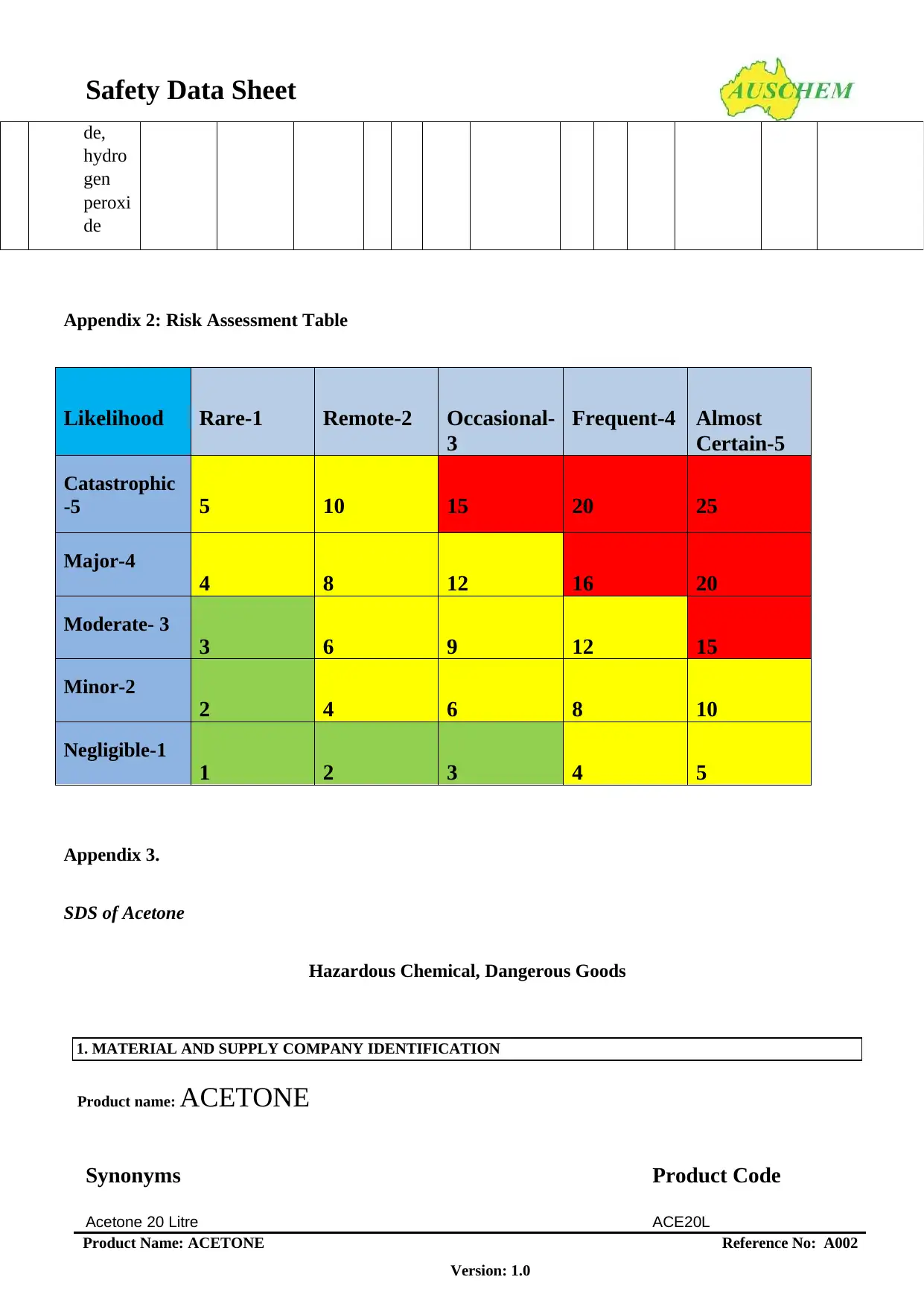
Safety Data Sheet
Product Name: ACETONE Reference No: A002
Version: 1.0
1. MATERIAL AND SUPPLY COMPANY IDENTIFICATION
de,
hydro
gen
peroxi
de
Appendix 2: Risk Assessment Table
Likelihood Rare-1 Remote-2 Occasional-
3
Frequent-4 Almost
Certain-5
Catastrophic
-5 5 10 15 20 25
Major-4
4 8 12 16 20
Moderate- 3
3 6 9 12 15
Minor-2
2 4 6 8 10
Negligible-1
1 2 3 4 5
Appendix 3.
SDS of Acetone
Hazardous Chemical, Dangerous Goods
Product name: ACETONE
Synonyms Product Code
Acetone 20 Litre ACE20L
Product Name: ACETONE Reference No: A002
Version: 1.0
1. MATERIAL AND SUPPLY COMPANY IDENTIFICATION
de,
hydro
gen
peroxi
de
Appendix 2: Risk Assessment Table
Likelihood Rare-1 Remote-2 Occasional-
3
Frequent-4 Almost
Certain-5
Catastrophic
-5 5 10 15 20 25
Major-4
4 8 12 16 20
Moderate- 3
3 6 9 12 15
Minor-2
2 4 6 8 10
Negligible-1
1 2 3 4 5
Appendix 3.
SDS of Acetone
Hazardous Chemical, Dangerous Goods
Product name: ACETONE
Synonyms Product Code
Acetone 20 Litre ACE20L
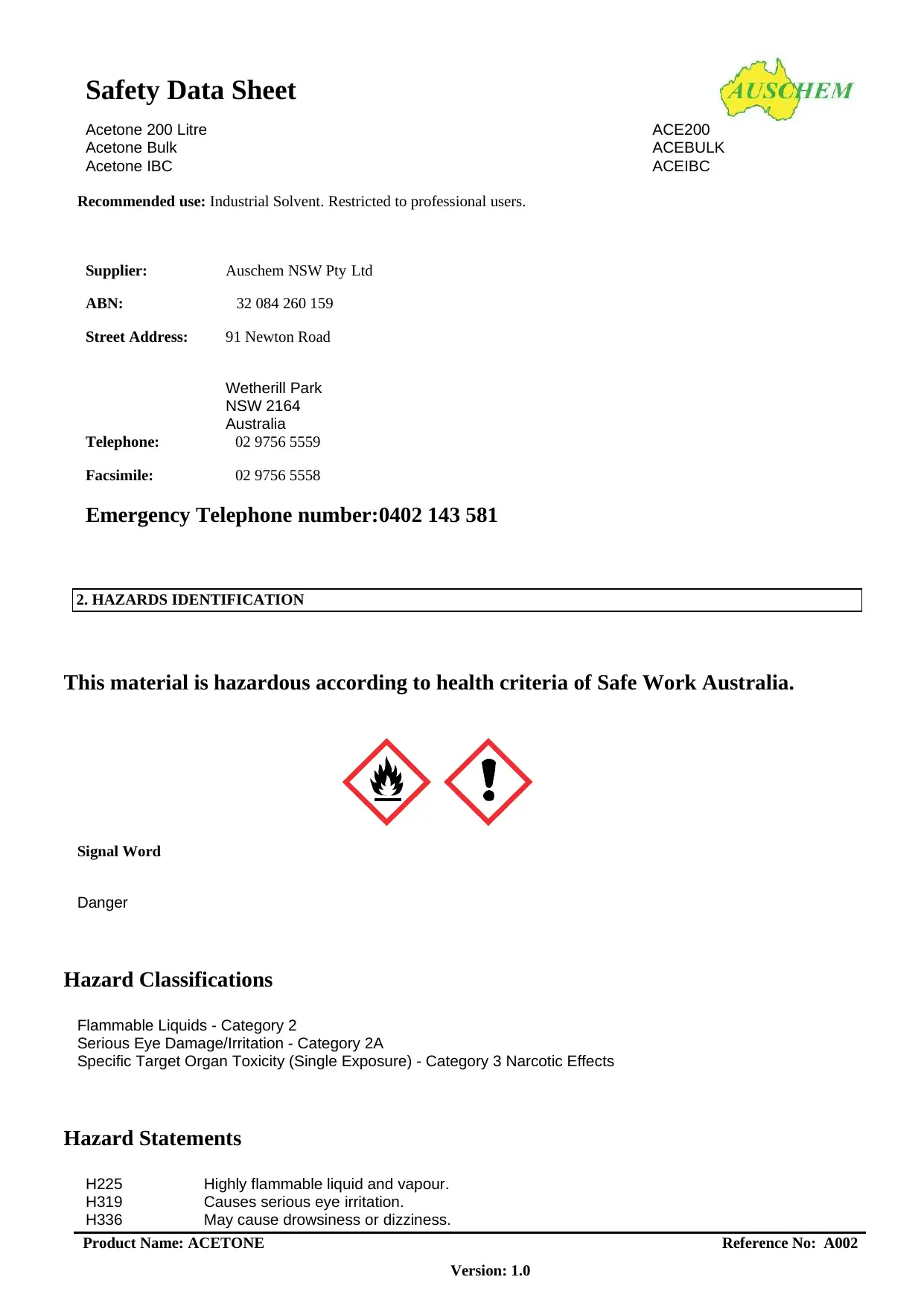
Safety Data Sheet
Product Name: ACETONE Reference No: A002
Version: 1.0
2. HAZARDS IDENTIFICATION
Acetone 200 Litre ACE200
Acetone Bulk ACEBULK
Acetone IBC ACEIBC
Recommended use: Industrial Solvent. Restricted to professional users.
Supplier: Auschem NSW Pty Ltd
ABN: 32 084 260 159
Street Address: 91 Newton Road
Wetherill Park
NSW 2164
Australia
Telephone: 02 9756 5559
Facsimile: 02 9756 5558
Emergency Telephone number:0402 143 581
This material is hazardous according to health criteria of Safe Work Australia.
Signal Word
Danger
Hazard Classifications
Flammable Liquids - Category 2
Serious Eye Damage/Irritation - Category 2A
Specific Target Organ Toxicity (Single Exposure) - Category 3 Narcotic Effects
Hazard Statements
H225 Highly flammable liquid and vapour.
H319 Causes serious eye irritation.
H336 May cause drowsiness or dizziness.
Product Name: ACETONE Reference No: A002
Version: 1.0
2. HAZARDS IDENTIFICATION
Acetone 200 Litre ACE200
Acetone Bulk ACEBULK
Acetone IBC ACEIBC
Recommended use: Industrial Solvent. Restricted to professional users.
Supplier: Auschem NSW Pty Ltd
ABN: 32 084 260 159
Street Address: 91 Newton Road
Wetherill Park
NSW 2164
Australia
Telephone: 02 9756 5559
Facsimile: 02 9756 5558
Emergency Telephone number:0402 143 581
This material is hazardous according to health criteria of Safe Work Australia.
Signal Word
Danger
Hazard Classifications
Flammable Liquids - Category 2
Serious Eye Damage/Irritation - Category 2A
Specific Target Organ Toxicity (Single Exposure) - Category 3 Narcotic Effects
Hazard Statements
H225 Highly flammable liquid and vapour.
H319 Causes serious eye irritation.
H336 May cause drowsiness or dizziness.
Paraphrase This Document
Need a fresh take? Get an instant paraphrase of this document with our AI Paraphraser
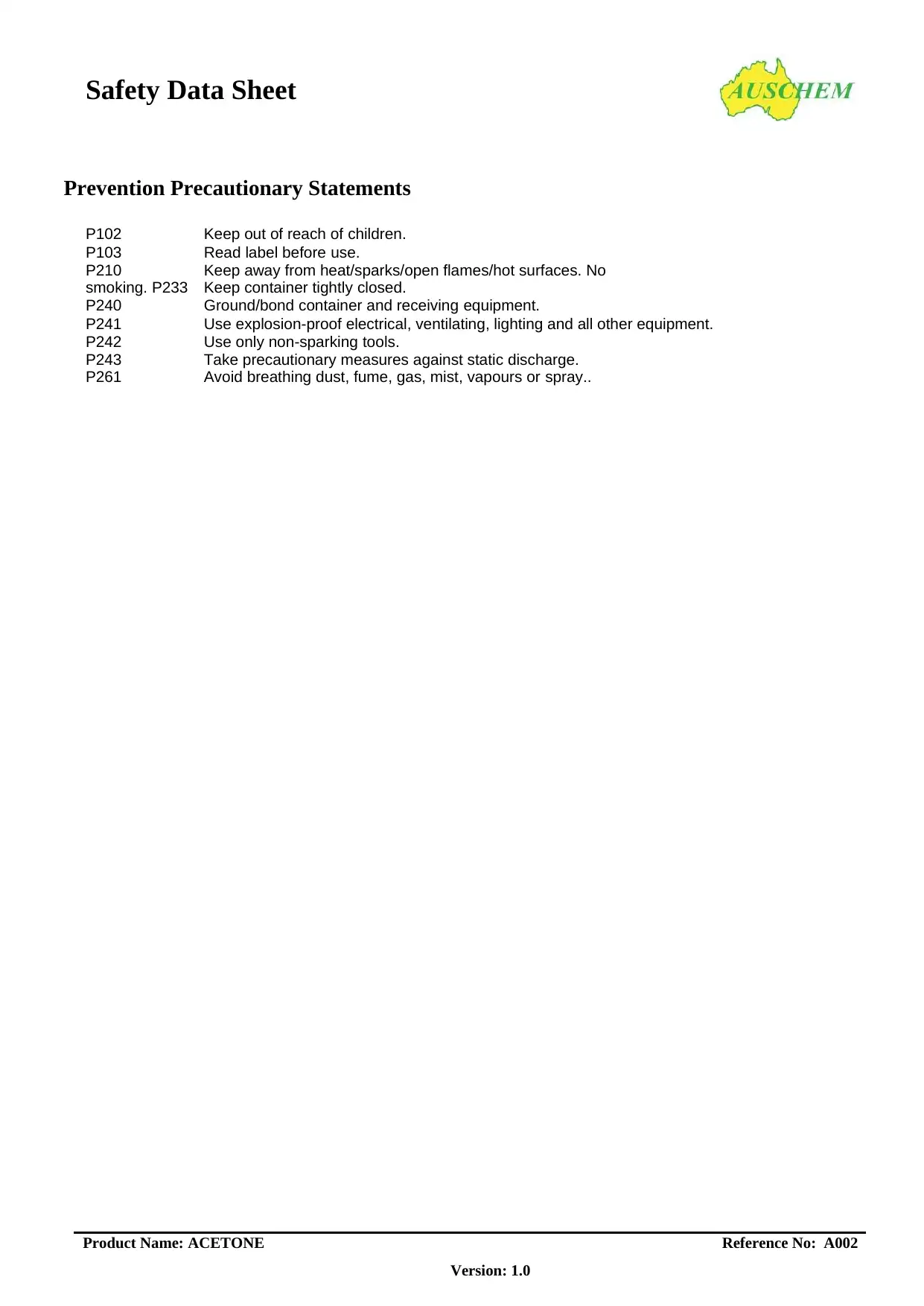
Safety Data Sheet
Product Name: ACETONE Reference No: A002
Version: 1.0
Prevention Precautionary Statements
P102 Keep out of reach of children.
P103 Read label before use.
P210 Keep away from heat/sparks/open flames/hot surfaces. No
smoking. P233 Keep container tightly closed.
P240 Ground/bond container and receiving equipment.
P241 Use explosion-proof electrical, ventilating, lighting and all other equipment.
P242 Use only non-sparking tools.
P243 Take precautionary measures against static discharge.
P261 Avoid breathing dust, fume, gas, mist, vapours or spray..
Product Name: ACETONE Reference No: A002
Version: 1.0
Prevention Precautionary Statements
P102 Keep out of reach of children.
P103 Read label before use.
P210 Keep away from heat/sparks/open flames/hot surfaces. No
smoking. P233 Keep container tightly closed.
P240 Ground/bond container and receiving equipment.
P241 Use explosion-proof electrical, ventilating, lighting and all other equipment.
P242 Use only non-sparking tools.
P243 Take precautionary measures against static discharge.
P261 Avoid breathing dust, fume, gas, mist, vapours or spray..
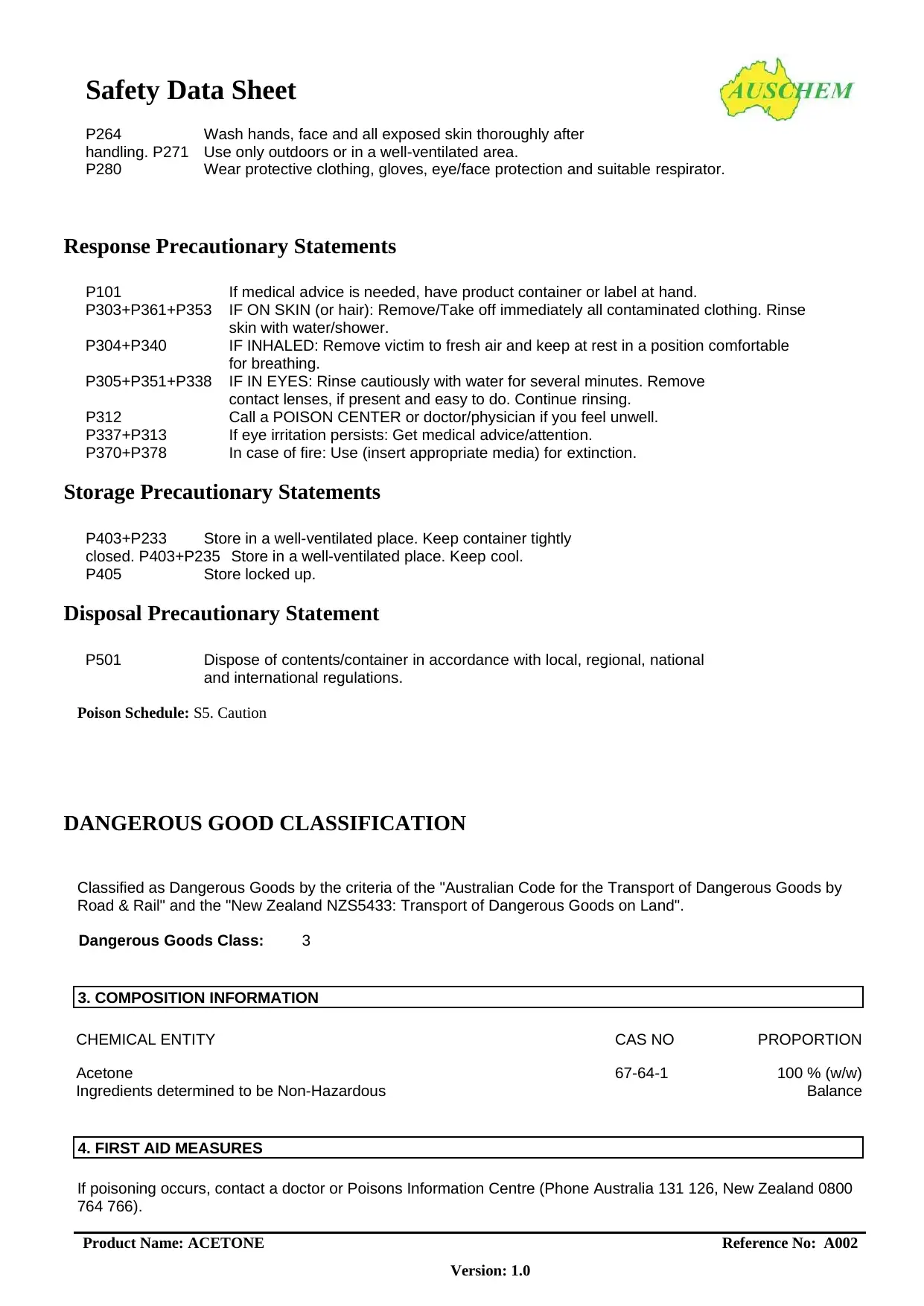
Safety Data Sheet
Product Name: ACETONE Reference No: A002
Version: 1.0
P264 Wash hands, face and all exposed skin thoroughly after
handling. P271 Use only outdoors or in a well-ventilated area.
P280 Wear protective clothing, gloves, eye/face protection and suitable respirator.
Response Precautionary Statements
P101 If medical advice is needed, have product container or label at hand.
P303+P361+P353 IF ON SKIN (or hair): Remove/Take off immediately all contaminated clothing. Rinse
skin with water/shower.
P304+P340 IF INHALED: Remove victim to fresh air and keep at rest in a position comfortable
for breathing.
P305+P351+P338 IF IN EYES: Rinse cautiously with water for several minutes. Remove
contact lenses, if present and easy to do. Continue rinsing.
P312 Call a POISON CENTER or doctor/physician if you feel unwell.
P337+P313 If eye irritation persists: Get medical advice/attention.
P370+P378 In case of fire: Use (insert appropriate media) for extinction.
Storage Precautionary Statements
P403+P233 Store in a well-ventilated place. Keep container tightly
closed. P403+P235 Store in a well-ventilated place. Keep cool.
P405 Store locked up.
Disposal Precautionary Statement
P501 Dispose of contents/container in accordance with local, regional, national
and international regulations.
Poison Schedule: S5. Caution
DANGEROUS GOOD CLASSIFICATION
Classified as Dangerous Goods by the criteria of the "Australian Code for the Transport of Dangerous Goods by
Road & Rail" and the "New Zealand NZS5433: Transport of Dangerous Goods on Land".
Dangerous Goods Class: 3
3. COMPOSITION INFORMATION
CHEMICAL ENTITY CAS NO PROPORTION
Acetone
Ingredients determined to be Non-Hazardous
67-64-1 100 % (w/w)
Balance
4. FIRST AID MEASURES
If poisoning occurs, contact a doctor or Poisons Information Centre (Phone Australia 131 126, New Zealand 0800
764 766).
Product Name: ACETONE Reference No: A002
Version: 1.0
P264 Wash hands, face and all exposed skin thoroughly after
handling. P271 Use only outdoors or in a well-ventilated area.
P280 Wear protective clothing, gloves, eye/face protection and suitable respirator.
Response Precautionary Statements
P101 If medical advice is needed, have product container or label at hand.
P303+P361+P353 IF ON SKIN (or hair): Remove/Take off immediately all contaminated clothing. Rinse
skin with water/shower.
P304+P340 IF INHALED: Remove victim to fresh air and keep at rest in a position comfortable
for breathing.
P305+P351+P338 IF IN EYES: Rinse cautiously with water for several minutes. Remove
contact lenses, if present and easy to do. Continue rinsing.
P312 Call a POISON CENTER or doctor/physician if you feel unwell.
P337+P313 If eye irritation persists: Get medical advice/attention.
P370+P378 In case of fire: Use (insert appropriate media) for extinction.
Storage Precautionary Statements
P403+P233 Store in a well-ventilated place. Keep container tightly
closed. P403+P235 Store in a well-ventilated place. Keep cool.
P405 Store locked up.
Disposal Precautionary Statement
P501 Dispose of contents/container in accordance with local, regional, national
and international regulations.
Poison Schedule: S5. Caution
DANGEROUS GOOD CLASSIFICATION
Classified as Dangerous Goods by the criteria of the "Australian Code for the Transport of Dangerous Goods by
Road & Rail" and the "New Zealand NZS5433: Transport of Dangerous Goods on Land".
Dangerous Goods Class: 3
3. COMPOSITION INFORMATION
CHEMICAL ENTITY CAS NO PROPORTION
Acetone
Ingredients determined to be Non-Hazardous
67-64-1 100 % (w/w)
Balance
4. FIRST AID MEASURES
If poisoning occurs, contact a doctor or Poisons Information Centre (Phone Australia 131 126, New Zealand 0800
764 766).
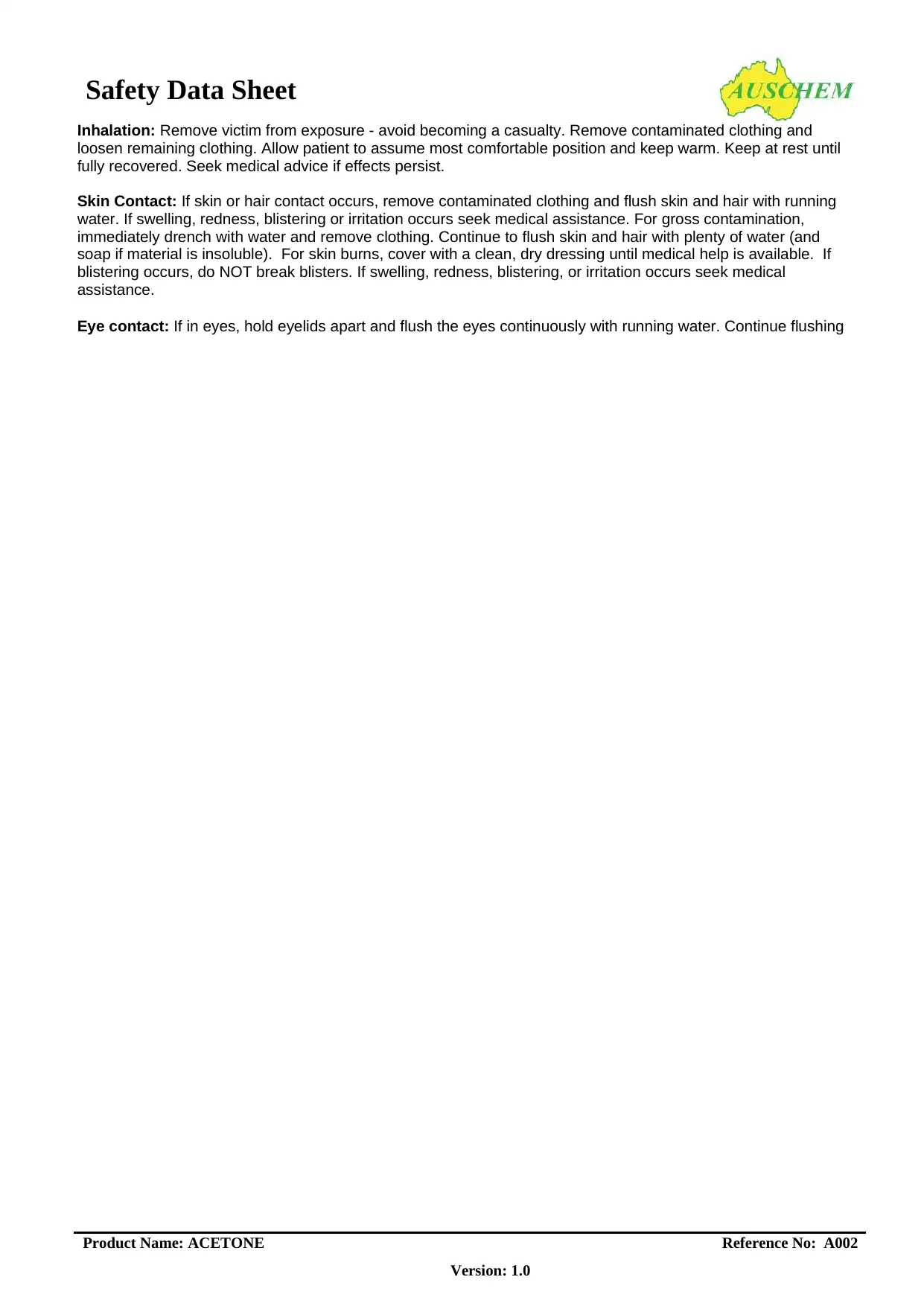
Safety Data Sheet
Product Name: ACETONE Reference No: A002
Version: 1.0
Inhalation: Remove victim from exposure - avoid becoming a casualty. Remove contaminated clothing and
loosen remaining clothing. Allow patient to assume most comfortable position and keep warm. Keep at rest until
fully recovered. Seek medical advice if effects persist.
Skin Contact: If skin or hair contact occurs, remove contaminated clothing and flush skin and hair with running
water. If swelling, redness, blistering or irritation occurs seek medical assistance. For gross contamination,
immediately drench with water and remove clothing. Continue to flush skin and hair with plenty of water (and
soap if material is insoluble). For skin burns, cover with a clean, dry dressing until medical help is available. If
blistering occurs, do NOT break blisters. If swelling, redness, blistering, or irritation occurs seek medical
assistance.
Eye contact: If in eyes, hold eyelids apart and flush the eyes continuously with running water. Continue flushing
Product Name: ACETONE Reference No: A002
Version: 1.0
Inhalation: Remove victim from exposure - avoid becoming a casualty. Remove contaminated clothing and
loosen remaining clothing. Allow patient to assume most comfortable position and keep warm. Keep at rest until
fully recovered. Seek medical advice if effects persist.
Skin Contact: If skin or hair contact occurs, remove contaminated clothing and flush skin and hair with running
water. If swelling, redness, blistering or irritation occurs seek medical assistance. For gross contamination,
immediately drench with water and remove clothing. Continue to flush skin and hair with plenty of water (and
soap if material is insoluble). For skin burns, cover with a clean, dry dressing until medical help is available. If
blistering occurs, do NOT break blisters. If swelling, redness, blistering, or irritation occurs seek medical
assistance.
Eye contact: If in eyes, hold eyelids apart and flush the eyes continuously with running water. Continue flushing
Secure Best Marks with AI Grader
Need help grading? Try our AI Grader for instant feedback on your assignments.
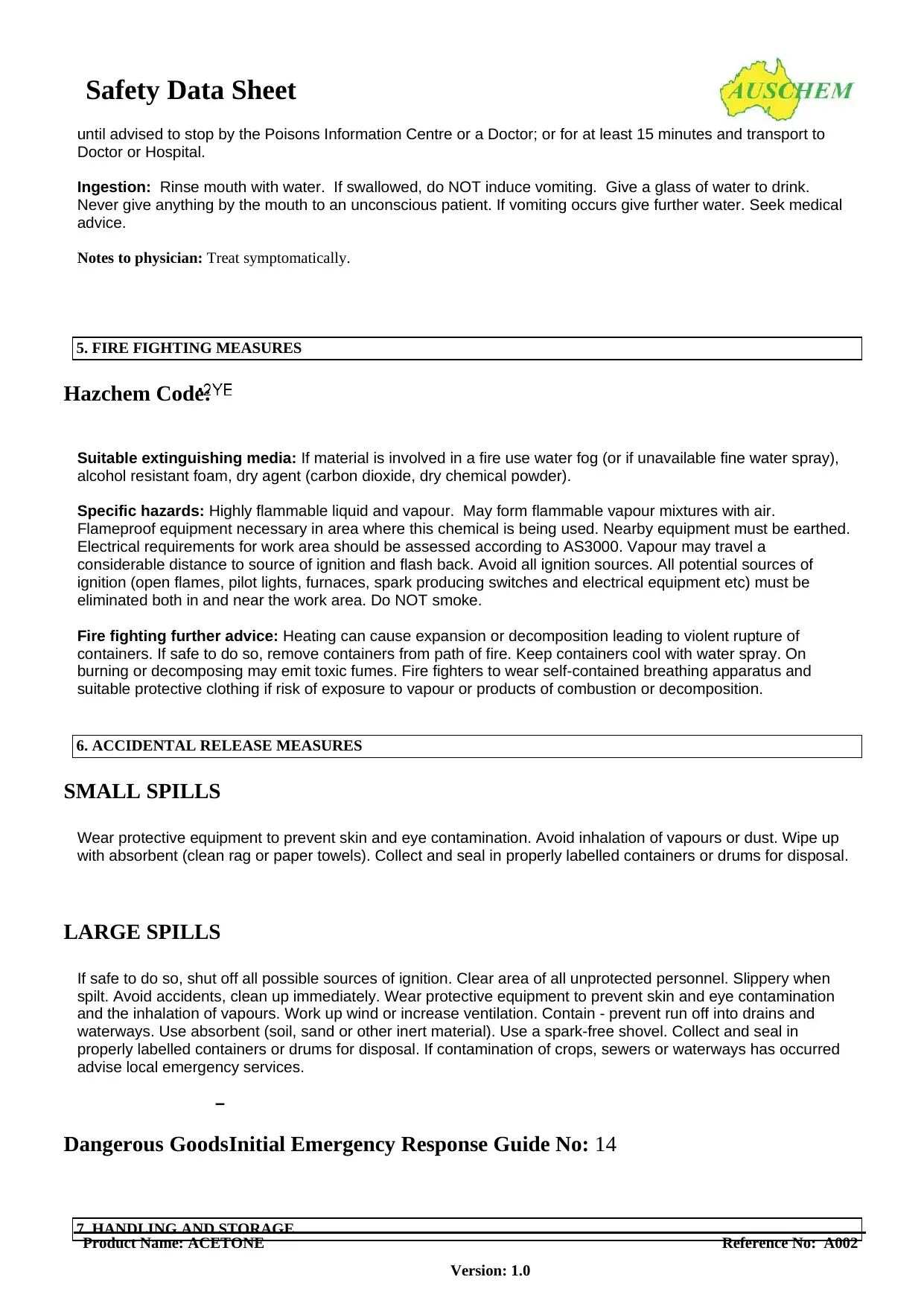
5. FIRE FIGHTING MEASURES
6. ACCIDENTAL RELEASE MEASURES
7. HANDLING AND STORAGE
Safety Data Sheet
Product Name: ACETONE Reference No: A002
Version: 1.0
until advised to stop by the Poisons Information Centre or a Doctor; or for at least 15 minutes and transport to
Doctor or Hospital.
Ingestion: Rinse mouth with water. If swallowed, do NOT induce vomiting. Give a glass of water to drink.
Never give anything by the mouth to an unconscious patient. If vomiting occurs give further water. Seek medical
advice.
Notes to physician: Treat symptomatically.
Hazchem Code:
Suitable extinguishing media: If material is involved in a fire use water fog (or if unavailable fine water spray),
alcohol resistant foam, dry agent (carbon dioxide, dry chemical powder).
Specific hazards: Highly flammable liquid and vapour. May form flammable vapour mixtures with air.
Flameproof equipment necessary in area where this chemical is being used. Nearby equipment must be earthed.
Electrical requirements for work area should be assessed according to AS3000. Vapour may travel a
considerable distance to source of ignition and flash back. Avoid all ignition sources. All potential sources of
ignition (open flames, pilot lights, furnaces, spark producing switches and electrical equipment etc) must be
eliminated both in and near the work area. Do NOT smoke.
Fire fighting further advice: Heating can cause expansion or decomposition leading to violent rupture of
containers. If safe to do so, remove containers from path of fire. Keep containers cool with water spray. On
burning or decomposing may emit toxic fumes. Fire fighters to wear self-contained breathing apparatus and
suitable protective clothing if risk of exposure to vapour or products of combustion or decomposition.
SMALL SPILLS
Wear protective equipment to prevent skin and eye contamination. Avoid inhalation of vapours or dust. Wipe up
with absorbent (clean rag or paper towels). Collect and seal in properly labelled containers or drums for disposal.
LARGE SPILLS
If safe to do so, shut off all possible sources of ignition. Clear area of all unprotected personnel. Slippery when
spilt. Avoid accidents, clean up immediately. Wear protective equipment to prevent skin and eye contamination
and the inhalation of vapours. Work up wind or increase ventilation. Contain - prevent run off into drains and
waterways. Use absorbent (soil, sand or other inert material). Use a spark-free shovel. Collect and seal in
properly labelled containers or drums for disposal. If contamination of crops, sewers or waterways has occurred
advise local emergency services.
Dangerous GoodsInitial Emergency Response Guide No: 14
6. ACCIDENTAL RELEASE MEASURES
7. HANDLING AND STORAGE
Safety Data Sheet
Product Name: ACETONE Reference No: A002
Version: 1.0
until advised to stop by the Poisons Information Centre or a Doctor; or for at least 15 minutes and transport to
Doctor or Hospital.
Ingestion: Rinse mouth with water. If swallowed, do NOT induce vomiting. Give a glass of water to drink.
Never give anything by the mouth to an unconscious patient. If vomiting occurs give further water. Seek medical
advice.
Notes to physician: Treat symptomatically.
Hazchem Code:
Suitable extinguishing media: If material is involved in a fire use water fog (or if unavailable fine water spray),
alcohol resistant foam, dry agent (carbon dioxide, dry chemical powder).
Specific hazards: Highly flammable liquid and vapour. May form flammable vapour mixtures with air.
Flameproof equipment necessary in area where this chemical is being used. Nearby equipment must be earthed.
Electrical requirements for work area should be assessed according to AS3000. Vapour may travel a
considerable distance to source of ignition and flash back. Avoid all ignition sources. All potential sources of
ignition (open flames, pilot lights, furnaces, spark producing switches and electrical equipment etc) must be
eliminated both in and near the work area. Do NOT smoke.
Fire fighting further advice: Heating can cause expansion or decomposition leading to violent rupture of
containers. If safe to do so, remove containers from path of fire. Keep containers cool with water spray. On
burning or decomposing may emit toxic fumes. Fire fighters to wear self-contained breathing apparatus and
suitable protective clothing if risk of exposure to vapour or products of combustion or decomposition.
SMALL SPILLS
Wear protective equipment to prevent skin and eye contamination. Avoid inhalation of vapours or dust. Wipe up
with absorbent (clean rag or paper towels). Collect and seal in properly labelled containers or drums for disposal.
LARGE SPILLS
If safe to do so, shut off all possible sources of ignition. Clear area of all unprotected personnel. Slippery when
spilt. Avoid accidents, clean up immediately. Wear protective equipment to prevent skin and eye contamination
and the inhalation of vapours. Work up wind or increase ventilation. Contain - prevent run off into drains and
waterways. Use absorbent (soil, sand or other inert material). Use a spark-free shovel. Collect and seal in
properly labelled containers or drums for disposal. If contamination of crops, sewers or waterways has occurred
advise local emergency services.
Dangerous GoodsInitial Emergency Response Guide No: 14
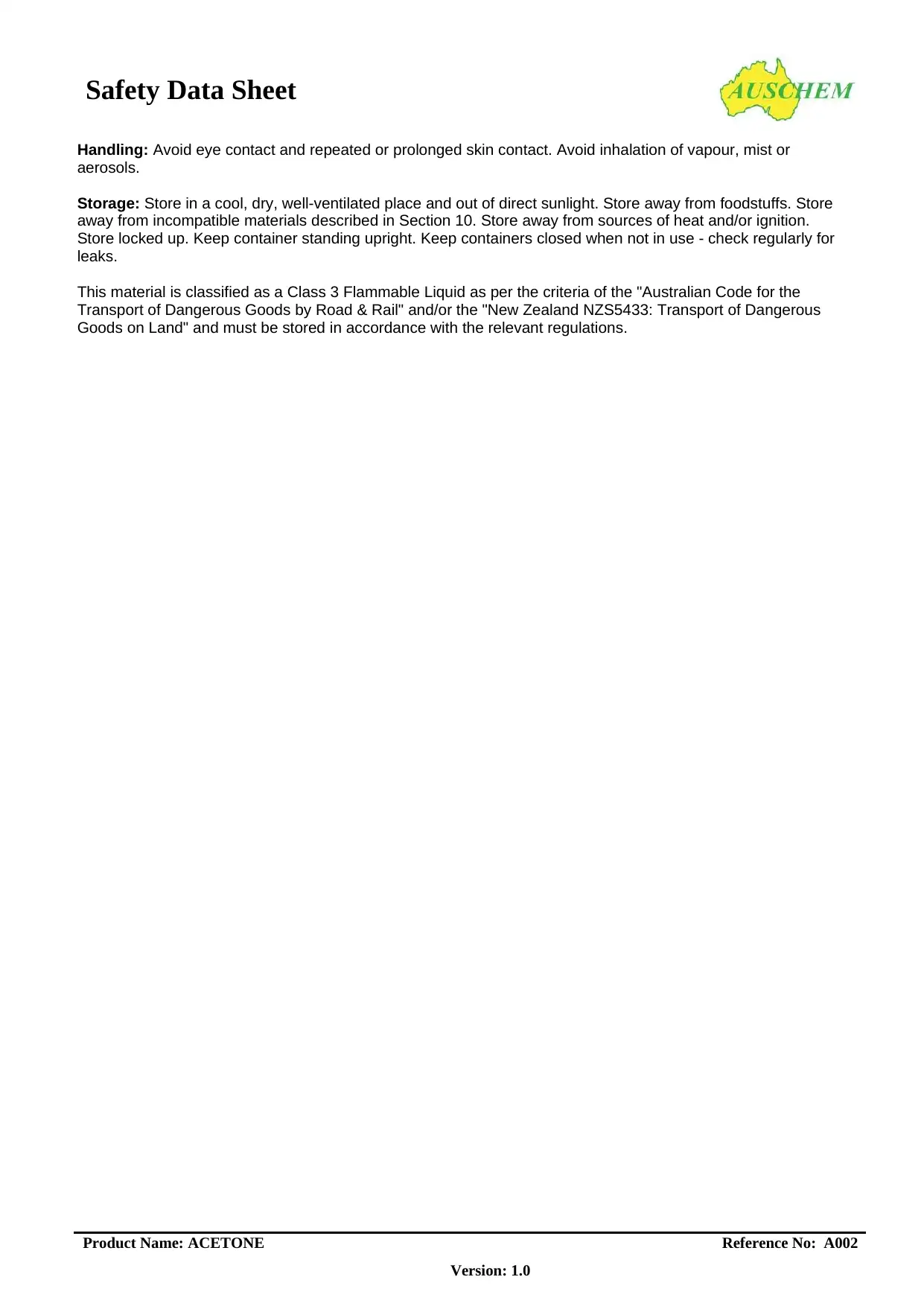
Safety Data Sheet
Product Name: ACETONE Reference No: A002
Version: 1.0
Handling: Avoid eye contact and repeated or prolonged skin contact. Avoid inhalation of vapour, mist or
aerosols.
Storage: Store in a cool, dry, well-ventilated place and out of direct sunlight. Store away from foodstuffs. Store
away from incompatible materials described in Section 10. Store away from sources of heat and/or ignition.
Store locked up. Keep container standing upright. Keep containers closed when not in use - check regularly for
leaks.
This material is classified as a Class 3 Flammable Liquid as per the criteria of the "Australian Code for the
Transport of Dangerous Goods by Road & Rail" and/or the "New Zealand NZS5433: Transport of Dangerous
Goods on Land" and must be stored in accordance with the relevant regulations.
Product Name: ACETONE Reference No: A002
Version: 1.0
Handling: Avoid eye contact and repeated or prolonged skin contact. Avoid inhalation of vapour, mist or
aerosols.
Storage: Store in a cool, dry, well-ventilated place and out of direct sunlight. Store away from foodstuffs. Store
away from incompatible materials described in Section 10. Store away from sources of heat and/or ignition.
Store locked up. Keep container standing upright. Keep containers closed when not in use - check regularly for
leaks.
This material is classified as a Class 3 Flammable Liquid as per the criteria of the "Australian Code for the
Transport of Dangerous Goods by Road & Rail" and/or the "New Zealand NZS5433: Transport of Dangerous
Goods on Land" and must be stored in accordance with the relevant regulations.
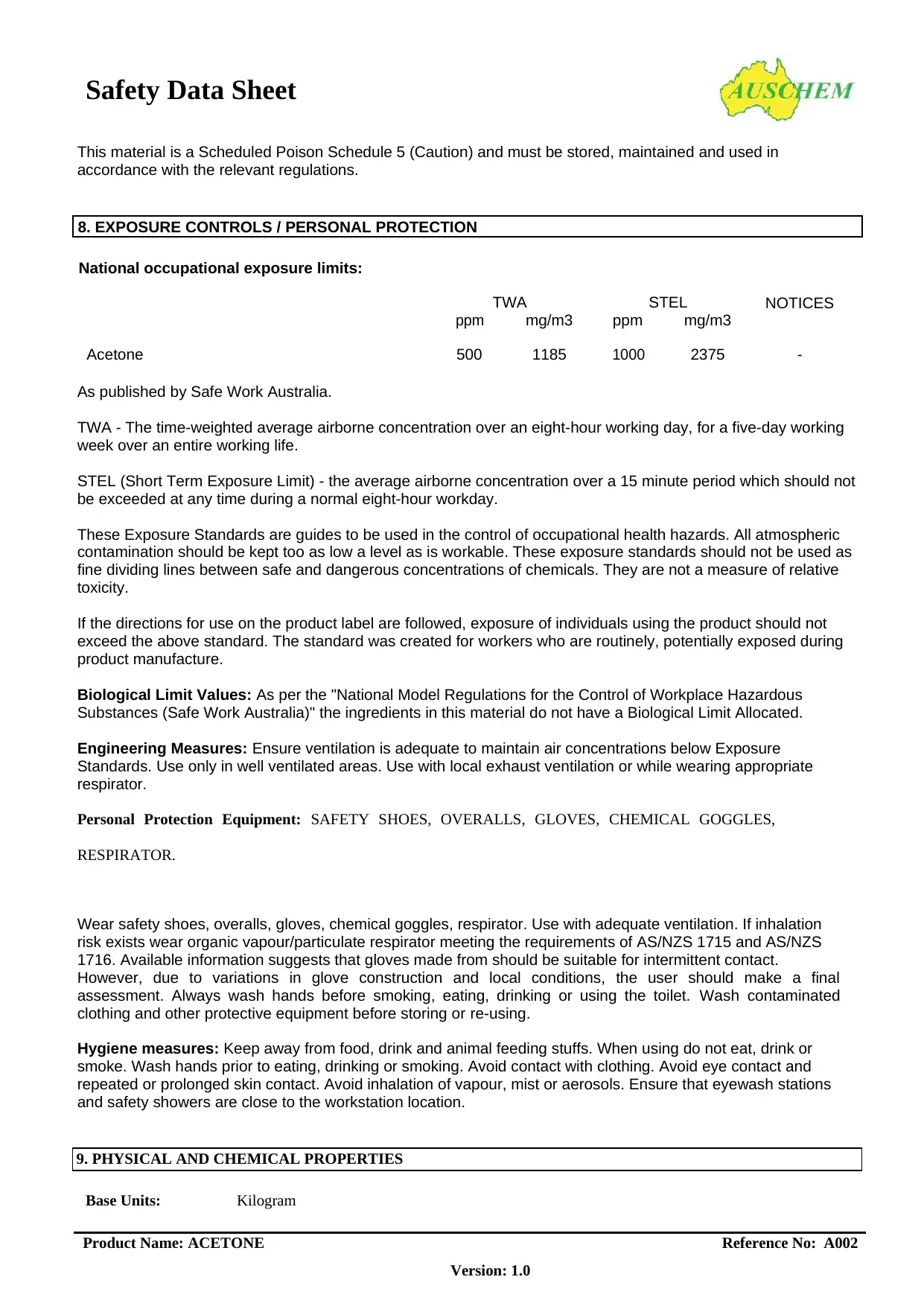
9. PHYSICAL AND CHEMICAL PROPERTIES
Safety Data Sheet
Product Name: ACETONE Reference No: A002
Version: 1.0
This material is a Scheduled Poison Schedule 5 (Caution) and must be stored, maintained and used in
accordance with the relevant regulations.
8. EXPOSURE CONTROLS / PERSONAL PROTECTION
National occupational exposure limits:
ppm
TWA
mg/m3 ppm
STEL
mg/m3
NOTICES
Acetone 500 1185 1000 2375 -
As published by Safe Work Australia.
TWA - The time-weighted average airborne concentration over an eight-hour working day, for a five-day working
week over an entire working life.
STEL (Short Term Exposure Limit) - the average airborne concentration over a 15 minute period which should not
be exceeded at any time during a normal eight-hour workday.
These Exposure Standards are guides to be used in the control of occupational health hazards. All atmospheric
contamination should be kept too as low a level as is workable. These exposure standards should not be used as
fine dividing lines between safe and dangerous concentrations of chemicals. They are not a measure of relative
toxicity.
If the directions for use on the product label are followed, exposure of individuals using the product should not
exceed the above standard. The standard was created for workers who are routinely, potentially exposed during
product manufacture.
Biological Limit Values: As per the "National Model Regulations for the Control of Workplace Hazardous
Substances (Safe Work Australia)" the ingredients in this material do not have a Biological Limit Allocated.
Engineering Measures: Ensure ventilation is adequate to maintain air concentrations below Exposure
Standards. Use only in well ventilated areas. Use with local exhaust ventilation or while wearing appropriate
respirator.
Personal Protection Equipment: SAFETY SHOES, OVERALLS, GLOVES, CHEMICAL GOGGLES,
RESPIRATOR.
Wear safety shoes, overalls, gloves, chemical goggles, respirator. Use with adequate ventilation. If inhalation
risk exists wear organic vapour/particulate respirator meeting the requirements of AS/NZS 1715 and AS/NZS
1716. Available information suggests that gloves made from should be suitable for intermittent contact.
However, due to variations in glove construction and local conditions, the user should make a final
assessment. Always wash hands before smoking, eating, drinking or using the toilet. Wash contaminated
clothing and other protective equipment before storing or re-using.
Hygiene measures: Keep away from food, drink and animal feeding stuffs. When using do not eat, drink or
smoke. Wash hands prior to eating, drinking or smoking. Avoid contact with clothing. Avoid eye contact and
repeated or prolonged skin contact. Avoid inhalation of vapour, mist or aerosols. Ensure that eyewash stations
and safety showers are close to the workstation location.
Base Units: Kilogram
Safety Data Sheet
Product Name: ACETONE Reference No: A002
Version: 1.0
This material is a Scheduled Poison Schedule 5 (Caution) and must be stored, maintained and used in
accordance with the relevant regulations.
8. EXPOSURE CONTROLS / PERSONAL PROTECTION
National occupational exposure limits:
ppm
TWA
mg/m3 ppm
STEL
mg/m3
NOTICES
Acetone 500 1185 1000 2375 -
As published by Safe Work Australia.
TWA - The time-weighted average airborne concentration over an eight-hour working day, for a five-day working
week over an entire working life.
STEL (Short Term Exposure Limit) - the average airborne concentration over a 15 minute period which should not
be exceeded at any time during a normal eight-hour workday.
These Exposure Standards are guides to be used in the control of occupational health hazards. All atmospheric
contamination should be kept too as low a level as is workable. These exposure standards should not be used as
fine dividing lines between safe and dangerous concentrations of chemicals. They are not a measure of relative
toxicity.
If the directions for use on the product label are followed, exposure of individuals using the product should not
exceed the above standard. The standard was created for workers who are routinely, potentially exposed during
product manufacture.
Biological Limit Values: As per the "National Model Regulations for the Control of Workplace Hazardous
Substances (Safe Work Australia)" the ingredients in this material do not have a Biological Limit Allocated.
Engineering Measures: Ensure ventilation is adequate to maintain air concentrations below Exposure
Standards. Use only in well ventilated areas. Use with local exhaust ventilation or while wearing appropriate
respirator.
Personal Protection Equipment: SAFETY SHOES, OVERALLS, GLOVES, CHEMICAL GOGGLES,
RESPIRATOR.
Wear safety shoes, overalls, gloves, chemical goggles, respirator. Use with adequate ventilation. If inhalation
risk exists wear organic vapour/particulate respirator meeting the requirements of AS/NZS 1715 and AS/NZS
1716. Available information suggests that gloves made from should be suitable for intermittent contact.
However, due to variations in glove construction and local conditions, the user should make a final
assessment. Always wash hands before smoking, eating, drinking or using the toilet. Wash contaminated
clothing and other protective equipment before storing or re-using.
Hygiene measures: Keep away from food, drink and animal feeding stuffs. When using do not eat, drink or
smoke. Wash hands prior to eating, drinking or smoking. Avoid contact with clothing. Avoid eye contact and
repeated or prolonged skin contact. Avoid inhalation of vapour, mist or aerosols. Ensure that eyewash stations
and safety showers are close to the workstation location.
Base Units: Kilogram
Paraphrase This Document
Need a fresh take? Get an instant paraphrase of this document with our AI Paraphraser
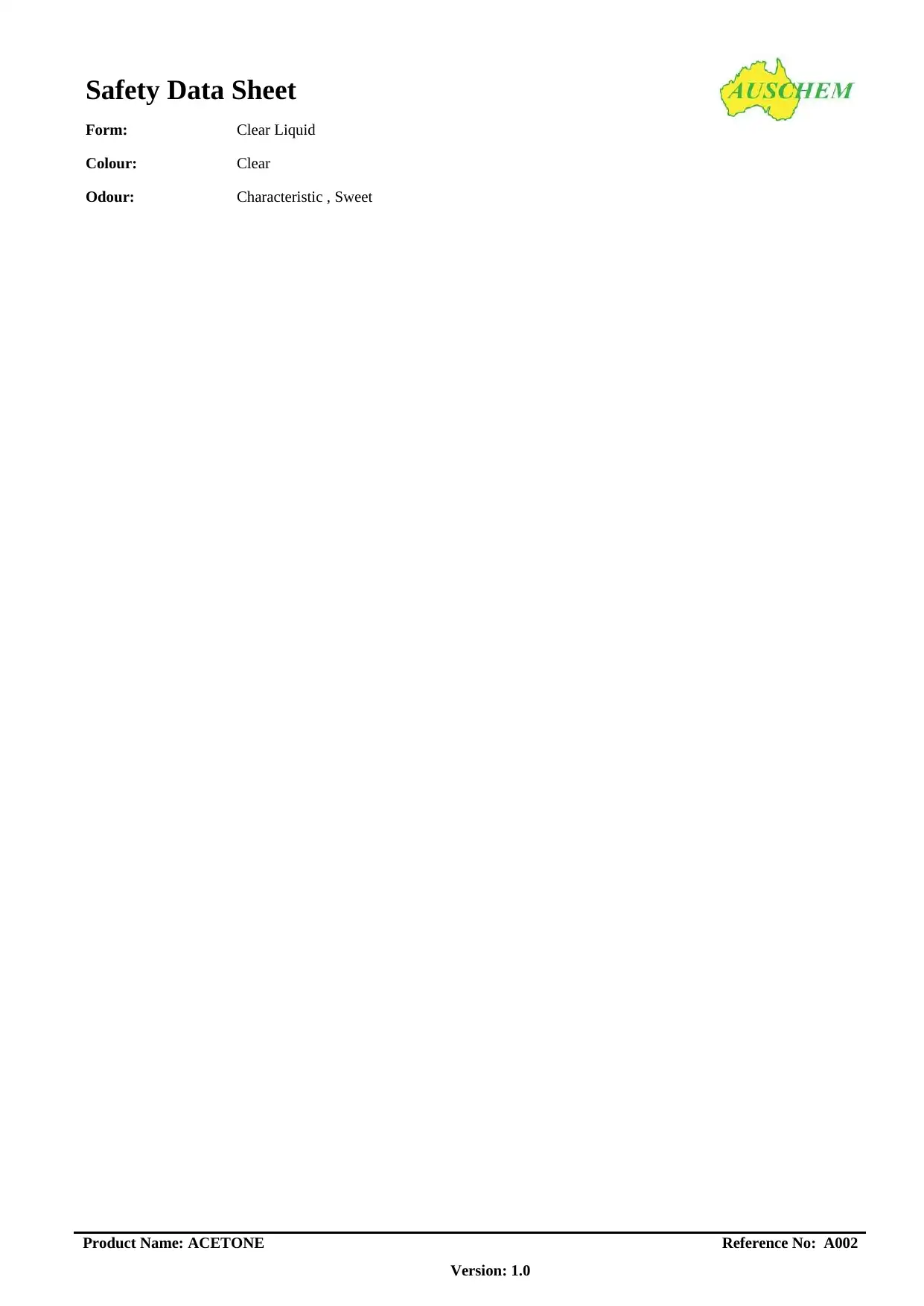
Safety Data Sheet
Product Name: ACETONE Reference No: A002
Version: 1.0
Form: Clear Liquid
Colour: Clear
Odour: Characteristic , Sweet
Product Name: ACETONE Reference No: A002
Version: 1.0
Form: Clear Liquid
Colour: Clear
Odour: Characteristic , Sweet
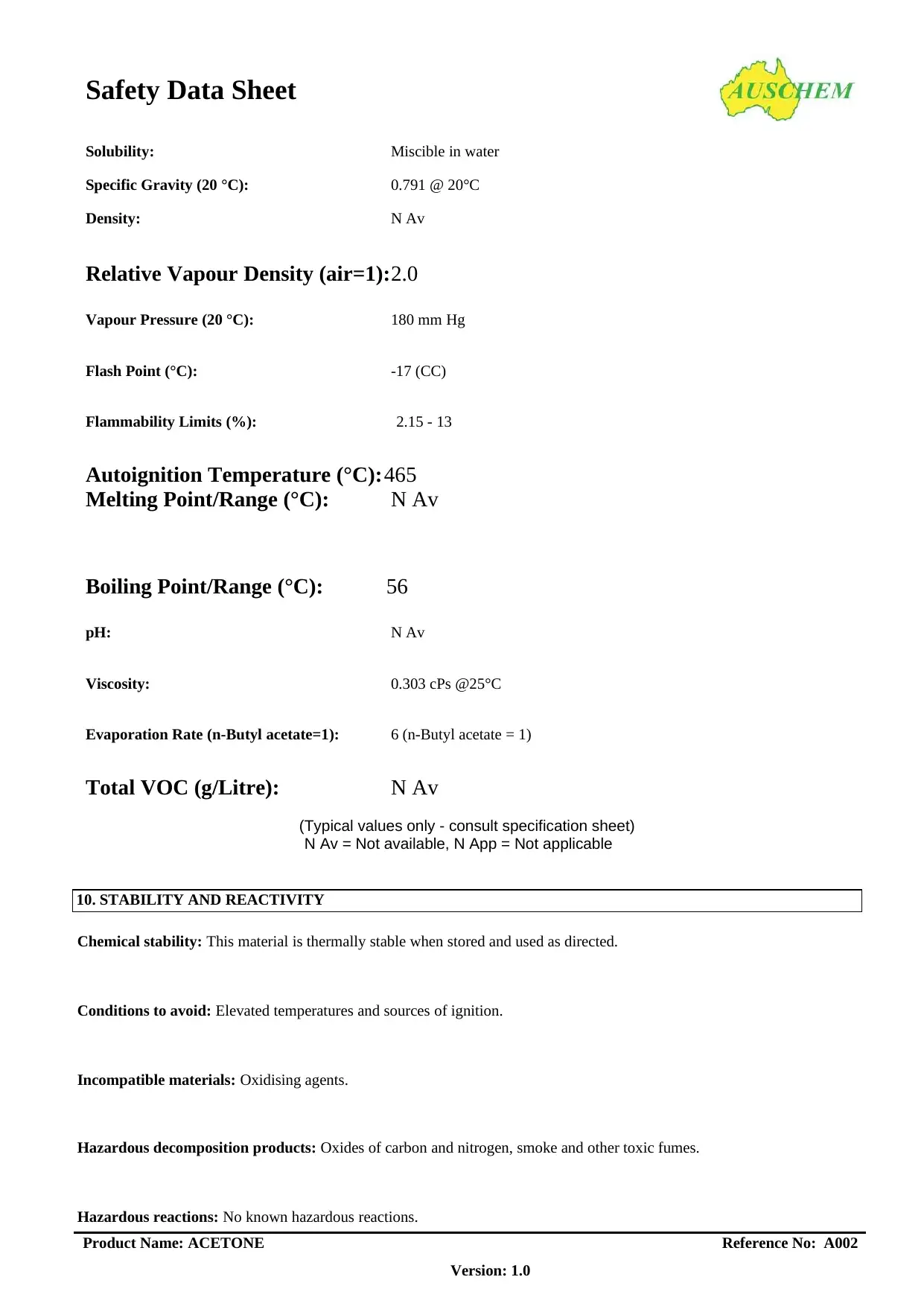
10. STABILITY AND REACTIVITY
Safety Data Sheet
Product Name: ACETONE Reference No: A002
Version: 1.0
Solubility: Miscible in water
Specific Gravity (20 °C): 0.791 @ 20°C
Density: N Av
Relative Vapour Density (air=1):2.0
Vapour Pressure (20 °C): 180 mm Hg
Flash Point (°C): -17 (CC)
Flammability Limits (%): 2.15 - 13
Autoignition Temperature (°C):465
Melting Point/Range (°C): N Av
Boiling Point/Range (°C): 56
pH: N Av
Viscosity: 0.303 cPs @25°C
Evaporation Rate (n-Butyl acetate=1): 6 (n-Butyl acetate = 1)
Total VOC (g/Litre): N Av
(Typical values only - consult specification sheet)
N Av = Not available, N App = Not applicable
Chemical stability: This material is thermally stable when stored and used as directed.
Conditions to avoid: Elevated temperatures and sources of ignition.
Incompatible materials: Oxidising agents.
Hazardous decomposition products: Oxides of carbon and nitrogen, smoke and other toxic fumes.
Hazardous reactions: No known hazardous reactions.
Safety Data Sheet
Product Name: ACETONE Reference No: A002
Version: 1.0
Solubility: Miscible in water
Specific Gravity (20 °C): 0.791 @ 20°C
Density: N Av
Relative Vapour Density (air=1):2.0
Vapour Pressure (20 °C): 180 mm Hg
Flash Point (°C): -17 (CC)
Flammability Limits (%): 2.15 - 13
Autoignition Temperature (°C):465
Melting Point/Range (°C): N Av
Boiling Point/Range (°C): 56
pH: N Av
Viscosity: 0.303 cPs @25°C
Evaporation Rate (n-Butyl acetate=1): 6 (n-Butyl acetate = 1)
Total VOC (g/Litre): N Av
(Typical values only - consult specification sheet)
N Av = Not available, N App = Not applicable
Chemical stability: This material is thermally stable when stored and used as directed.
Conditions to avoid: Elevated temperatures and sources of ignition.
Incompatible materials: Oxidising agents.
Hazardous decomposition products: Oxides of carbon and nitrogen, smoke and other toxic fumes.
Hazardous reactions: No known hazardous reactions.
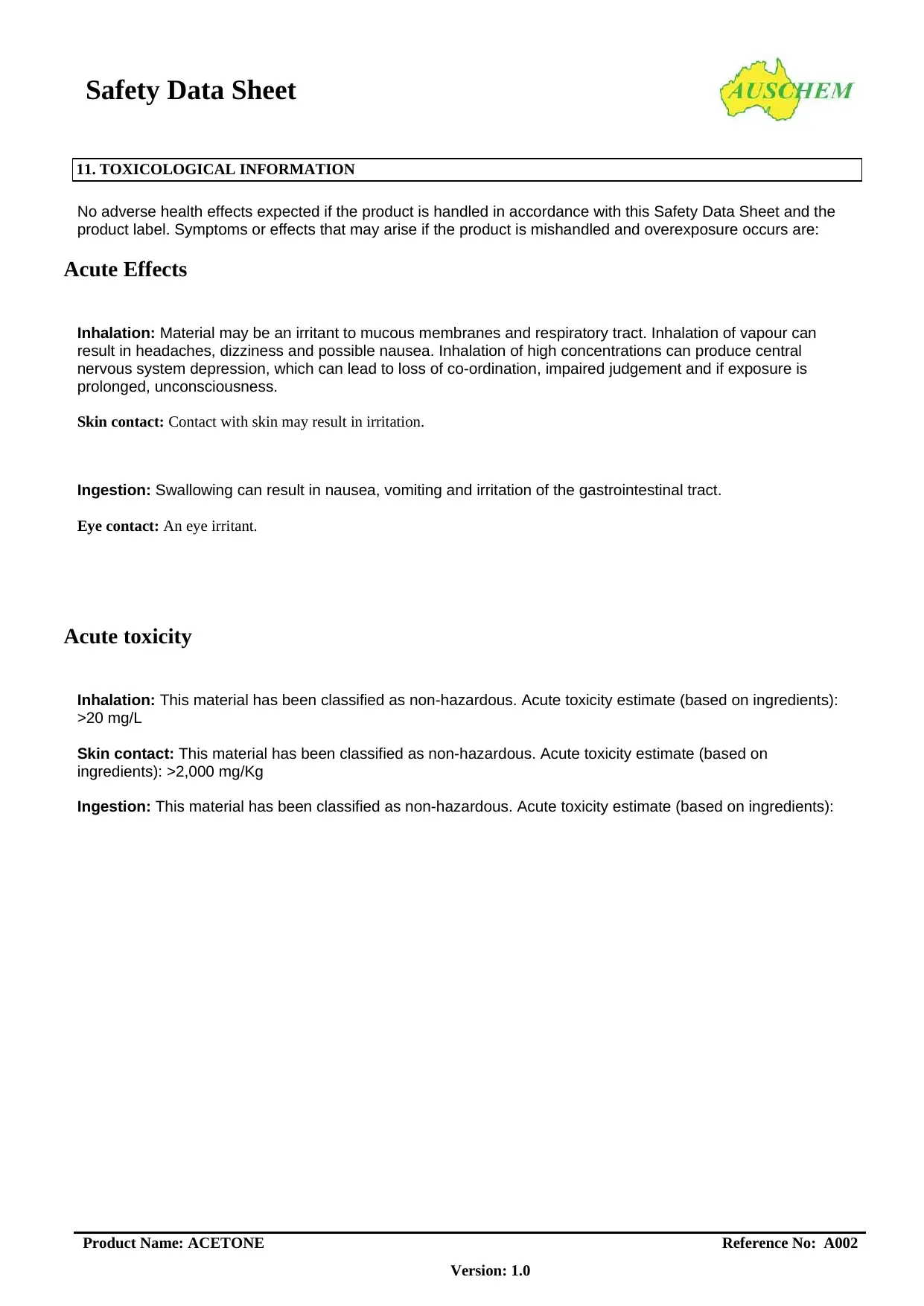
11. TOXICOLOGICAL INFORMATION
Safety Data Sheet
Product Name: ACETONE Reference No: A002
Version: 1.0
No adverse health effects expected if the product is handled in accordance with this Safety Data Sheet and the
product label. Symptoms or effects that may arise if the product is mishandled and overexposure occurs are:
Acute Effects
Inhalation: Material may be an irritant to mucous membranes and respiratory tract. Inhalation of vapour can
result in headaches, dizziness and possible nausea. Inhalation of high concentrations can produce central
nervous system depression, which can lead to loss of co-ordination, impaired judgement and if exposure is
prolonged, unconsciousness.
Skin contact: Contact with skin may result in irritation.
Ingestion: Swallowing can result in nausea, vomiting and irritation of the gastrointestinal tract.
Eye contact: An eye irritant.
Acute toxicity
Inhalation: This material has been classified as non-hazardous. Acute toxicity estimate (based on ingredients):
>20 mg/L
Skin contact: This material has been classified as non-hazardous. Acute toxicity estimate (based on
ingredients): >2,000 mg/Kg
Ingestion: This material has been classified as non-hazardous. Acute toxicity estimate (based on ingredients):
Safety Data Sheet
Product Name: ACETONE Reference No: A002
Version: 1.0
No adverse health effects expected if the product is handled in accordance with this Safety Data Sheet and the
product label. Symptoms or effects that may arise if the product is mishandled and overexposure occurs are:
Acute Effects
Inhalation: Material may be an irritant to mucous membranes and respiratory tract. Inhalation of vapour can
result in headaches, dizziness and possible nausea. Inhalation of high concentrations can produce central
nervous system depression, which can lead to loss of co-ordination, impaired judgement and if exposure is
prolonged, unconsciousness.
Skin contact: Contact with skin may result in irritation.
Ingestion: Swallowing can result in nausea, vomiting and irritation of the gastrointestinal tract.
Eye contact: An eye irritant.
Acute toxicity
Inhalation: This material has been classified as non-hazardous. Acute toxicity estimate (based on ingredients):
>20 mg/L
Skin contact: This material has been classified as non-hazardous. Acute toxicity estimate (based on
ingredients): >2,000 mg/Kg
Ingestion: This material has been classified as non-hazardous. Acute toxicity estimate (based on ingredients):
Secure Best Marks with AI Grader
Need help grading? Try our AI Grader for instant feedback on your assignments.
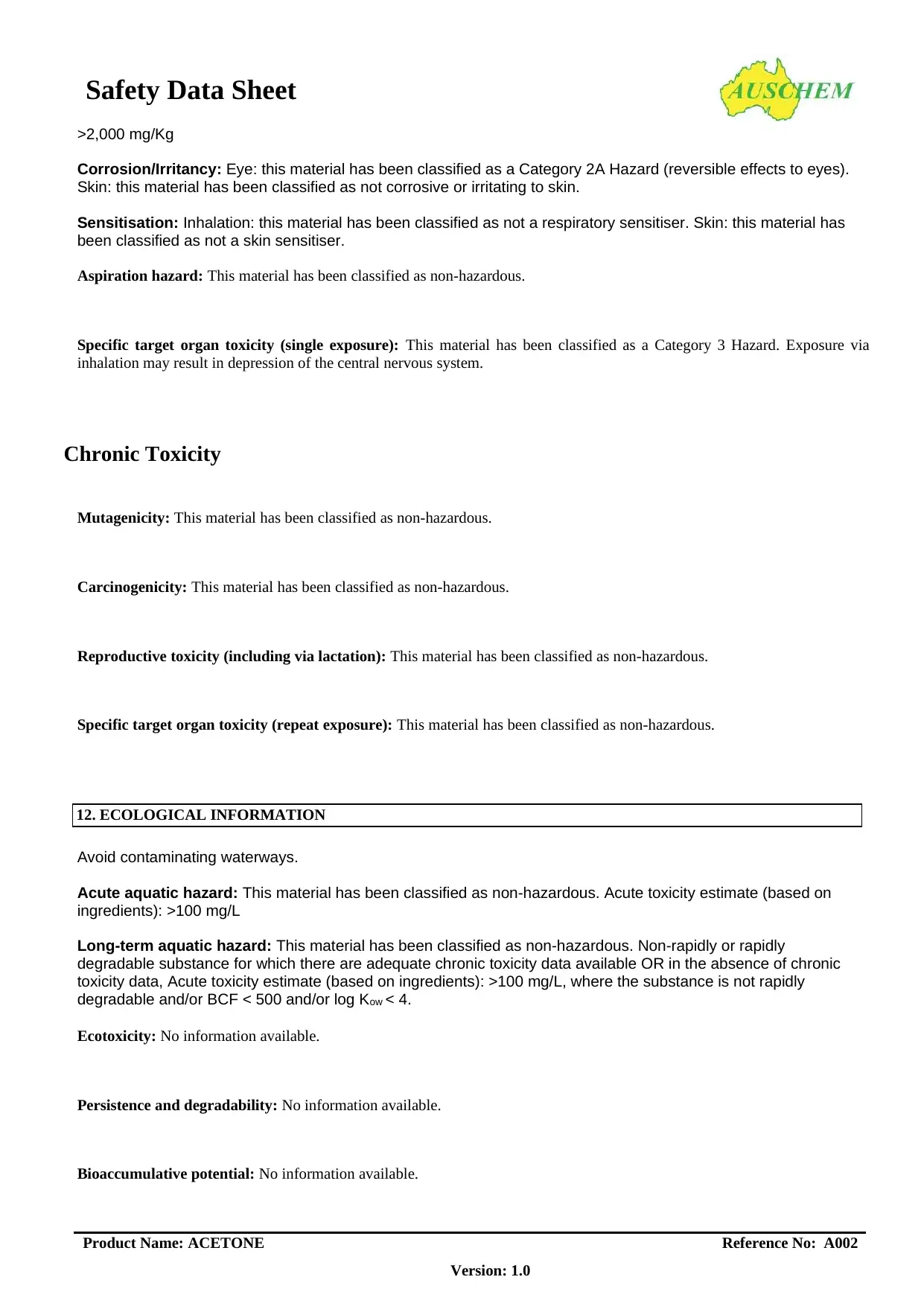
12. ECOLOGICAL INFORMATION
Safety Data Sheet
Version: 1.0
Reference No: A002Product Name: ACETONE
>2,000 mg/Kg
Corrosion/Irritancy: Eye: this material has been classified as a Category 2A Hazard (reversible effects to eyes).
Skin: this material has been classified as not corrosive or irritating to skin.
Sensitisation: Inhalation: this material has been classified as not a respiratory sensitiser. Skin: this material has
been classified as not a skin sensitiser.
Aspiration hazard: This material has been classified as non-hazardous.
Specific target organ toxicity (single exposure): This material has been classified as a Category 3 Hazard. Exposure via
inhalation may result in depression of the central nervous system.
Chronic Toxicity
Mutagenicity: This material has been classified as non-hazardous.
Carcinogenicity: This material has been classified as non-hazardous.
Reproductive toxicity (including via lactation): This material has been classified as non-hazardous.
Specific target organ toxicity (repeat exposure): This material has been classified as non-hazardous.
Avoid contaminating waterways.
Acute aquatic hazard: This material has been classified as non-hazardous. Acute toxicity estimate (based on
ingredients): >100 mg/L
Long-term aquatic hazard: This material has been classified as non-hazardous. Non-rapidly or rapidly
degradable substance for which there are adequate chronic toxicity data available OR in the absence of chronic
toxicity data, Acute toxicity estimate (based on ingredients): >100 mg/L, where the substance is not rapidly
degradable and/or BCF < 500 and/or log Kow < 4.
Ecotoxicity: No information available.
Persistence and degradability: No information available.
Bioaccumulative potential: No information available.
Safety Data Sheet
Version: 1.0
Reference No: A002Product Name: ACETONE
>2,000 mg/Kg
Corrosion/Irritancy: Eye: this material has been classified as a Category 2A Hazard (reversible effects to eyes).
Skin: this material has been classified as not corrosive or irritating to skin.
Sensitisation: Inhalation: this material has been classified as not a respiratory sensitiser. Skin: this material has
been classified as not a skin sensitiser.
Aspiration hazard: This material has been classified as non-hazardous.
Specific target organ toxicity (single exposure): This material has been classified as a Category 3 Hazard. Exposure via
inhalation may result in depression of the central nervous system.
Chronic Toxicity
Mutagenicity: This material has been classified as non-hazardous.
Carcinogenicity: This material has been classified as non-hazardous.
Reproductive toxicity (including via lactation): This material has been classified as non-hazardous.
Specific target organ toxicity (repeat exposure): This material has been classified as non-hazardous.
Avoid contaminating waterways.
Acute aquatic hazard: This material has been classified as non-hazardous. Acute toxicity estimate (based on
ingredients): >100 mg/L
Long-term aquatic hazard: This material has been classified as non-hazardous. Non-rapidly or rapidly
degradable substance for which there are adequate chronic toxicity data available OR in the absence of chronic
toxicity data, Acute toxicity estimate (based on ingredients): >100 mg/L, where the substance is not rapidly
degradable and/or BCF < 500 and/or log Kow < 4.
Ecotoxicity: No information available.
Persistence and degradability: No information available.
Bioaccumulative potential: No information available.
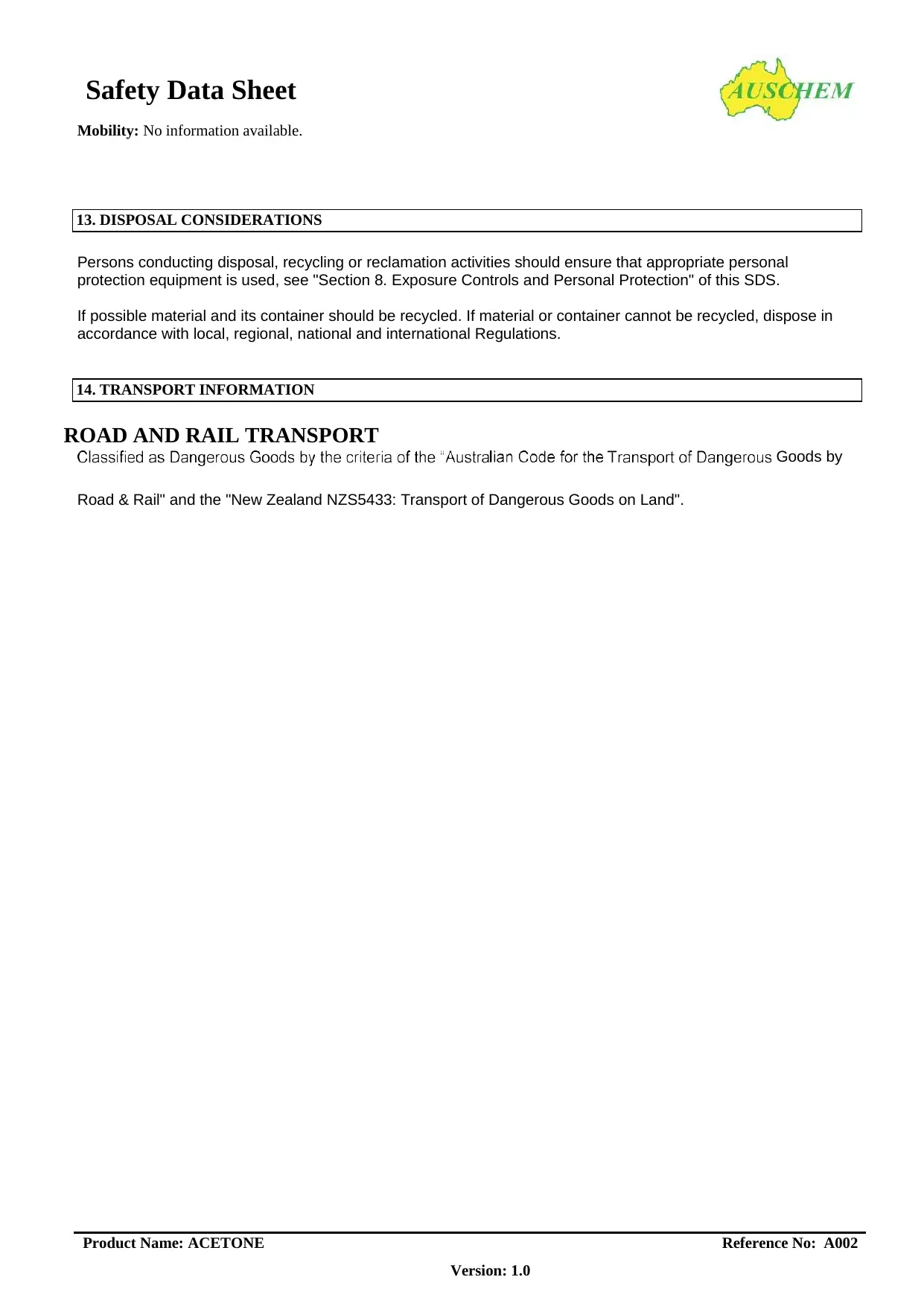
13. DISPOSAL CONSIDERATIONS
14. TRANSPORT INFORMATION
Safety Data Sheet
Version: 1.0
Reference No: A002Product Name: ACETONE
Mobility: No information available.
Persons conducting disposal, recycling or reclamation activities should ensure that appropriate personal
protection equipment is used, see "Section 8. Exposure Controls and Personal Protection" of this SDS.
If possible material and its container should be recycled. If material or container cannot be recycled, dispose in
accordance with local, regional, national and international Regulations.
ROAD AND RAIL TRANSPORT
Road & Rail" and the "New Zealand NZS5433: Transport of Dangerous Goods on Land".
Goods by
14. TRANSPORT INFORMATION
Safety Data Sheet
Version: 1.0
Reference No: A002Product Name: ACETONE
Mobility: No information available.
Persons conducting disposal, recycling or reclamation activities should ensure that appropriate personal
protection equipment is used, see "Section 8. Exposure Controls and Personal Protection" of this SDS.
If possible material and its container should be recycled. If material or container cannot be recycled, dispose in
accordance with local, regional, national and international Regulations.
ROAD AND RAIL TRANSPORT
Road & Rail" and the "New Zealand NZS5433: Transport of Dangerous Goods on Land".
Goods by
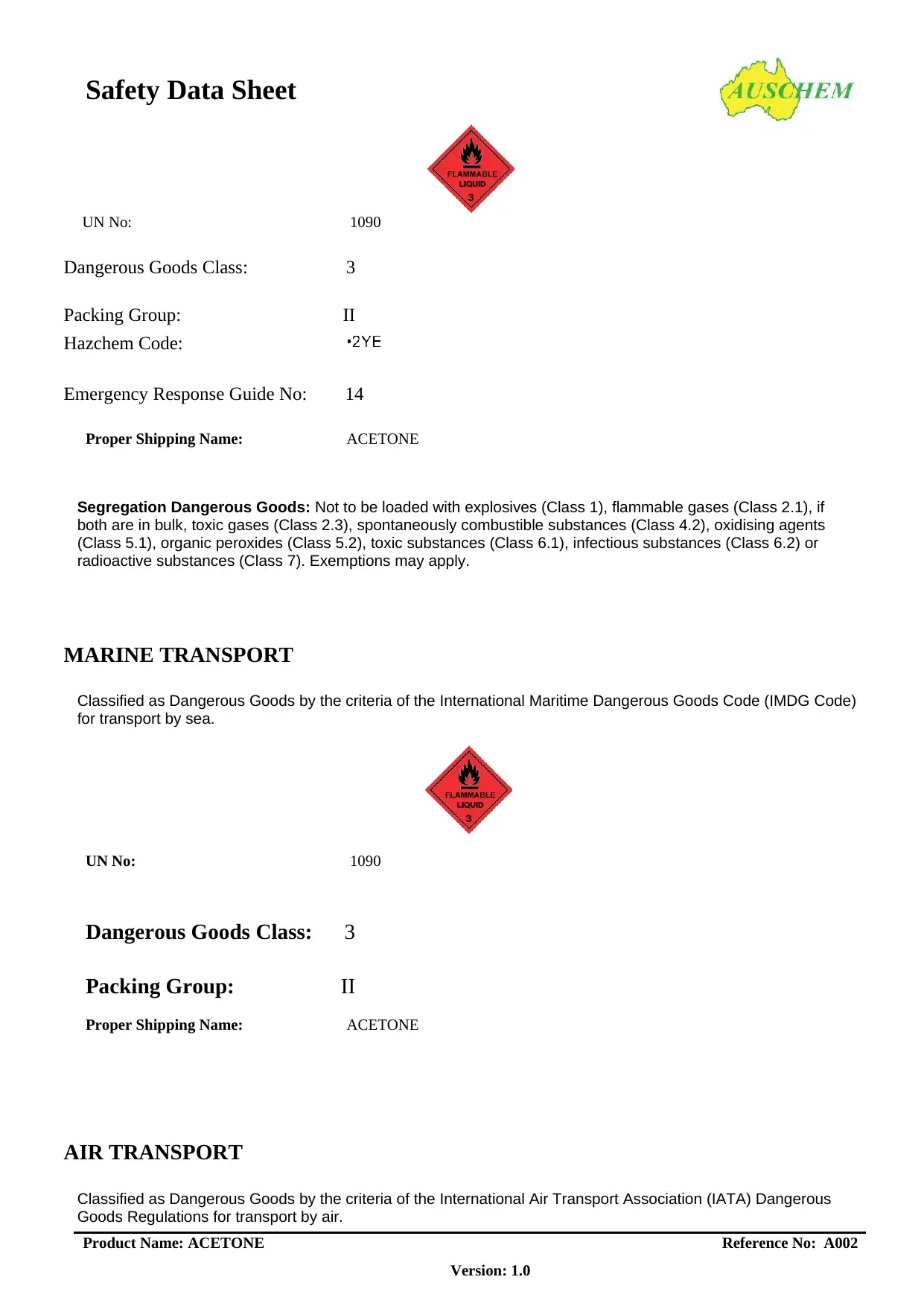
Safety Data Sheet
Version: 1.0
Reference No: A002Product Name: ACETONE
UN No: 1090
Dangerous Goods Class: 3
Packing Group: II
Hazchem Code:
Emergency Response Guide No: 14
Proper Shipping Name: ACETONE
Segregation Dangerous Goods: Not to be loaded with explosives (Class 1), flammable gases (Class 2.1), if
both are in bulk, toxic gases (Class 2.3), spontaneously combustible substances (Class 4.2), oxidising agents
(Class 5.1), organic peroxides (Class 5.2), toxic substances (Class 6.1), infectious substances (Class 6.2) or
radioactive substances (Class 7). Exemptions may apply.
MARINE TRANSPORT
Classified as Dangerous Goods by the criteria of the International Maritime Dangerous Goods Code (IMDG Code)
for transport by sea.
UN No: 1090
Dangerous Goods Class: 3
Packing Group: II
Proper Shipping Name: ACETONE
AIR TRANSPORT
Classified as Dangerous Goods by the criteria of the International Air Transport Association (IATA) Dangerous
Goods Regulations for transport by air.
Version: 1.0
Reference No: A002Product Name: ACETONE
UN No: 1090
Dangerous Goods Class: 3
Packing Group: II
Hazchem Code:
Emergency Response Guide No: 14
Proper Shipping Name: ACETONE
Segregation Dangerous Goods: Not to be loaded with explosives (Class 1), flammable gases (Class 2.1), if
both are in bulk, toxic gases (Class 2.3), spontaneously combustible substances (Class 4.2), oxidising agents
(Class 5.1), organic peroxides (Class 5.2), toxic substances (Class 6.1), infectious substances (Class 6.2) or
radioactive substances (Class 7). Exemptions may apply.
MARINE TRANSPORT
Classified as Dangerous Goods by the criteria of the International Maritime Dangerous Goods Code (IMDG Code)
for transport by sea.
UN No: 1090
Dangerous Goods Class: 3
Packing Group: II
Proper Shipping Name: ACETONE
AIR TRANSPORT
Classified as Dangerous Goods by the criteria of the International Air Transport Association (IATA) Dangerous
Goods Regulations for transport by air.
Paraphrase This Document
Need a fresh take? Get an instant paraphrase of this document with our AI Paraphraser
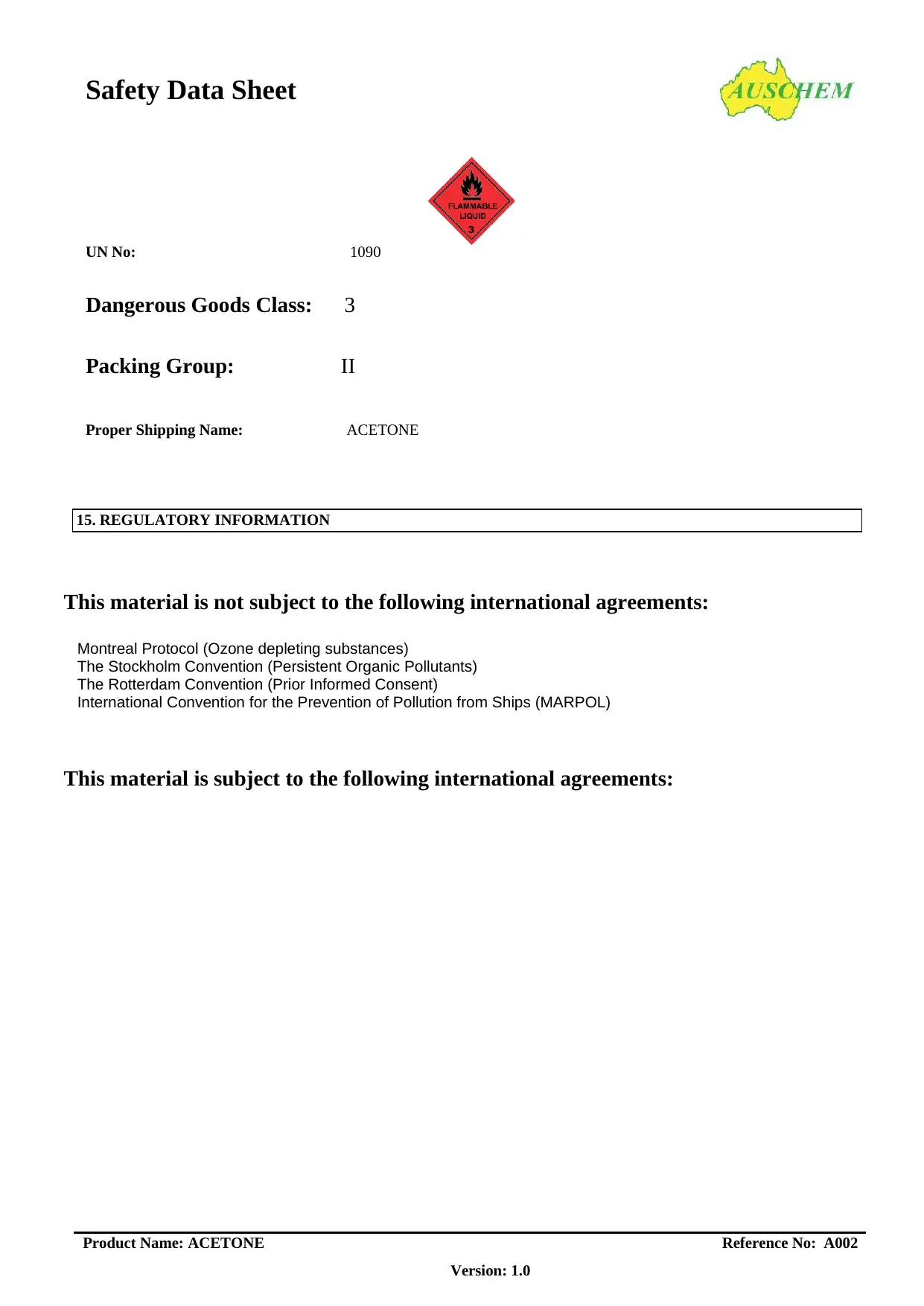
15. REGULATORY INFORMATION
Safety Data Sheet
Version: 1.0
Reference No: A002Product Name: ACETONE
UN No: 1090
Dangerous Goods Class: 3
Packing Group: II
Proper Shipping Name: ACETONE
This material is not subject to the following international agreements:
Montreal Protocol (Ozone depleting substances)
The Stockholm Convention (Persistent Organic Pollutants)
The Rotterdam Convention (Prior Informed Consent)
International Convention for the Prevention of Pollution from Ships (MARPOL)
This material is subject to the following international agreements:
Safety Data Sheet
Version: 1.0
Reference No: A002Product Name: ACETONE
UN No: 1090
Dangerous Goods Class: 3
Packing Group: II
Proper Shipping Name: ACETONE
This material is not subject to the following international agreements:
Montreal Protocol (Ozone depleting substances)
The Stockholm Convention (Persistent Organic Pollutants)
The Rotterdam Convention (Prior Informed Consent)
International Convention for the Prevention of Pollution from Ships (MARPOL)
This material is subject to the following international agreements:
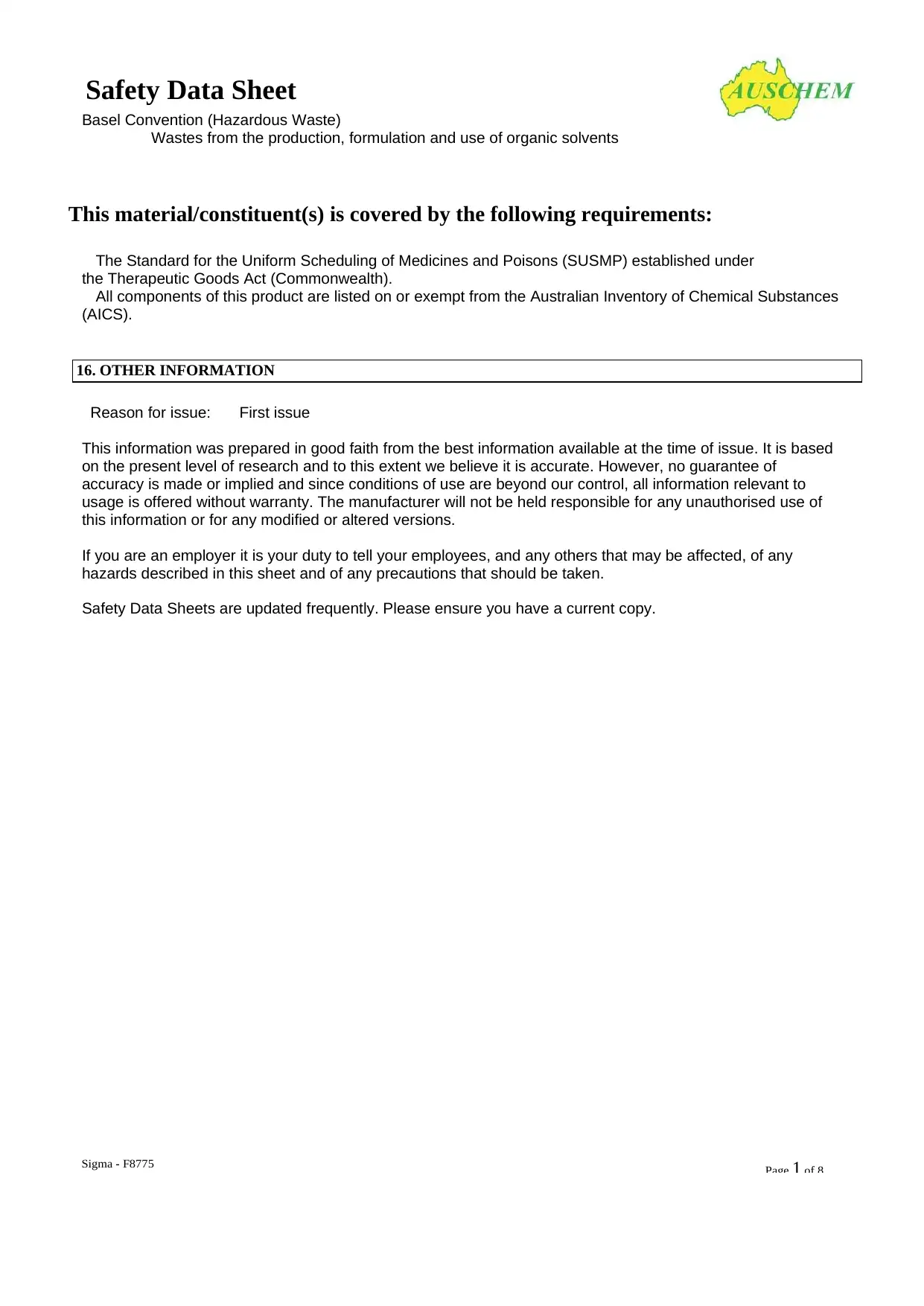
Page 1 of 8
Sigma - F8775
16. OTHER INFORMATION
Safety Data Sheet
Basel Convention (Hazardous Waste)
Wastes from the production, formulation and use of organic solvents
This material/constituent(s) is covered by the following requirements:
The Standard for the Uniform Scheduling of Medicines and Poisons (SUSMP) established under
the Therapeutic Goods Act (Commonwealth).
All components of this product are listed on or exempt from the Australian Inventory of Chemical Substances
(AICS).
Reason for issue: First issue
This information was prepared in good faith from the best information available at the time of issue. It is based
on the present level of research and to this extent we believe it is accurate. However, no guarantee of
accuracy is made or implied and since conditions of use are beyond our control, all information relevant to
usage is offered without warranty. The manufacturer will not be held responsible for any unauthorised use of
this information or for any modified or altered versions.
If you are an employer it is your duty to tell your employees, and any others that may be affected, of any
hazards described in this sheet and of any precautions that should be taken.
Safety Data Sheets are updated frequently. Please ensure you have a current copy.
Sigma - F8775
16. OTHER INFORMATION
Safety Data Sheet
Basel Convention (Hazardous Waste)
Wastes from the production, formulation and use of organic solvents
This material/constituent(s) is covered by the following requirements:
The Standard for the Uniform Scheduling of Medicines and Poisons (SUSMP) established under
the Therapeutic Goods Act (Commonwealth).
All components of this product are listed on or exempt from the Australian Inventory of Chemical Substances
(AICS).
Reason for issue: First issue
This information was prepared in good faith from the best information available at the time of issue. It is based
on the present level of research and to this extent we believe it is accurate. However, no guarantee of
accuracy is made or implied and since conditions of use are beyond our control, all information relevant to
usage is offered without warranty. The manufacturer will not be held responsible for any unauthorised use of
this information or for any modified or altered versions.
If you are an employer it is your duty to tell your employees, and any others that may be affected, of any
hazards described in this sheet and of any precautions that should be taken.
Safety Data Sheets are updated frequently. Please ensure you have a current copy.
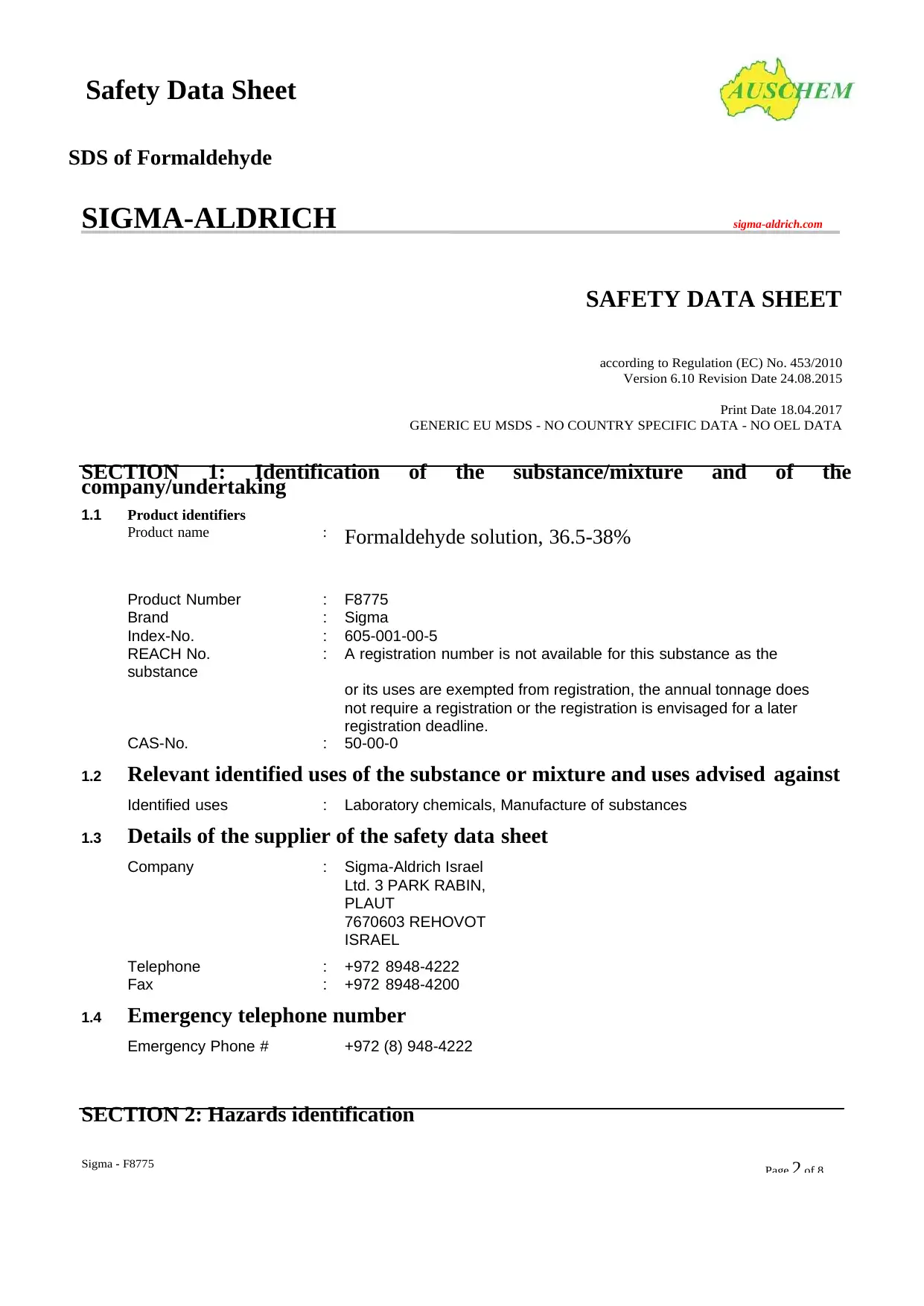
Page 2 of 8
Sigma - F8775
Safety Data Sheet
SDS of Formaldehyde
SIGMA-ALDRICH sigma-aldrich.com
SAFETY DATA SHEET
according to Regulation (EC) No. 453/2010
Version 6.10 Revision Date 24.08.2015
Print Date 18.04.2017
GENERIC EU MSDS - NO COUNTRY SPECIFIC DATA - NO OEL DATA
SECTION 1: Identification of the substance/mixture and of the
company/undertaking
1.1 Product identifiers
Product name : Formaldehyde solution, 36.5-38%
Product Number : F8775
Brand : Sigma
Index-No. : 605-001-00-5
REACH No. : A registration number is not available for this substance as the
substance
or its uses are exempted from registration, the annual tonnage does
not require a registration or the registration is envisaged for a later
registration deadline.
CAS-No. : 50-00-0
1.2 Relevant identified uses of the substance or mixture and uses advised against
Identified uses : Laboratory chemicals, Manufacture of substances
1.3 Details of the supplier of the safety data sheet
Company : Sigma-Aldrich Israel
Ltd. 3 PARK RABIN,
PLAUT
7670603 REHOVOT
ISRAEL
Telephone : +972 8948-4222
Fax : +972 8948-4200
1.4 Emergency telephone number
Emergency Phone # +972 (8) 948-4222
SECTION 2: Hazards identification
Sigma - F8775
Safety Data Sheet
SDS of Formaldehyde
SIGMA-ALDRICH sigma-aldrich.com
SAFETY DATA SHEET
according to Regulation (EC) No. 453/2010
Version 6.10 Revision Date 24.08.2015
Print Date 18.04.2017
GENERIC EU MSDS - NO COUNTRY SPECIFIC DATA - NO OEL DATA
SECTION 1: Identification of the substance/mixture and of the
company/undertaking
1.1 Product identifiers
Product name : Formaldehyde solution, 36.5-38%
Product Number : F8775
Brand : Sigma
Index-No. : 605-001-00-5
REACH No. : A registration number is not available for this substance as the
substance
or its uses are exempted from registration, the annual tonnage does
not require a registration or the registration is envisaged for a later
registration deadline.
CAS-No. : 50-00-0
1.2 Relevant identified uses of the substance or mixture and uses advised against
Identified uses : Laboratory chemicals, Manufacture of substances
1.3 Details of the supplier of the safety data sheet
Company : Sigma-Aldrich Israel
Ltd. 3 PARK RABIN,
PLAUT
7670603 REHOVOT
ISRAEL
Telephone : +972 8948-4222
Fax : +972 8948-4200
1.4 Emergency telephone number
Emergency Phone # +972 (8) 948-4222
SECTION 2: Hazards identification
Secure Best Marks with AI Grader
Need help grading? Try our AI Grader for instant feedback on your assignments.
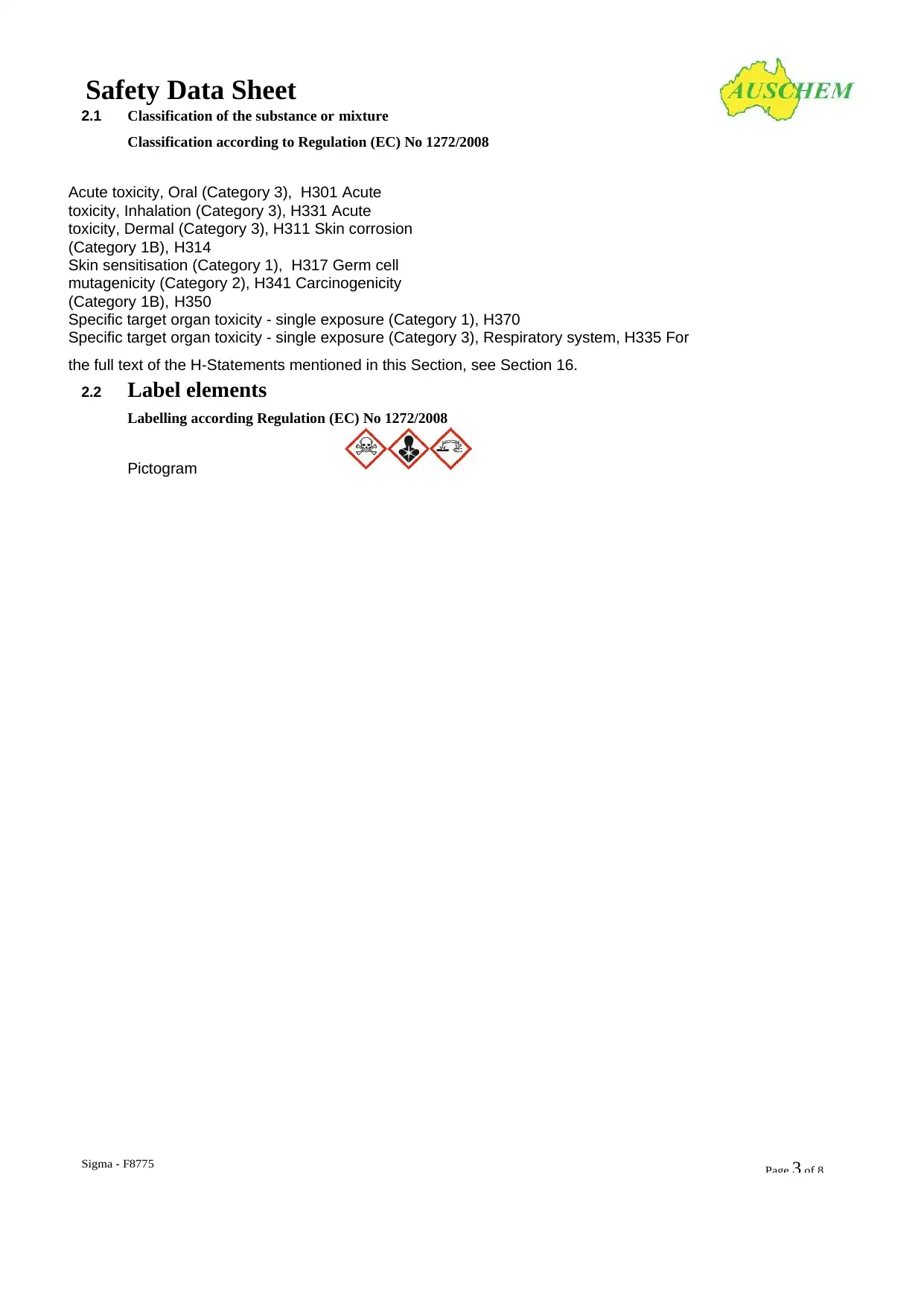
Page 3 of 8
Sigma - F8775
Safety Data Sheet
2.1 Classification of the substance or mixture
Classification according to Regulation (EC) No 1272/2008
Acute toxicity, Oral (Category 3), H301 Acute
toxicity, Inhalation (Category 3), H331 Acute
toxicity, Dermal (Category 3), H311 Skin corrosion
(Category 1B), H314
Skin sensitisation (Category 1), H317 Germ cell
mutagenicity (Category 2), H341 Carcinogenicity
(Category 1B), H350
Specific target organ toxicity - single exposure (Category 1), H370
Specific target organ toxicity - single exposure (Category 3), Respiratory system, H335 For
the full text of the H-Statements mentioned in this Section, see Section 16.
2.2 Label elements
Labelling according Regulation (EC) No 1272/2008
Pictogram
Sigma - F8775
Safety Data Sheet
2.1 Classification of the substance or mixture
Classification according to Regulation (EC) No 1272/2008
Acute toxicity, Oral (Category 3), H301 Acute
toxicity, Inhalation (Category 3), H331 Acute
toxicity, Dermal (Category 3), H311 Skin corrosion
(Category 1B), H314
Skin sensitisation (Category 1), H317 Germ cell
mutagenicity (Category 2), H341 Carcinogenicity
(Category 1B), H350
Specific target organ toxicity - single exposure (Category 1), H370
Specific target organ toxicity - single exposure (Category 3), Respiratory system, H335 For
the full text of the H-Statements mentioned in this Section, see Section 16.
2.2 Label elements
Labelling according Regulation (EC) No 1272/2008
Pictogram
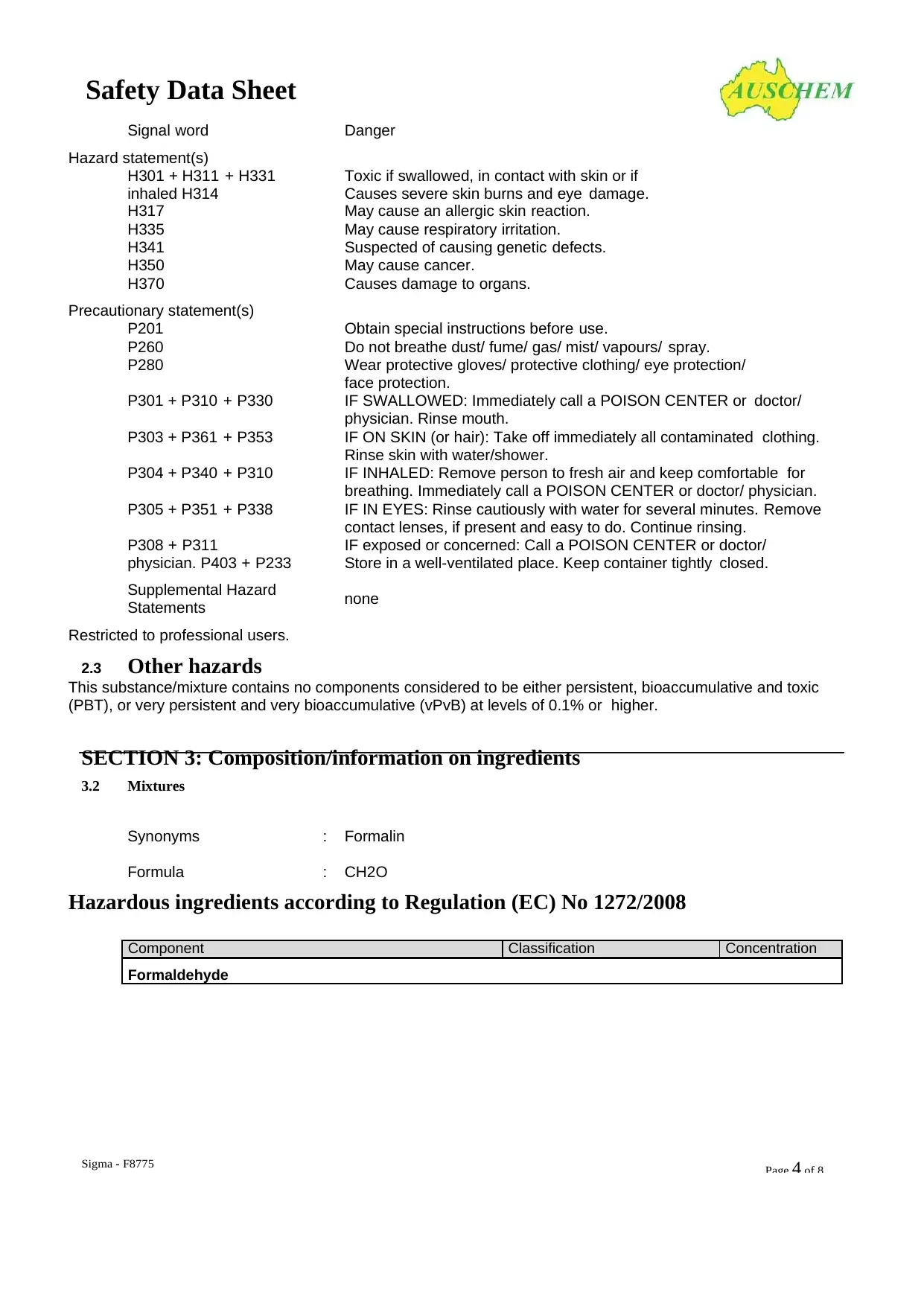
Safety Data Sheet
Page 4 of 8
Sigma - F8775
Signal word Danger
Hazard statement(s)
H301 + H311 + H331 Toxic if swallowed, in contact with skin or if
inhaled H314 Causes severe skin burns and eye damage.
H317 May cause an allergic skin reaction.
H335 May cause respiratory irritation.
H341 Suspected of causing genetic defects.
H350 May cause cancer.
H370 Causes damage to organs.
Precautionary statement(s)
P201 Obtain special instructions before use.
P260 Do not breathe dust/ fume/ gas/ mist/ vapours/ spray.
P280 Wear protective gloves/ protective clothing/ eye protection/
face protection.
P301 + P310 + P330 IF SWALLOWED: Immediately call a POISON CENTER or doctor/
physician. Rinse mouth.
P303 + P361 + P353 IF ON SKIN (or hair): Take off immediately all contaminated clothing.
Rinse skin with water/shower.
P304 + P340 + P310 IF INHALED: Remove person to fresh air and keep comfortable for
breathing. Immediately call a POISON CENTER or doctor/ physician.
P305 + P351 + P338 IF IN EYES: Rinse cautiously with water for several minutes. Remove
contact lenses, if present and easy to do. Continue rinsing.
P308 + P311 IF exposed or concerned: Call a POISON CENTER or doctor/
physician. P403 + P233 Store in a well-ventilated place. Keep container tightly closed.
Supplemental Hazard
Statements
Restricted to professional users.
2.3 Other hazards
none
This substance/mixture contains no components considered to be either persistent, bioaccumulative and toxic
(PBT), or very persistent and very bioaccumulative (vPvB) at levels of 0.1% or higher.
SECTION 3: Composition/information on ingredients
3.2 Mixtures
Synonyms : Formalin
Formula : CH2O
Hazardous ingredients according to Regulation (EC) No 1272/2008
Component Classification Concentration
Formaldehyde
Page 4 of 8
Sigma - F8775
Signal word Danger
Hazard statement(s)
H301 + H311 + H331 Toxic if swallowed, in contact with skin or if
inhaled H314 Causes severe skin burns and eye damage.
H317 May cause an allergic skin reaction.
H335 May cause respiratory irritation.
H341 Suspected of causing genetic defects.
H350 May cause cancer.
H370 Causes damage to organs.
Precautionary statement(s)
P201 Obtain special instructions before use.
P260 Do not breathe dust/ fume/ gas/ mist/ vapours/ spray.
P280 Wear protective gloves/ protective clothing/ eye protection/
face protection.
P301 + P310 + P330 IF SWALLOWED: Immediately call a POISON CENTER or doctor/
physician. Rinse mouth.
P303 + P361 + P353 IF ON SKIN (or hair): Take off immediately all contaminated clothing.
Rinse skin with water/shower.
P304 + P340 + P310 IF INHALED: Remove person to fresh air and keep comfortable for
breathing. Immediately call a POISON CENTER or doctor/ physician.
P305 + P351 + P338 IF IN EYES: Rinse cautiously with water for several minutes. Remove
contact lenses, if present and easy to do. Continue rinsing.
P308 + P311 IF exposed or concerned: Call a POISON CENTER or doctor/
physician. P403 + P233 Store in a well-ventilated place. Keep container tightly closed.
Supplemental Hazard
Statements
Restricted to professional users.
2.3 Other hazards
none
This substance/mixture contains no components considered to be either persistent, bioaccumulative and toxic
(PBT), or very persistent and very bioaccumulative (vPvB) at levels of 0.1% or higher.
SECTION 3: Composition/information on ingredients
3.2 Mixtures
Synonyms : Formalin
Formula : CH2O
Hazardous ingredients according to Regulation (EC) No 1272/2008
Component Classification Concentration
Formaldehyde
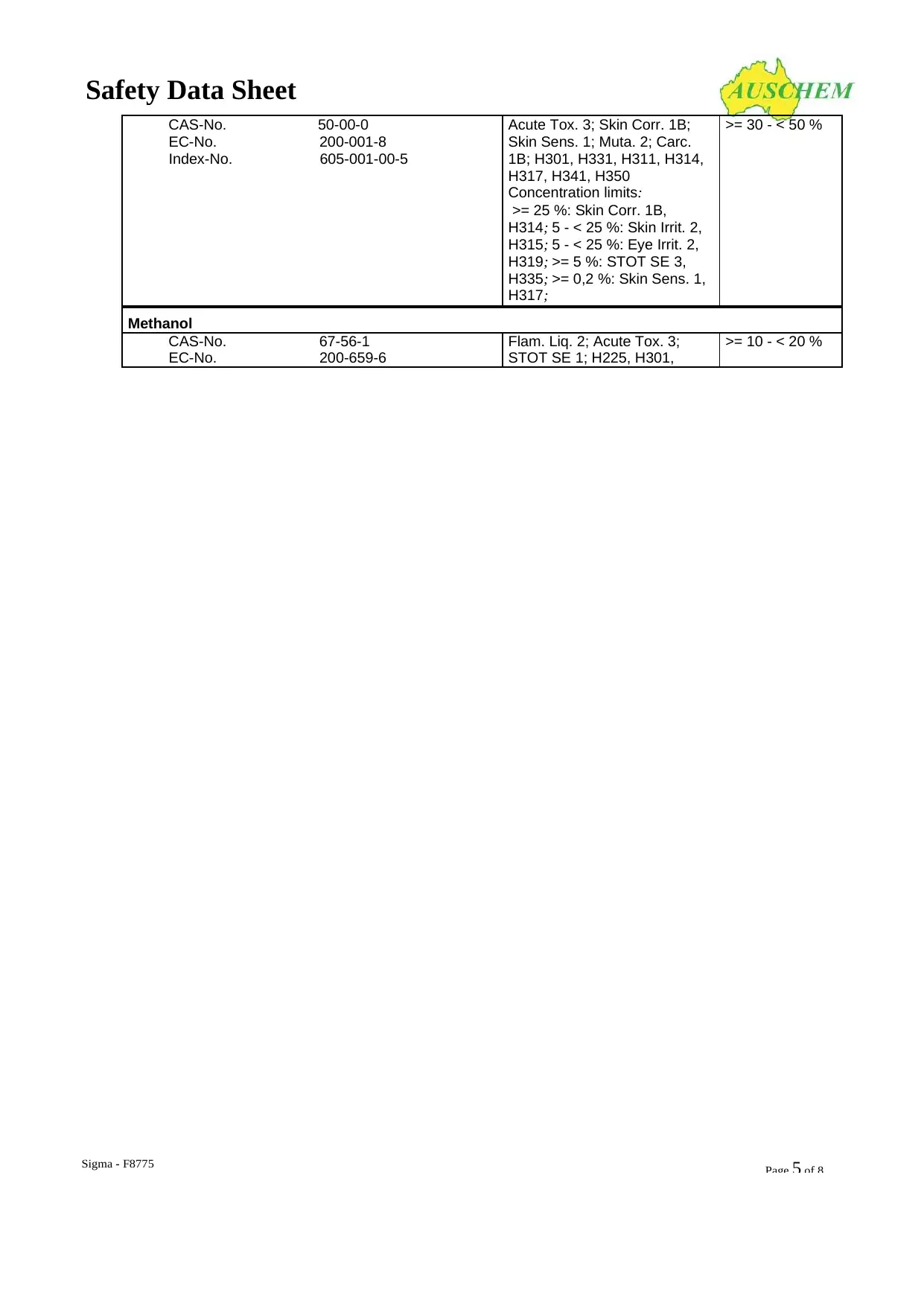
Safety Data Sheet
Page 5 of 8
Sigma - F8775
CAS-No. 50-00-0
EC-No. 200-001-8
Index-No. 605-001-00-5
Acute Tox. 3; Skin Corr. 1B;
Skin Sens. 1; Muta. 2; Carc.
1B; H301, H331, H311, H314,
H317, H341, H350
Concentration limits:
>= 25 %: Skin Corr. 1B,
H314; 5 - < 25 %: Skin Irrit. 2,
H315; 5 - < 25 %: Eye Irrit. 2,
H319; >= 5 %: STOT SE 3,
H335; >= 0,2 %: Skin Sens. 1,
H317;
>= 30 - < 50 %
Methanol
CAS-No. 67-56-1
EC-No. 200-659-6
Flam. Liq. 2; Acute Tox. 3;
STOT SE 1; H225, H301,
>= 10 - < 20 %
Page 5 of 8
Sigma - F8775
CAS-No. 50-00-0
EC-No. 200-001-8
Index-No. 605-001-00-5
Acute Tox. 3; Skin Corr. 1B;
Skin Sens. 1; Muta. 2; Carc.
1B; H301, H331, H311, H314,
H317, H341, H350
Concentration limits:
>= 25 %: Skin Corr. 1B,
H314; 5 - < 25 %: Skin Irrit. 2,
H315; 5 - < 25 %: Eye Irrit. 2,
H319; >= 5 %: STOT SE 3,
H335; >= 0,2 %: Skin Sens. 1,
H317;
>= 30 - < 50 %
Methanol
CAS-No. 67-56-1
EC-No. 200-659-6
Flam. Liq. 2; Acute Tox. 3;
STOT SE 1; H225, H301,
>= 10 - < 20 %
Paraphrase This Document
Need a fresh take? Get an instant paraphrase of this document with our AI Paraphraser
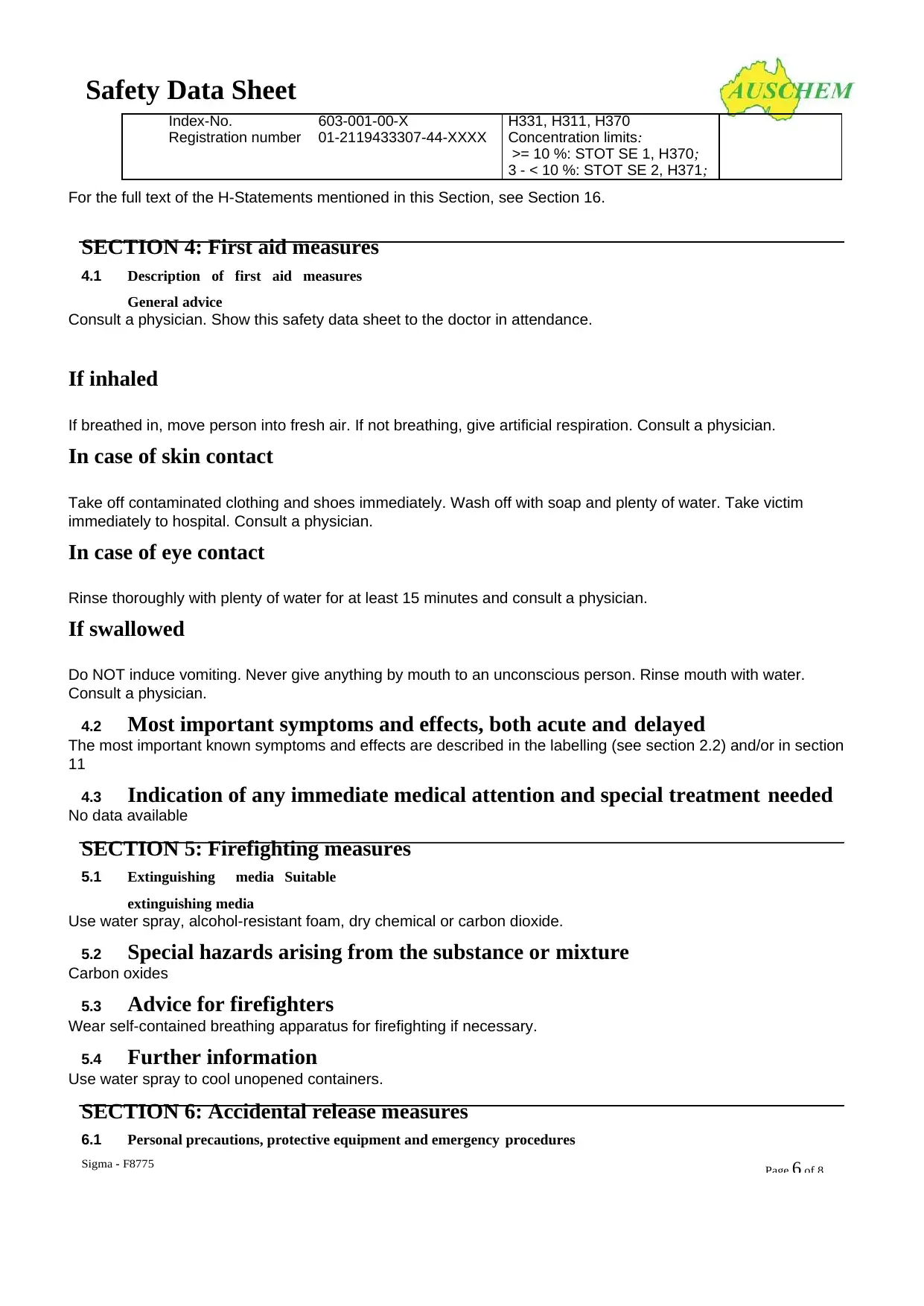
Safety Data Sheet
Page 6 of 8
Sigma - F8775
Index-No. 603-001-00-X H331, H311, H370
Registration number 01-2119433307-44-XXXX Concentration limits:
>= 10 %: STOT SE 1, H370;
3 - < 10 %: STOT SE 2, H371;
For the full text of the H-Statements mentioned in this Section, see Section 16.
SECTION 4: First aid measures
4.1 Description of first aid measures
General advice
Consult a physician. Show this safety data sheet to the doctor in attendance.
If inhaled
If breathed in, move person into fresh air. If not breathing, give artificial respiration. Consult a physician.
In case of skin contact
Take off contaminated clothing and shoes immediately. Wash off with soap and plenty of water. Take victim
immediately to hospital. Consult a physician.
In case of eye contact
Rinse thoroughly with plenty of water for at least 15 minutes and consult a physician.
If swallowed
Do NOT induce vomiting. Never give anything by mouth to an unconscious person. Rinse mouth with water.
Consult a physician.
4.2 Most important symptoms and effects, both acute and delayed
The most important known symptoms and effects are described in the labelling (see section 2.2) and/or in section
11
4.3 Indication of any immediate medical attention and special treatment needed
No data available
SECTION 5: Firefighting measures
5.1 Extinguishing media Suitable
extinguishing media
Use water spray, alcohol-resistant foam, dry chemical or carbon dioxide.
5.2 Special hazards arising from the substance or mixture
Carbon oxides
5.3 Advice for firefighters
Wear self-contained breathing apparatus for firefighting if necessary.
5.4 Further information
Use water spray to cool unopened containers.
SECTION 6: Accidental release measures
6.1 Personal precautions, protective equipment and emergency procedures
Page 6 of 8
Sigma - F8775
Index-No. 603-001-00-X H331, H311, H370
Registration number 01-2119433307-44-XXXX Concentration limits:
>= 10 %: STOT SE 1, H370;
3 - < 10 %: STOT SE 2, H371;
For the full text of the H-Statements mentioned in this Section, see Section 16.
SECTION 4: First aid measures
4.1 Description of first aid measures
General advice
Consult a physician. Show this safety data sheet to the doctor in attendance.
If inhaled
If breathed in, move person into fresh air. If not breathing, give artificial respiration. Consult a physician.
In case of skin contact
Take off contaminated clothing and shoes immediately. Wash off with soap and plenty of water. Take victim
immediately to hospital. Consult a physician.
In case of eye contact
Rinse thoroughly with plenty of water for at least 15 minutes and consult a physician.
If swallowed
Do NOT induce vomiting. Never give anything by mouth to an unconscious person. Rinse mouth with water.
Consult a physician.
4.2 Most important symptoms and effects, both acute and delayed
The most important known symptoms and effects are described in the labelling (see section 2.2) and/or in section
11
4.3 Indication of any immediate medical attention and special treatment needed
No data available
SECTION 5: Firefighting measures
5.1 Extinguishing media Suitable
extinguishing media
Use water spray, alcohol-resistant foam, dry chemical or carbon dioxide.
5.2 Special hazards arising from the substance or mixture
Carbon oxides
5.3 Advice for firefighters
Wear self-contained breathing apparatus for firefighting if necessary.
5.4 Further information
Use water spray to cool unopened containers.
SECTION 6: Accidental release measures
6.1 Personal precautions, protective equipment and emergency procedures
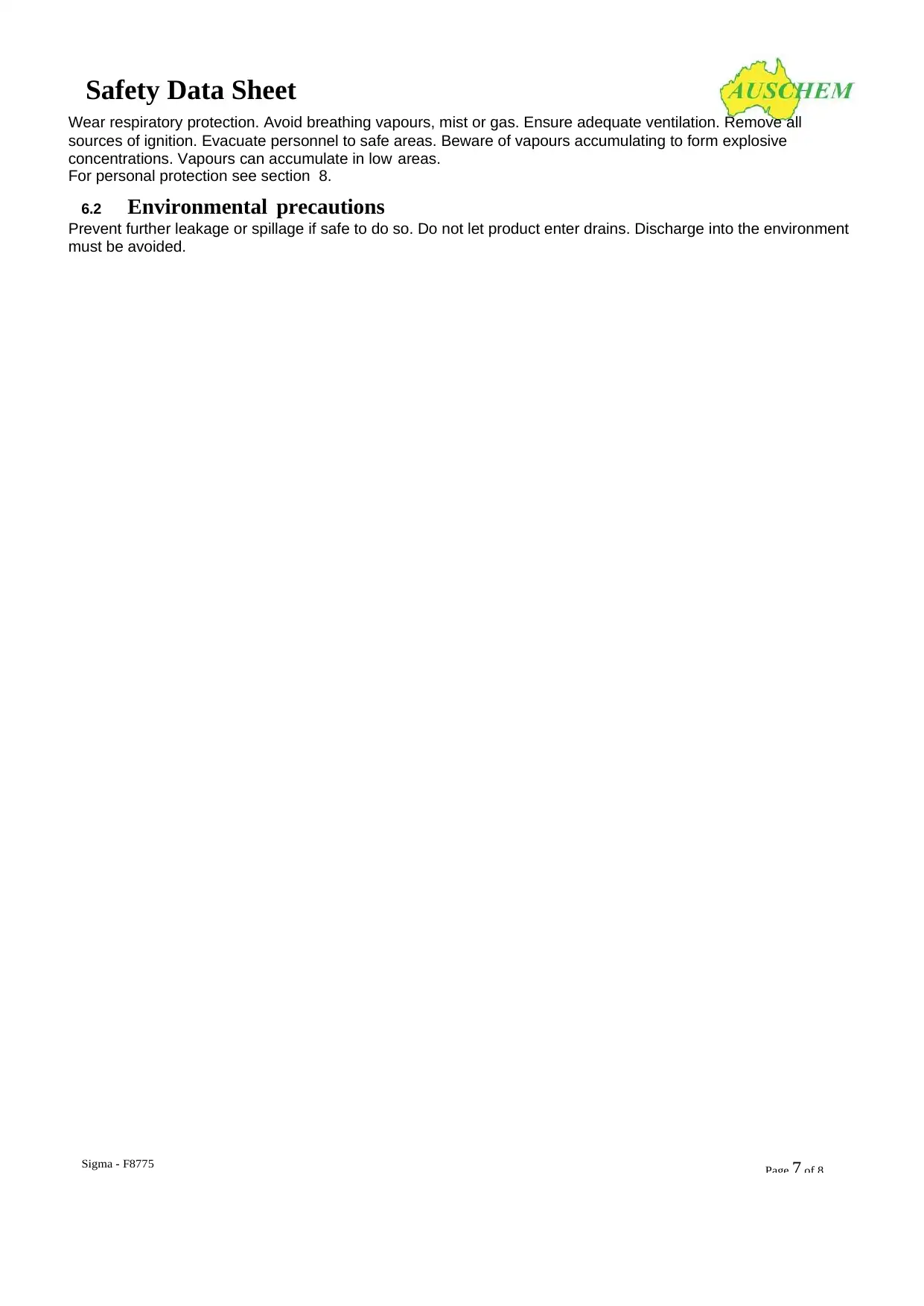
Safety Data Sheet
Page 7 of 8
Sigma - F8775
Wear respiratory protection. Avoid breathing vapours, mist or gas. Ensure adequate ventilation. Remove all
sources of ignition. Evacuate personnel to safe areas. Beware of vapours accumulating to form explosive
concentrations. Vapours can accumulate in low areas.
For personal protection see section 8.
6.2 Environmental precautions
Prevent further leakage or spillage if safe to do so. Do not let product enter drains. Discharge into the environment
must be avoided.
Page 7 of 8
Sigma - F8775
Wear respiratory protection. Avoid breathing vapours, mist or gas. Ensure adequate ventilation. Remove all
sources of ignition. Evacuate personnel to safe areas. Beware of vapours accumulating to form explosive
concentrations. Vapours can accumulate in low areas.
For personal protection see section 8.
6.2 Environmental precautions
Prevent further leakage or spillage if safe to do so. Do not let product enter drains. Discharge into the environment
must be avoided.
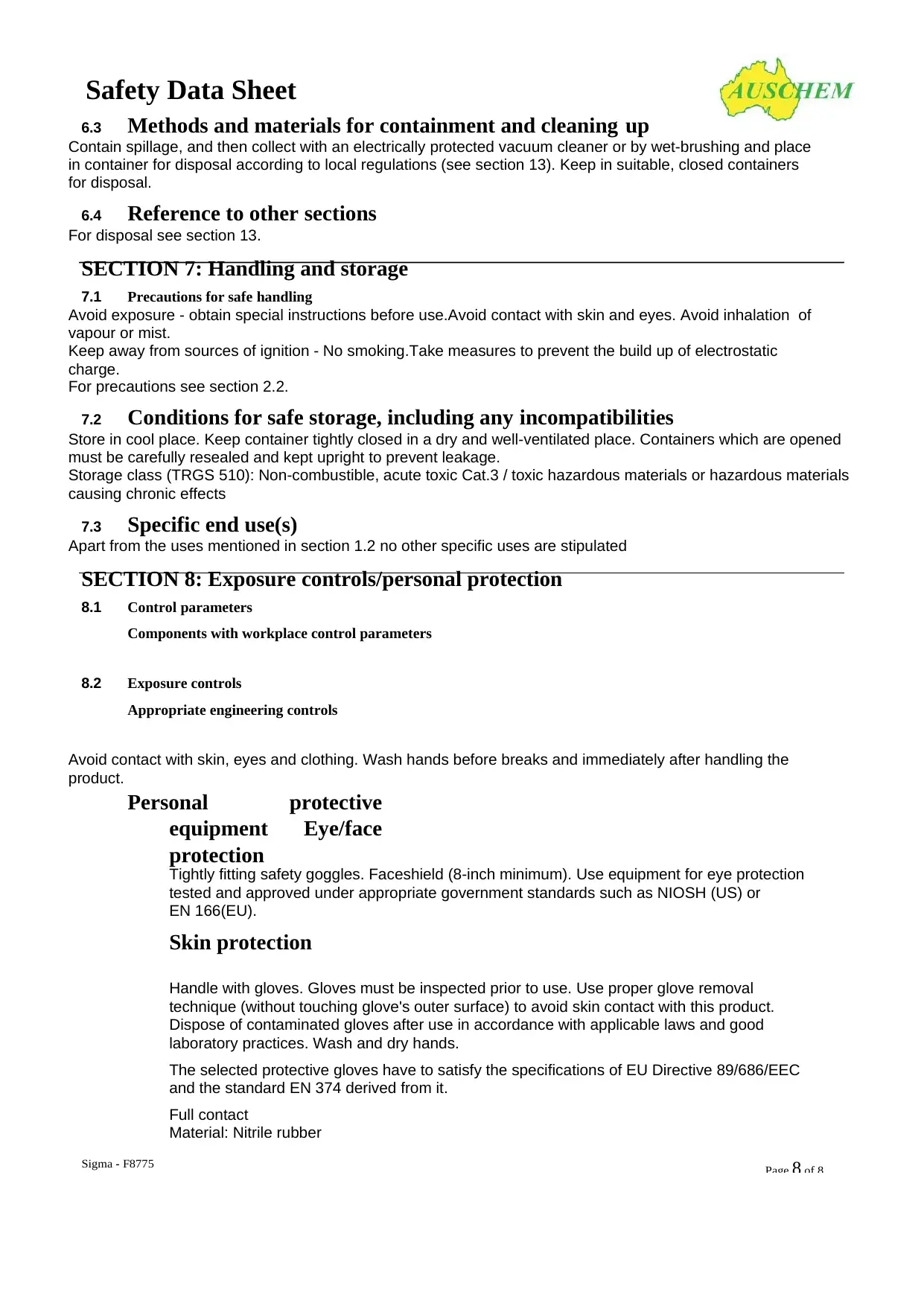
Safety Data Sheet
Page 8 of 8
Sigma - F8775
6.3 Methods and materials for containment and cleaning up
Contain spillage, and then collect with an electrically protected vacuum cleaner or by wet-brushing and place
in container for disposal according to local regulations (see section 13). Keep in suitable, closed containers
for disposal.
6.4 Reference to other sections
For disposal see section 13.
SECTION 7: Handling and storage
7.1 Precautions for safe handling
Avoid exposure - obtain special instructions before use.Avoid contact with skin and eyes. Avoid inhalation of
vapour or mist.
Keep away from sources of ignition - No smoking.Take measures to prevent the build up of electrostatic
charge.
For precautions see section 2.2.
7.2 Conditions for safe storage, including any incompatibilities
Store in cool place. Keep container tightly closed in a dry and well-ventilated place. Containers which are opened
must be carefully resealed and kept upright to prevent leakage.
Storage class (TRGS 510): Non-combustible, acute toxic Cat.3 / toxic hazardous materials or hazardous materials
causing chronic effects
7.3 Specific end use(s)
Apart from the uses mentioned in section 1.2 no other specific uses are stipulated
SECTION 8: Exposure controls/personal protection
8.1 Control parameters
Components with workplace control parameters
8.2 Exposure controls
Appropriate engineering controls
Avoid contact with skin, eyes and clothing. Wash hands before breaks and immediately after handling the
product.
Personal protective
equipment Eye/face
protection
Tightly fitting safety goggles. Faceshield (8-inch minimum). Use equipment for eye protection
tested and approved under appropriate government standards such as NIOSH (US) or
EN 166(EU).
Skin protection
Handle with gloves. Gloves must be inspected prior to use. Use proper glove removal
technique (without touching glove's outer surface) to avoid skin contact with this product.
Dispose of contaminated gloves after use in accordance with applicable laws and good
laboratory practices. Wash and dry hands.
The selected protective gloves have to satisfy the specifications of EU Directive 89/686/EEC
and the standard EN 374 derived from it.
Full contact
Material: Nitrile rubber
Page 8 of 8
Sigma - F8775
6.3 Methods and materials for containment and cleaning up
Contain spillage, and then collect with an electrically protected vacuum cleaner or by wet-brushing and place
in container for disposal according to local regulations (see section 13). Keep in suitable, closed containers
for disposal.
6.4 Reference to other sections
For disposal see section 13.
SECTION 7: Handling and storage
7.1 Precautions for safe handling
Avoid exposure - obtain special instructions before use.Avoid contact with skin and eyes. Avoid inhalation of
vapour or mist.
Keep away from sources of ignition - No smoking.Take measures to prevent the build up of electrostatic
charge.
For precautions see section 2.2.
7.2 Conditions for safe storage, including any incompatibilities
Store in cool place. Keep container tightly closed in a dry and well-ventilated place. Containers which are opened
must be carefully resealed and kept upright to prevent leakage.
Storage class (TRGS 510): Non-combustible, acute toxic Cat.3 / toxic hazardous materials or hazardous materials
causing chronic effects
7.3 Specific end use(s)
Apart from the uses mentioned in section 1.2 no other specific uses are stipulated
SECTION 8: Exposure controls/personal protection
8.1 Control parameters
Components with workplace control parameters
8.2 Exposure controls
Appropriate engineering controls
Avoid contact with skin, eyes and clothing. Wash hands before breaks and immediately after handling the
product.
Personal protective
equipment Eye/face
protection
Tightly fitting safety goggles. Faceshield (8-inch minimum). Use equipment for eye protection
tested and approved under appropriate government standards such as NIOSH (US) or
EN 166(EU).
Skin protection
Handle with gloves. Gloves must be inspected prior to use. Use proper glove removal
technique (without touching glove's outer surface) to avoid skin contact with this product.
Dispose of contaminated gloves after use in accordance with applicable laws and good
laboratory practices. Wash and dry hands.
The selected protective gloves have to satisfy the specifications of EU Directive 89/686/EEC
and the standard EN 374 derived from it.
Full contact
Material: Nitrile rubber
Secure Best Marks with AI Grader
Need help grading? Try our AI Grader for instant feedback on your assignments.
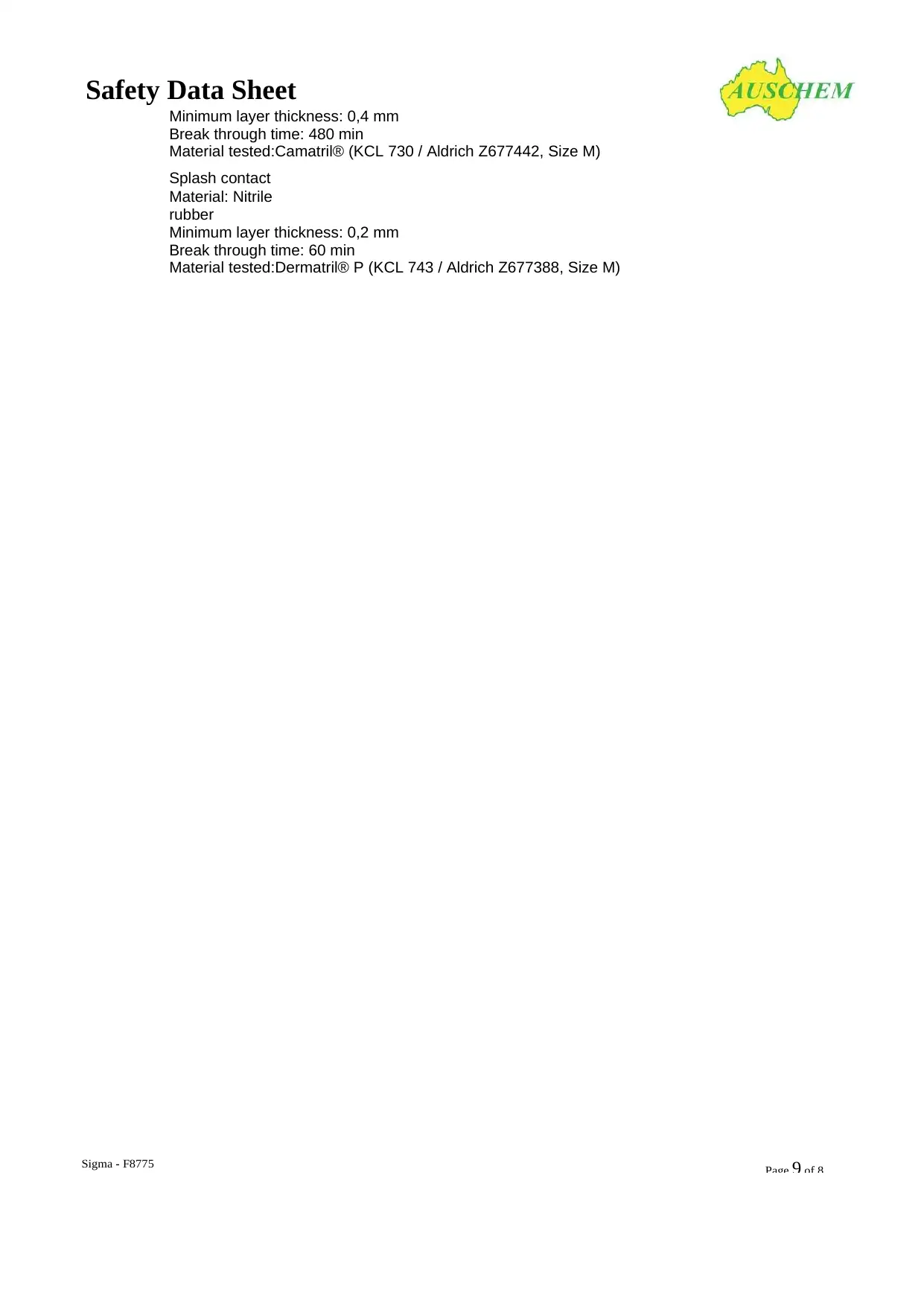
Safety Data Sheet
Page 9 of 8
Sigma - F8775
Minimum layer thickness: 0,4 mm
Break through time: 480 min
Material tested:Camatril® (KCL 730 / Aldrich Z677442, Size M)
Splash contact
Material: Nitrile
rubber
Minimum layer thickness: 0,2 mm
Break through time: 60 min
Material tested:Dermatril® P (KCL 743 / Aldrich Z677388, Size M)
Page 9 of 8
Sigma - F8775
Minimum layer thickness: 0,4 mm
Break through time: 480 min
Material tested:Camatril® (KCL 730 / Aldrich Z677442, Size M)
Splash contact
Material: Nitrile
rubber
Minimum layer thickness: 0,2 mm
Break through time: 60 min
Material tested:Dermatril® P (KCL 743 / Aldrich Z677388, Size M)
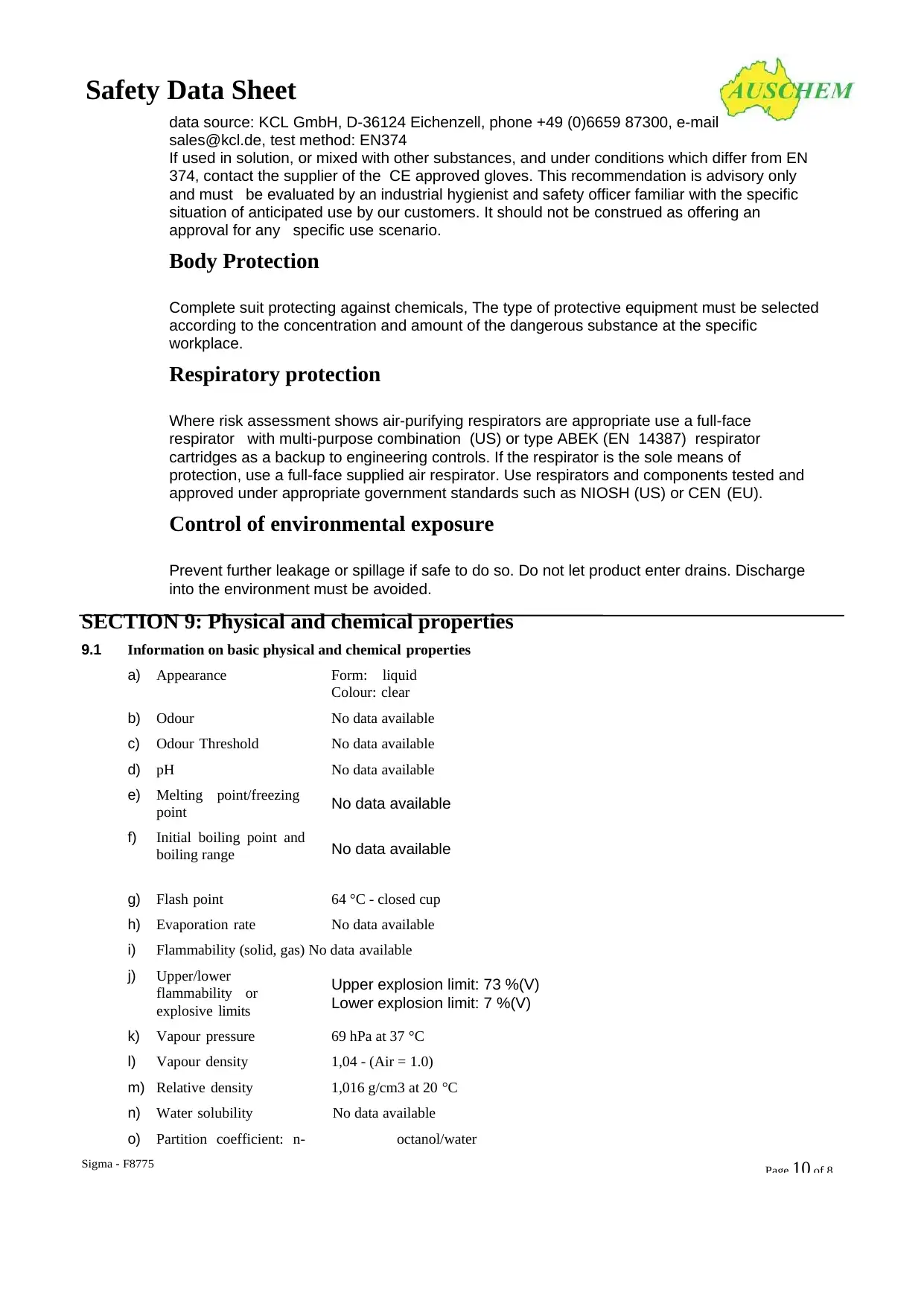
Safety Data Sheet
Page 10 of 8
Sigma - F8775
data source: KCL GmbH, D-36124 Eichenzell, phone +49 (0)6659 87300, e-mail
sales@kcl.de, test method: EN374
If used in solution, or mixed with other substances, and under conditions which differ from EN
374, contact the supplier of the CE approved gloves. This recommendation is advisory only
and must be evaluated by an industrial hygienist and safety officer familiar with the specific
situation of anticipated use by our customers. It should not be construed as offering an
approval for any specific use scenario.
Body Protection
Complete suit protecting against chemicals, The type of protective equipment must be selected
according to the concentration and amount of the dangerous substance at the specific
workplace.
Respiratory protection
Where risk assessment shows air-purifying respirators are appropriate use a full-face
respirator with multi-purpose combination (US) or type ABEK (EN 14387) respirator
cartridges as a backup to engineering controls. If the respirator is the sole means of
protection, use a full-face supplied air respirator. Use respirators and components tested and
approved under appropriate government standards such as NIOSH (US) or CEN (EU).
Control of environmental exposure
Prevent further leakage or spillage if safe to do so. Do not let product enter drains. Discharge
into the environment must be avoided.
SECTION 9: Physical and chemical properties
9.1 Information on basic physical and chemical properties
a) Appearance Form: liquid
Colour: clear
b) Odour No data available
c) Odour Threshold No data available
d) pH No data available
e) Melting point/freezing
point
f) Initial boiling point and
boiling range
No data available
No data available
g) Flash point 64 °C - closed cup
h) Evaporation rate No data available
i) Flammability (solid, gas) No data available
j) Upper/lower
flammability or
explosive limits
Upper explosion limit: 73 %(V)
Lower explosion limit: 7 %(V)
k) Vapour pressure 69 hPa at 37 °C
l) Vapour density 1,04 - (Air = 1.0)
m) Relative density 1,016 g/cm3 at 20 °C
n) Water solubility No data available
o) Partition coefficient: n- octanol/water
Page 10 of 8
Sigma - F8775
data source: KCL GmbH, D-36124 Eichenzell, phone +49 (0)6659 87300, e-mail
sales@kcl.de, test method: EN374
If used in solution, or mixed with other substances, and under conditions which differ from EN
374, contact the supplier of the CE approved gloves. This recommendation is advisory only
and must be evaluated by an industrial hygienist and safety officer familiar with the specific
situation of anticipated use by our customers. It should not be construed as offering an
approval for any specific use scenario.
Body Protection
Complete suit protecting against chemicals, The type of protective equipment must be selected
according to the concentration and amount of the dangerous substance at the specific
workplace.
Respiratory protection
Where risk assessment shows air-purifying respirators are appropriate use a full-face
respirator with multi-purpose combination (US) or type ABEK (EN 14387) respirator
cartridges as a backup to engineering controls. If the respirator is the sole means of
protection, use a full-face supplied air respirator. Use respirators and components tested and
approved under appropriate government standards such as NIOSH (US) or CEN (EU).
Control of environmental exposure
Prevent further leakage or spillage if safe to do so. Do not let product enter drains. Discharge
into the environment must be avoided.
SECTION 9: Physical and chemical properties
9.1 Information on basic physical and chemical properties
a) Appearance Form: liquid
Colour: clear
b) Odour No data available
c) Odour Threshold No data available
d) pH No data available
e) Melting point/freezing
point
f) Initial boiling point and
boiling range
No data available
No data available
g) Flash point 64 °C - closed cup
h) Evaporation rate No data available
i) Flammability (solid, gas) No data available
j) Upper/lower
flammability or
explosive limits
Upper explosion limit: 73 %(V)
Lower explosion limit: 7 %(V)
k) Vapour pressure 69 hPa at 37 °C
l) Vapour density 1,04 - (Air = 1.0)
m) Relative density 1,016 g/cm3 at 20 °C
n) Water solubility No data available
o) Partition coefficient: n- octanol/water
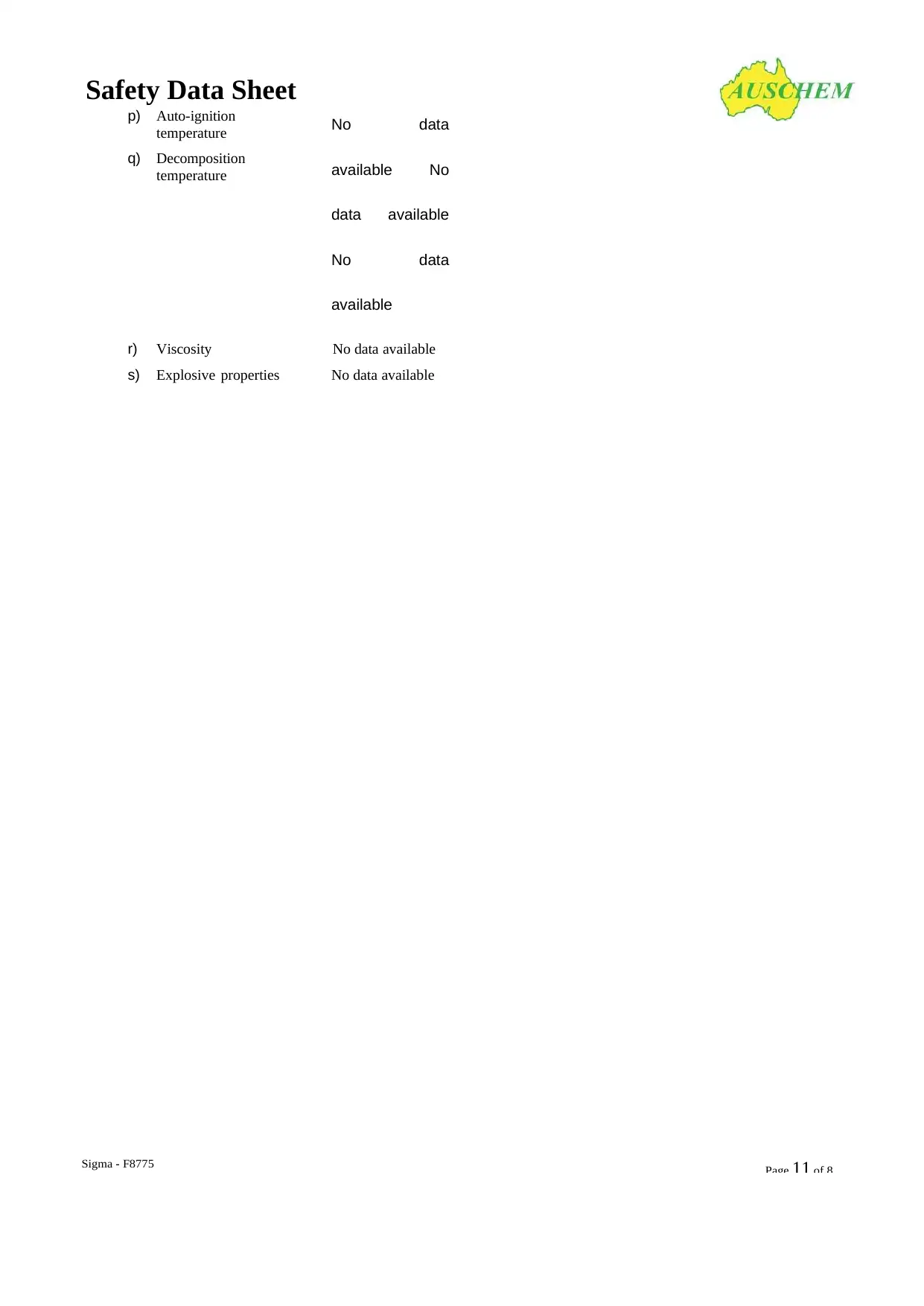
Safety Data Sheet
Page 11 of 8
Sigma - F8775
p) Auto-ignition
temperature
q) Decomposition
temperature
No data
available No
data available
No data
available
r) Viscosity No data available
s) Explosive properties No data available
Page 11 of 8
Sigma - F8775
p) Auto-ignition
temperature
q) Decomposition
temperature
No data
available No
data available
No data
available
r) Viscosity No data available
s) Explosive properties No data available
Paraphrase This Document
Need a fresh take? Get an instant paraphrase of this document with our AI Paraphraser
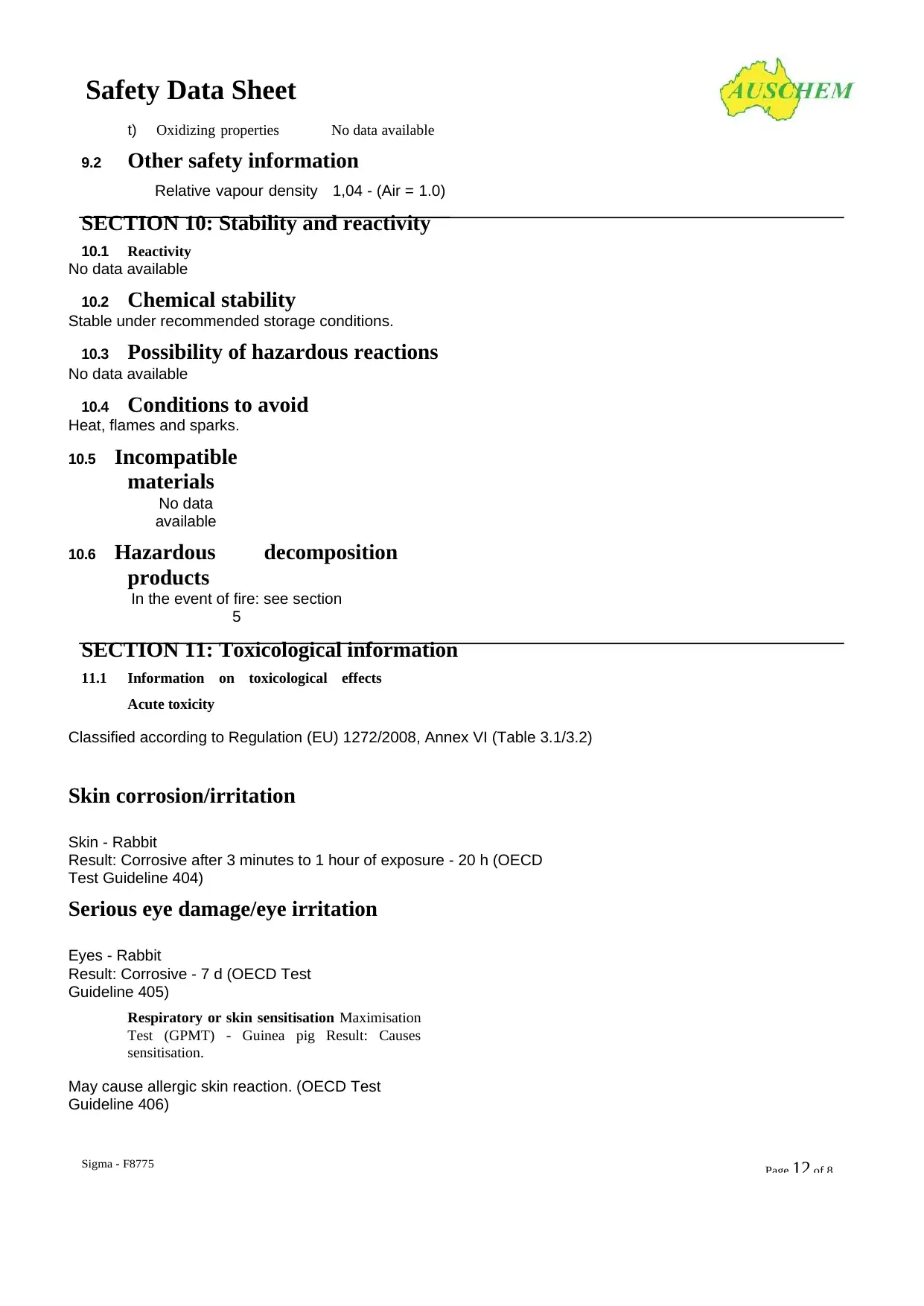
Safety Data Sheet
Page 12 of 8
Sigma - F8775
t) Oxidizing properties No data available
9.2 Other safety information
Relative vapour density 1,04 - (Air = 1.0)
SECTION 10: Stability and reactivity
10.1 Reactivity
No data available
10.2 Chemical stability
Stable under recommended storage conditions.
10.3 Possibility of hazardous reactions
No data available
10.4 Conditions to avoid
Heat, flames and sparks.
10.5 Incompatible
materials
No data
available
10.6 Hazardous decomposition
products
In the event of fire: see section
5
SECTION 11: Toxicological information
11.1 Information on toxicological effects
Acute toxicity
Classified according to Regulation (EU) 1272/2008, Annex VI (Table 3.1/3.2)
Skin corrosion/irritation
Skin - Rabbit
Result: Corrosive after 3 minutes to 1 hour of exposure - 20 h (OECD
Test Guideline 404)
Serious eye damage/eye irritation
Eyes - Rabbit
Result: Corrosive - 7 d (OECD Test
Guideline 405)
Respiratory or skin sensitisation Maximisation
Test (GPMT) - Guinea pig Result: Causes
sensitisation.
May cause allergic skin reaction. (OECD Test
Guideline 406)
Page 12 of 8
Sigma - F8775
t) Oxidizing properties No data available
9.2 Other safety information
Relative vapour density 1,04 - (Air = 1.0)
SECTION 10: Stability and reactivity
10.1 Reactivity
No data available
10.2 Chemical stability
Stable under recommended storage conditions.
10.3 Possibility of hazardous reactions
No data available
10.4 Conditions to avoid
Heat, flames and sparks.
10.5 Incompatible
materials
No data
available
10.6 Hazardous decomposition
products
In the event of fire: see section
5
SECTION 11: Toxicological information
11.1 Information on toxicological effects
Acute toxicity
Classified according to Regulation (EU) 1272/2008, Annex VI (Table 3.1/3.2)
Skin corrosion/irritation
Skin - Rabbit
Result: Corrosive after 3 minutes to 1 hour of exposure - 20 h (OECD
Test Guideline 404)
Serious eye damage/eye irritation
Eyes - Rabbit
Result: Corrosive - 7 d (OECD Test
Guideline 405)
Respiratory or skin sensitisation Maximisation
Test (GPMT) - Guinea pig Result: Causes
sensitisation.
May cause allergic skin reaction. (OECD Test
Guideline 406)
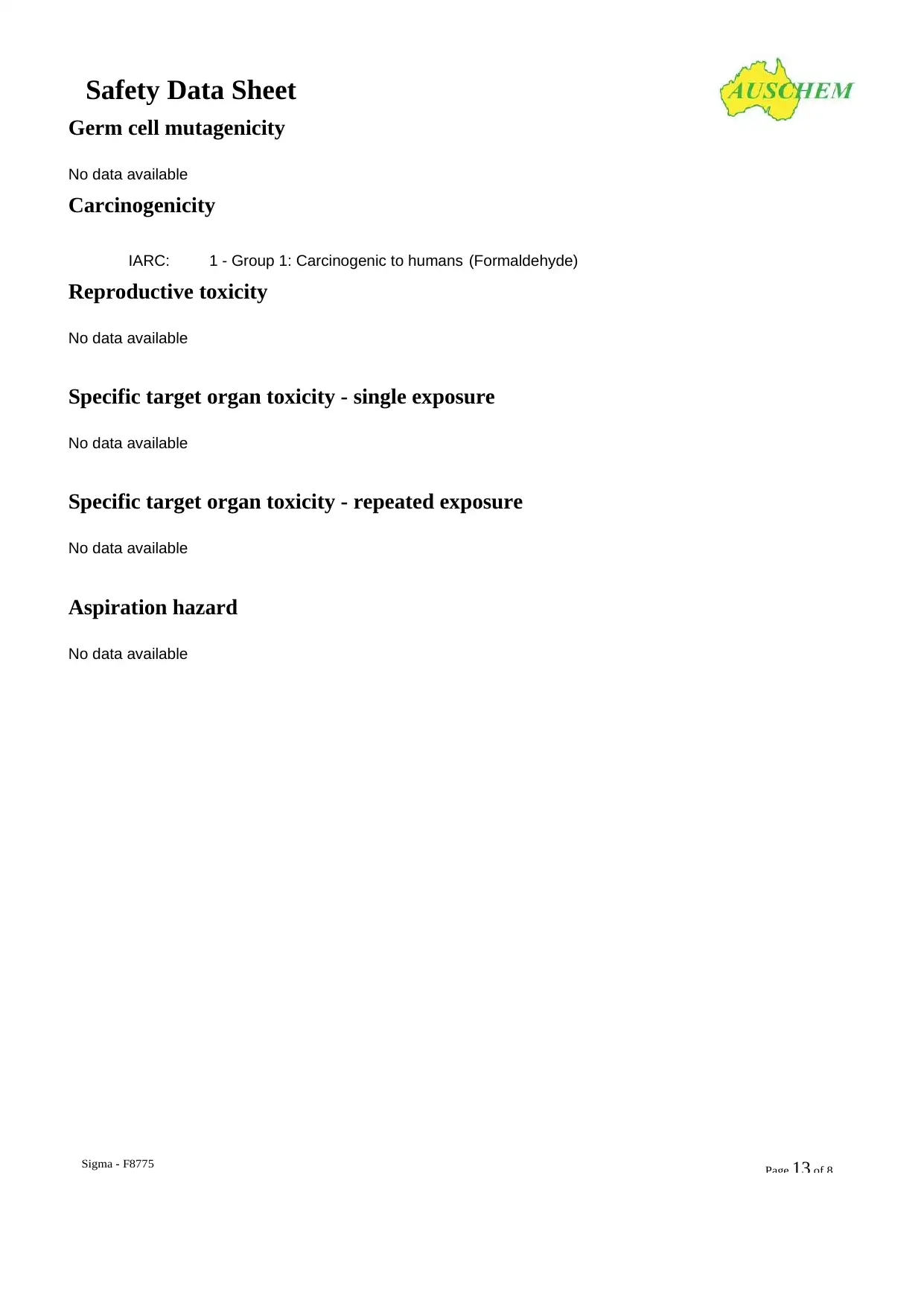
Safety Data Sheet
Page 13 of 8
Sigma - F8775
Germ cell mutagenicity
No data available
Carcinogenicity
IARC: 1 - Group 1: Carcinogenic to humans (Formaldehyde)
Reproductive toxicity
No data available
Specific target organ toxicity - single exposure
No data available
Specific target organ toxicity - repeated exposure
No data available
Aspiration hazard
No data available
Page 13 of 8
Sigma - F8775
Germ cell mutagenicity
No data available
Carcinogenicity
IARC: 1 - Group 1: Carcinogenic to humans (Formaldehyde)
Reproductive toxicity
No data available
Specific target organ toxicity - single exposure
No data available
Specific target organ toxicity - repeated exposure
No data available
Aspiration hazard
No data available
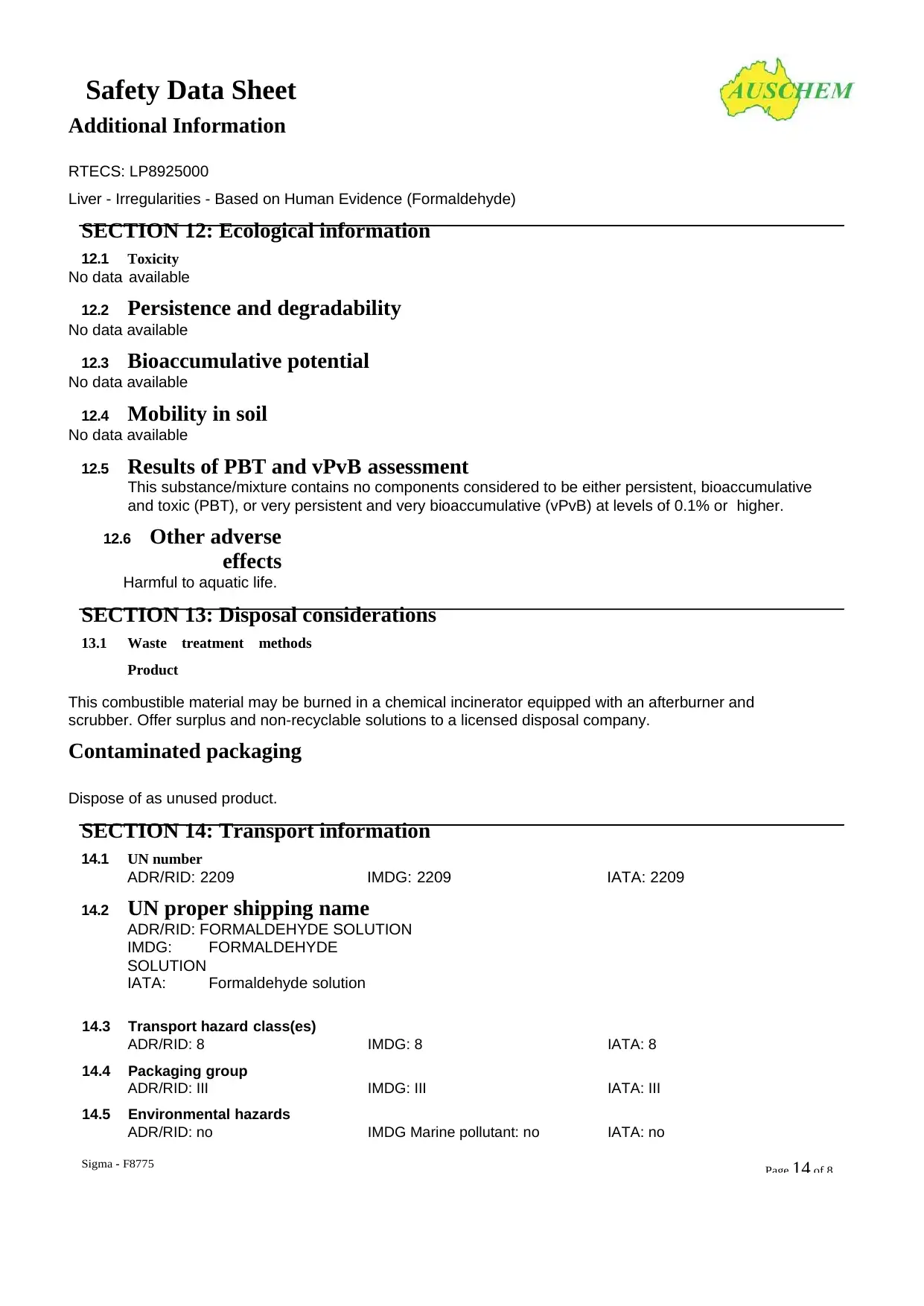
Safety Data Sheet
Page 14 of 8
Sigma - F8775
Additional Information
RTECS: LP8925000
Liver - Irregularities - Based on Human Evidence (Formaldehyde)
SECTION 12: Ecological information
12.1 Toxicity
No data available
12.2 Persistence and degradability
No data available
12.3 Bioaccumulative potential
No data available
12.4 Mobility in soil
No data available
12.5 Results of PBT and vPvB assessment
This substance/mixture contains no components considered to be either persistent, bioaccumulative
and toxic (PBT), or very persistent and very bioaccumulative (vPvB) at levels of 0.1% or higher.
12.6 Other adverse
effects
Harmful to aquatic life.
SECTION 13: Disposal considerations
13.1 Waste treatment methods
Product
This combustible material may be burned in a chemical incinerator equipped with an afterburner and
scrubber. Offer surplus and non-recyclable solutions to a licensed disposal company.
Contaminated packaging
Dispose of as unused product.
SECTION 14: Transport information
14.1 UN number
ADR/RID: 2209 IMDG: 2209 IATA: 2209
14.2 UN proper shipping name
ADR/RID: FORMALDEHYDE SOLUTION
IMDG: FORMALDEHYDE
SOLUTION
IATA: Formaldehyde solution
14.3 Transport hazard class(es)
ADR/RID: 8 IMDG: 8 IATA: 8
14.4 Packaging group
ADR/RID: III IMDG: III IATA: III
14.5 Environmental hazards
ADR/RID: no IMDG Marine pollutant: no IATA: no
Page 14 of 8
Sigma - F8775
Additional Information
RTECS: LP8925000
Liver - Irregularities - Based on Human Evidence (Formaldehyde)
SECTION 12: Ecological information
12.1 Toxicity
No data available
12.2 Persistence and degradability
No data available
12.3 Bioaccumulative potential
No data available
12.4 Mobility in soil
No data available
12.5 Results of PBT and vPvB assessment
This substance/mixture contains no components considered to be either persistent, bioaccumulative
and toxic (PBT), or very persistent and very bioaccumulative (vPvB) at levels of 0.1% or higher.
12.6 Other adverse
effects
Harmful to aquatic life.
SECTION 13: Disposal considerations
13.1 Waste treatment methods
Product
This combustible material may be burned in a chemical incinerator equipped with an afterburner and
scrubber. Offer surplus and non-recyclable solutions to a licensed disposal company.
Contaminated packaging
Dispose of as unused product.
SECTION 14: Transport information
14.1 UN number
ADR/RID: 2209 IMDG: 2209 IATA: 2209
14.2 UN proper shipping name
ADR/RID: FORMALDEHYDE SOLUTION
IMDG: FORMALDEHYDE
SOLUTION
IATA: Formaldehyde solution
14.3 Transport hazard class(es)
ADR/RID: 8 IMDG: 8 IATA: 8
14.4 Packaging group
ADR/RID: III IMDG: III IATA: III
14.5 Environmental hazards
ADR/RID: no IMDG Marine pollutant: no IATA: no
Secure Best Marks with AI Grader
Need help grading? Try our AI Grader for instant feedback on your assignments.
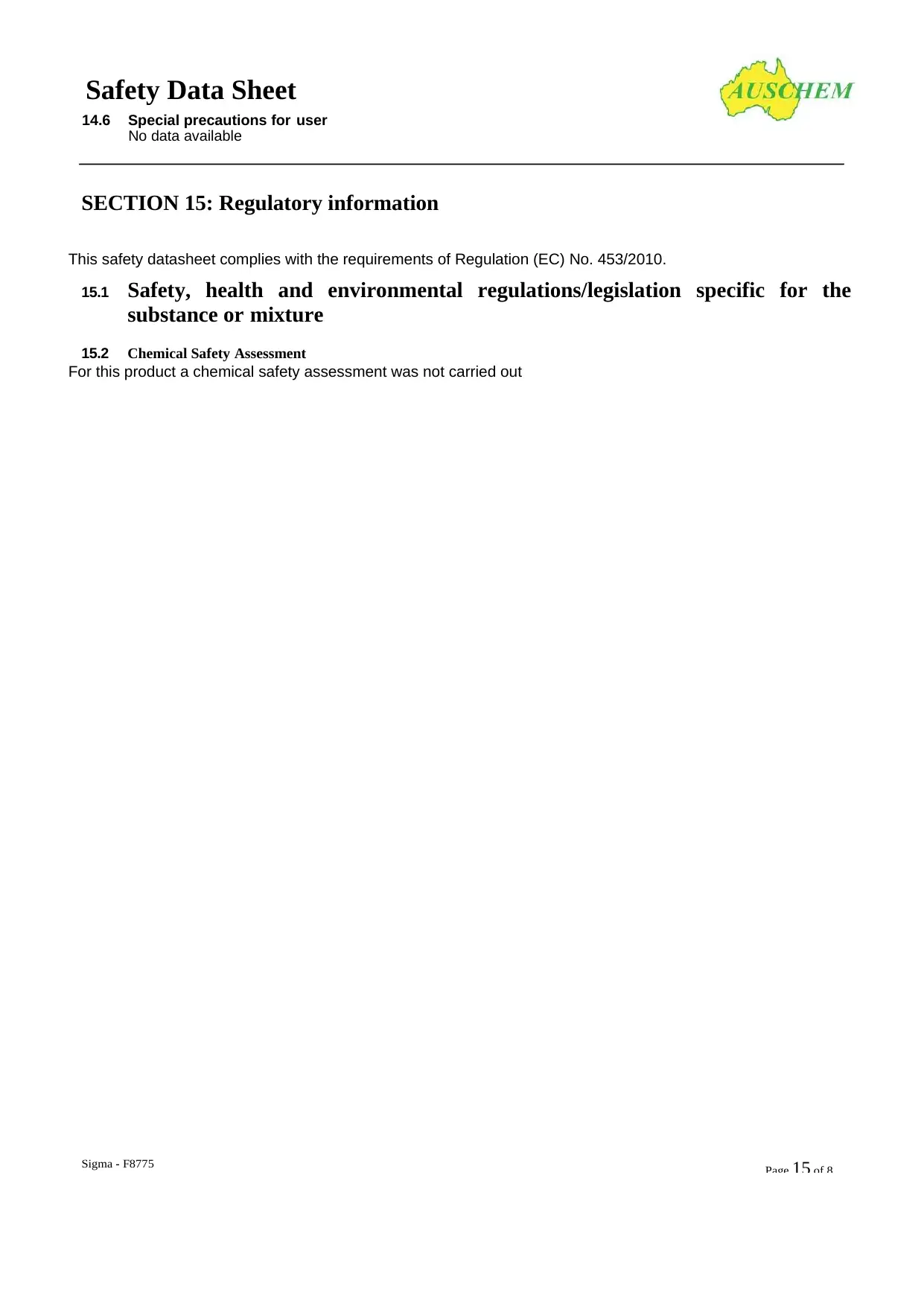
Safety Data Sheet
Page 15 of 8
Sigma - F8775
14.6 Special precautions for user
No data available
SECTION 15: Regulatory information
This safety datasheet complies with the requirements of Regulation (EC) No. 453/2010.
15.1 Safety, health and environmental regulations/legislation specific for the
substance or mixture
15.2 Chemical Safety Assessment
For this product a chemical safety assessment was not carried out
Page 15 of 8
Sigma - F8775
14.6 Special precautions for user
No data available
SECTION 15: Regulatory information
This safety datasheet complies with the requirements of Regulation (EC) No. 453/2010.
15.1 Safety, health and environmental regulations/legislation specific for the
substance or mixture
15.2 Chemical Safety Assessment
For this product a chemical safety assessment was not carried out
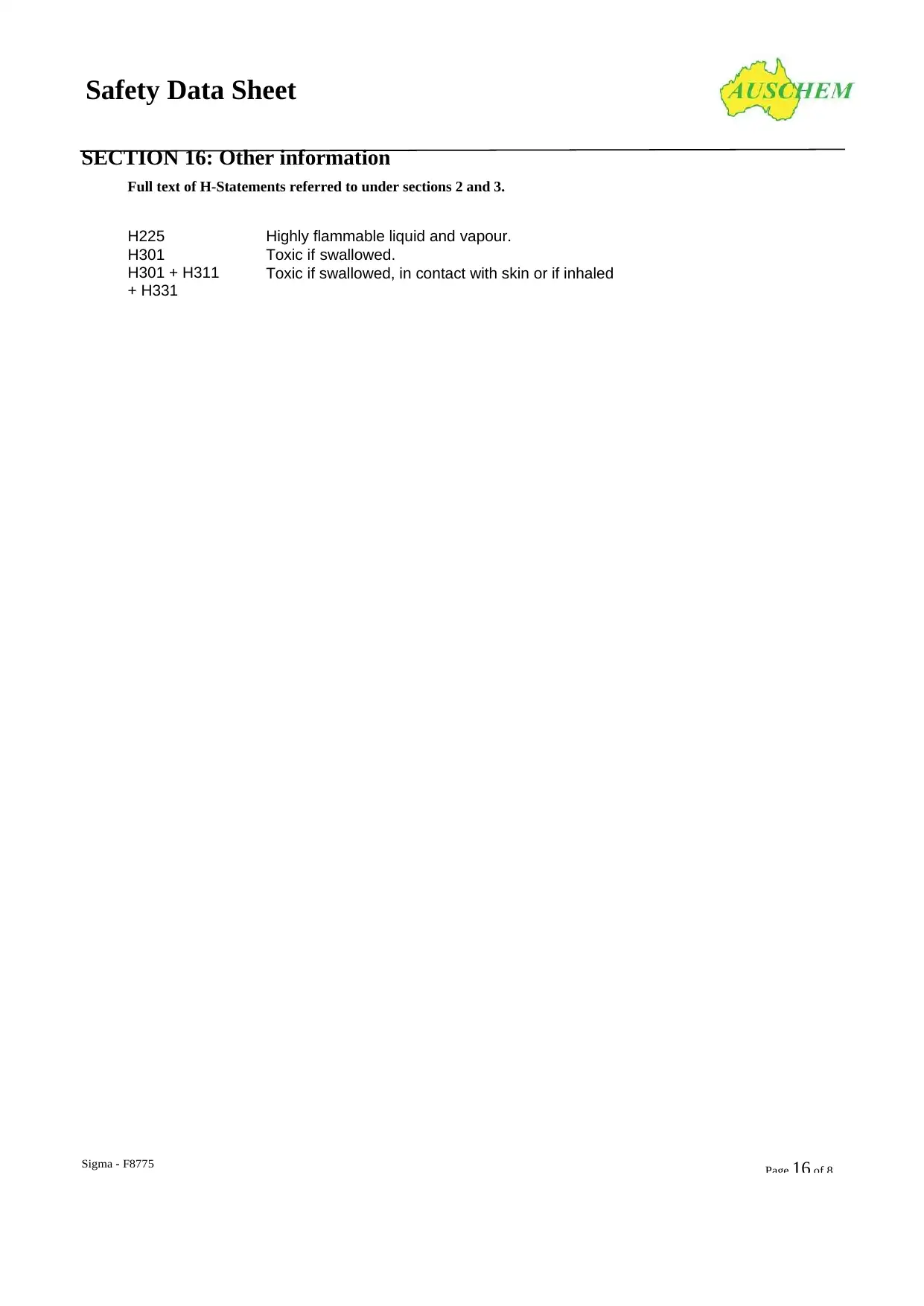
Safety Data Sheet
Page 16 of 8
Sigma - F8775
SECTION 16: Other information
Full text of H-Statements referred to under sections 2 and 3.
H225 Highly flammable liquid and vapour.
H301 Toxic if swallowed.
H301 + H311
+ H331
Toxic if swallowed, in contact with skin or if inhaled
Page 16 of 8
Sigma - F8775
SECTION 16: Other information
Full text of H-Statements referred to under sections 2 and 3.
H225 Highly flammable liquid and vapour.
H301 Toxic if swallowed.
H301 + H311
+ H331
Toxic if swallowed, in contact with skin or if inhaled
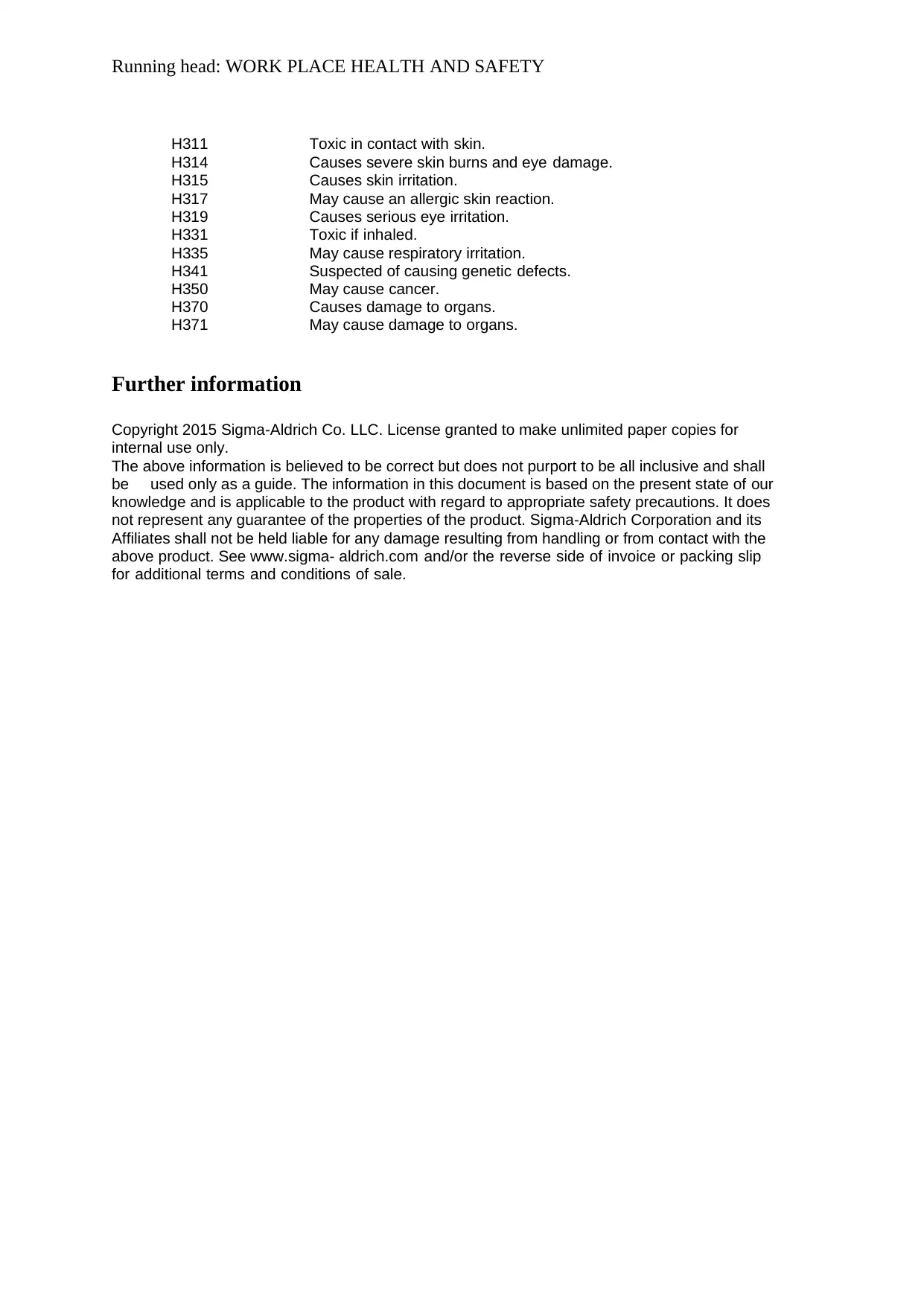
Running head: WORK PLACE HEALTH AND SAFETY
H311 Toxic in contact with skin.
H314 Causes severe skin burns and eye damage.
H315 Causes skin irritation.
H317 May cause an allergic skin reaction.
H319 Causes serious eye irritation.
H331 Toxic if inhaled.
H335 May cause respiratory irritation.
H341 Suspected of causing genetic defects.
H350 May cause cancer.
H370 Causes damage to organs.
H371 May cause damage to organs.
Further information
Copyright 2015 Sigma-Aldrich Co. LLC. License granted to make unlimited paper copies for
internal use only.
The above information is believed to be correct but does not purport to be all inclusive and shall
be used only as a guide. The information in this document is based on the present state of our
knowledge and is applicable to the product with regard to appropriate safety precautions. It does
not represent any guarantee of the properties of the product. Sigma-Aldrich Corporation and its
Affiliates shall not be held liable for any damage resulting from handling or from contact with the
above product. See www.sigma- aldrich.com and/or the reverse side of invoice or packing slip
for additional terms and conditions of sale.
H311 Toxic in contact with skin.
H314 Causes severe skin burns and eye damage.
H315 Causes skin irritation.
H317 May cause an allergic skin reaction.
H319 Causes serious eye irritation.
H331 Toxic if inhaled.
H335 May cause respiratory irritation.
H341 Suspected of causing genetic defects.
H350 May cause cancer.
H370 Causes damage to organs.
H371 May cause damage to organs.
Further information
Copyright 2015 Sigma-Aldrich Co. LLC. License granted to make unlimited paper copies for
internal use only.
The above information is believed to be correct but does not purport to be all inclusive and shall
be used only as a guide. The information in this document is based on the present state of our
knowledge and is applicable to the product with regard to appropriate safety precautions. It does
not represent any guarantee of the properties of the product. Sigma-Aldrich Corporation and its
Affiliates shall not be held liable for any damage resulting from handling or from contact with the
above product. See www.sigma- aldrich.com and/or the reverse side of invoice or packing slip
for additional terms and conditions of sale.
1 out of 43
Related Documents
Your All-in-One AI-Powered Toolkit for Academic Success.
+13062052269
info@desklib.com
Available 24*7 on WhatsApp / Email
![[object Object]](/_next/static/media/star-bottom.7253800d.svg)
Unlock your academic potential
© 2024 | Zucol Services PVT LTD | All rights reserved.





